Table of Contents
After spending four incredible and very short days in beautiful Chiang Mai in Northern Thailand, it was time to discover a new destination. Our plan was to take a trip from Chiang Mai to Chiang Rai and explore the sites along the way. It sounded like an adventure we just couldn’t miss, especially since the two cities are only about 150 miles apart. Admittedly, this is not straight forward highway driving, so it takes almost 4 hours to get there. This is why we decided to make it a one-way trip and stay in Chiang Rai for the night. Then we flew from there to our next Thailand destination, Phuket. It was not only cheaper than flying out of Chiang Mai, but also we visited another city!
Where to Stay
While in Chiang Mai, we stayed at Chada Mantra Hotel, a nice place in a great location with a fantastic restaurant in the lobby. If you don’t mind sleeping on a firm bed, you will love it here! In Chiang Rai, we booked a night at The Garage Guesthouse. It wasn’t in a central location, but the staff was lovely and the rooms were comfortable and clean. Not to mention, the price was great! To see other highly rated options from Booking.com in Chiang Mai, click HERE, and for Chiang Rai, go HERE. We have filtered out the lower-rated listings for you! Booking.com is our favorite website for finding great places to stay all over the world! They offers amazing flexibility on payments and cancellations!
The Journey from Chiang Mai to Chiang Rai
On the morning we had arranged to travel from Chiang Mai to Chiang Rai, we got up early and enjoyed one final continental breakfast at our lovely hotel, Chada Mantra. Then, around 7:30 am, our ride arrived, and the four of us set off on this new adventure.
Travel Hub Chiang Mai
I have to mention that for this particular trip, we booked a custom tour with Travel Hub Chiang Mai, and they were hands down amazing! We traveled in a comfortable van with an experienced driver and a TAT (Tourism Authority of Thailand) certified tour guide. All this to ourselves!
To create this custom tour, I did some research in advance and requested the attractions we were interested to see. Travel Hub Chiang Mai planned it all out and arranged a tour guide for us, which was fantastic! In fact, this whole trip went so smoothly that we would gladly repeat it again without changing a thing! Even the weather and the kids cooperated, no rain, no injuries, and not much complaining!
On the Road
As soon as we left, our guide for the day, the friendly Ms. Kwan, gave us an overview of the planned itinerary. After chatting with her for a bit, all of us sat back, relaxed, and snoozed for some time. We’d had several very exciting and extremely full days in Chiang Mai. As a result, the lack of a good night’s sleep was definitely catching up with us.
Even while dosing off, I managed to see that the drive from Chiang Mai to Chiang Rai was quite beautiful, passing near lush rolling hills along the way. We did encounter some road construction at one point, which slowed us down a little, but that in no way affected our plans or naps.
Mae Kha Jan (Mae Kachan) Hot Springs
About an hour and a half into the drive from Chiang Mai to Chiang Rai, we made our first stop at Mae Kha Jan Hot Springs (also spelled Mae Kachan). This was a place I knew nothing about and had not specifically requested to visit, so it came as a nice unexpected surprise.
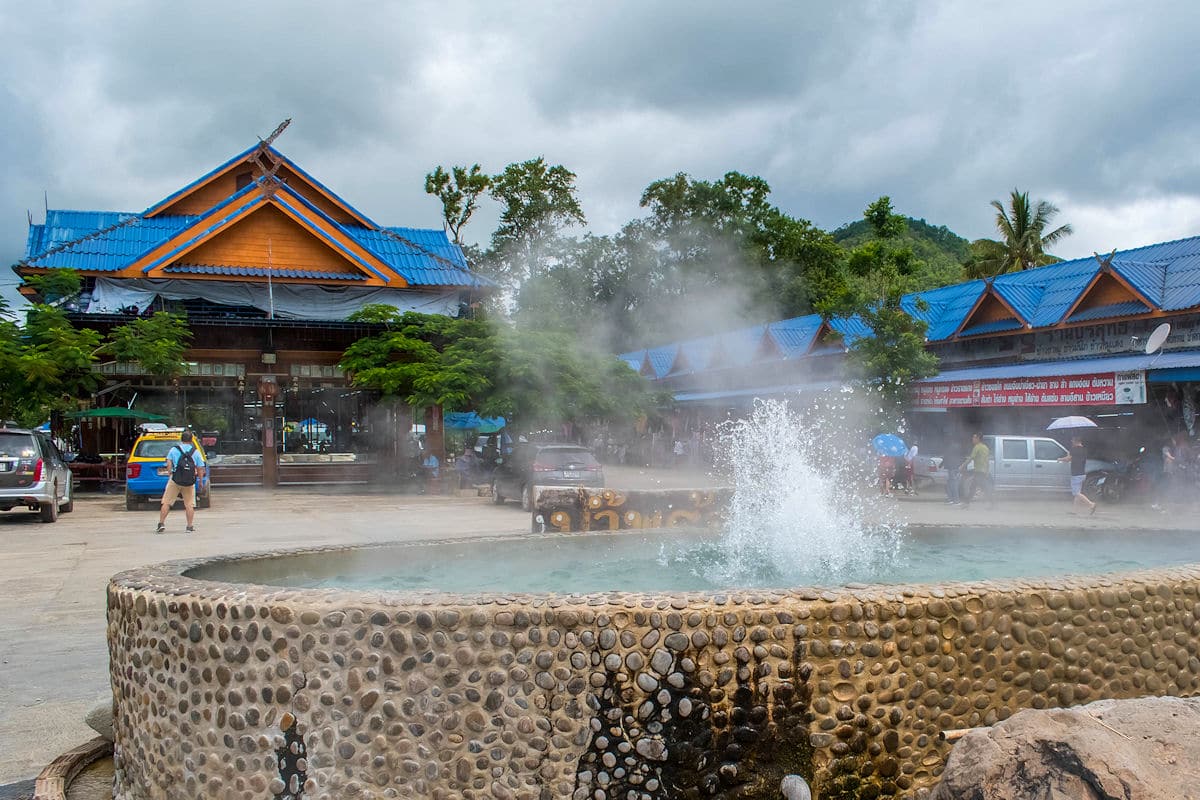
Mae Kachan Hot Springs in Northern Thailand
A Fun, Short Stop
Mae Kachan is basically a large parking area, filled with hawker food stalls, souvenir shops, and several hot springs, some hotter than others. Visitors sometimes describe it as “a tourist trap,” but we didn’t necessarily feel this way. Actually, all of us rather enjoyed this short stop. Not only did we get a chance to stretch our legs and use the restrooms, but also we got to dip our feet in one of the hot springs. Well, in reality, it was more of an attempt to dip our feet, because the water was really hot…Nevertheless, it was fun!

Trying to dip our feet at Mae Kachan Hot Springs
Delicious Food
While at Mae Kachan, we also tasted delicious chicken sauté, locally grown baby pineapples, and I got to boil some quail eggs in one of the hot springs. In fact, this one was so hot that it bubbled and splashed up from time to time like a small geyser. The eggs came in a small wicker basket, which I hooked onto a long stick. Then I lowered the basket into the steaming water and waited for three minutes. That’s all it took to get some fresh, hard-boiled, quail eggs.

Here I am, boiling a few quail eggs
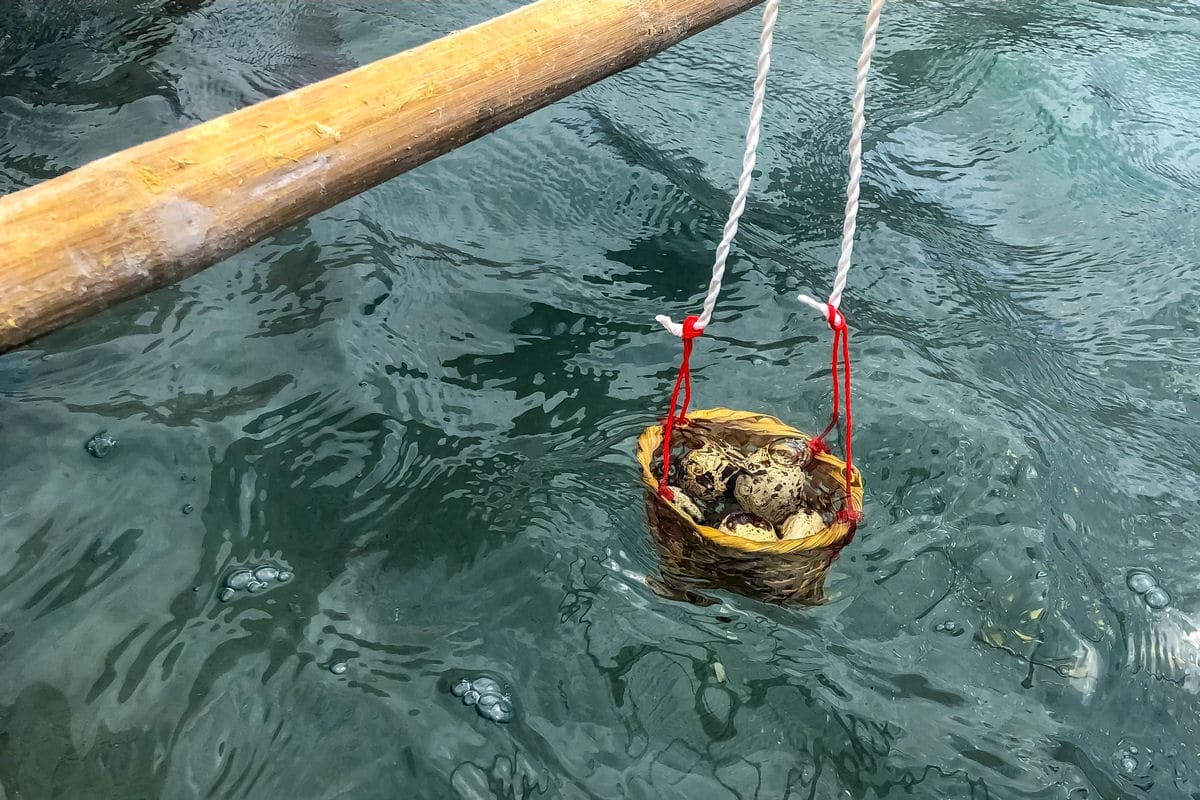
The quail eggs up close
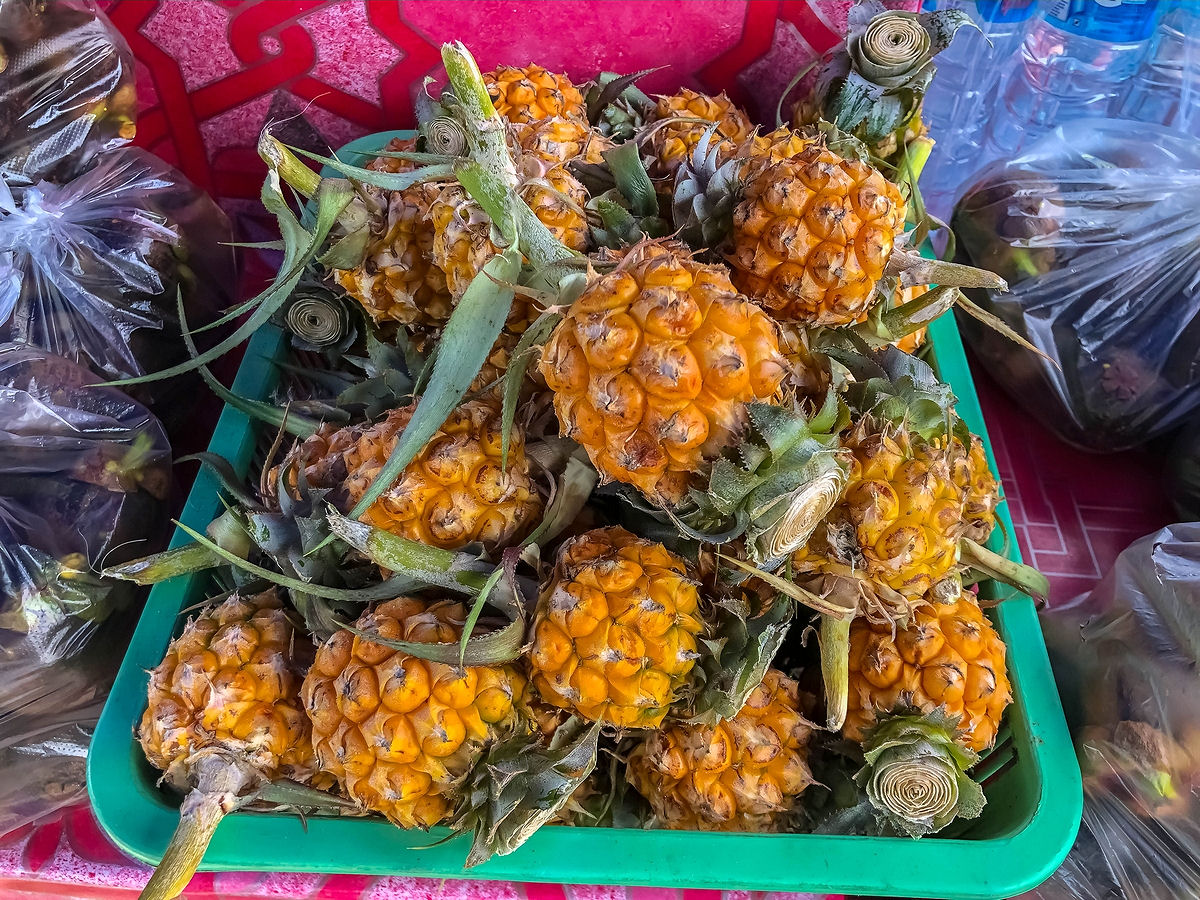
Baby pineapples at a hawker stand at Mae Kachan Hot Springs
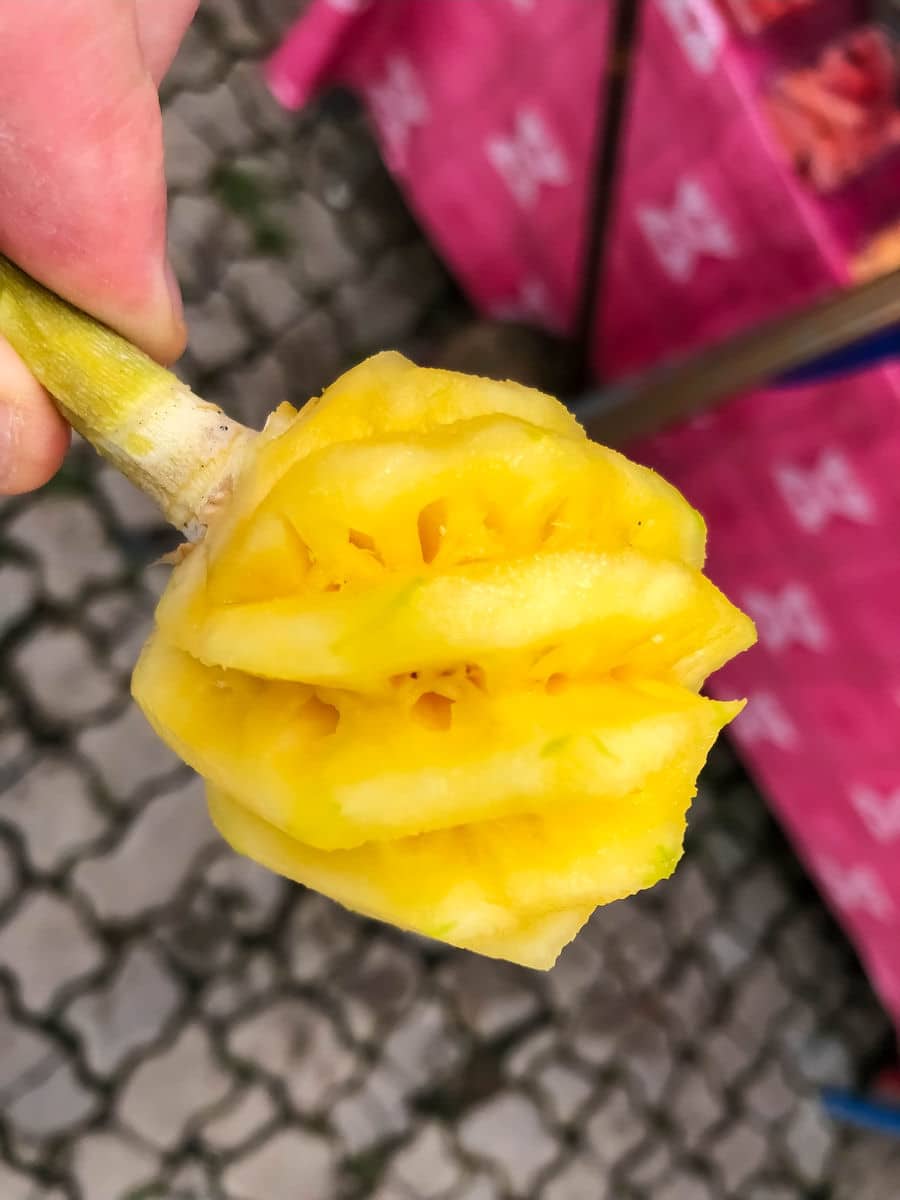
Eating a delicious baby pineapple at Mae Kachan Hot Springs
Souvenirs
Browsing the souvenir stands at Mae Kachan was also a neat experience. I found beautiful jade Buddha statues, elephant figurines, and bracelets made of genuine elephant hair. I was very tempted to get myself one of those bracelets, but I wasn’t sure about the ethical aspects of such a purchase. Not to mention, the bracelets were rather expensive.
Wat Rong Khun, “The White Temple”
After looking around for a while longer, we got back to the van and continued our Chiang Mai to Chiang Rai adventure. A little over an hour and a half later we happily arrived to Wat Rong Khun, better known among tourists as “The White Temple.” I had seen this ethereal creation in pictures before, yet the real thing completely blew me away! The intricate details covering every inch of the temple were stunning beyond words. Even our kids stopped to look and wowed in amazement…And let me tell you, visiting yet another temple definitely wasn’t at the top of their list of “fun things to do!”

The mandatory family photo in front of the White Temple
More on the White Temple
The White Temple turned out to be so intriguing that I actually dedicated an entire blog post to our experience there. (See the link below? I told’ya! ) Ms. Kwan, our guide, gave us very interesting information about the history and the artist of the temple, Chalermchai Kositpipat. She also decoded many of the hidden meanings behind all the ornaments and odd sculptures. And, trust me! There are plenty of odd and unexpected sights that are sure to catch you by surprise! If you have time to see only one place when traveling from Chiang Mai to Chiang Rai, be sure it’s The White Temple!
TIP: Always wear appropriate clothes when visiting Buddhist temples. Be sure to cover your knees and shoulders, which means mini skirts, shorts, and tank tops are out. Certain temples may not allow solid black pieces of clothing either, like The Grand Palace in Bangkok. Also, at The Grand Palace, covering the shoulders with a sarong is not acceptable. Visitors must wear an actual shirt with sleeves.
Wat Rong Suea Ten, “The Blue Temple”
We spent well over an hour walking around the White Temple and admiring the fascinating artworks throughout the grounds. It all ended with a delicious Thai lunch at a restaurant located across the street from the main entrance. As much as we didn’t want to leave this place, we knew we had to move on as there was a lot more to see on this Chiang Mai to Chiang Rai journey.
The next stop on our itinerary was another masterpiece of Buddhist art, Wat Rong Suea Ten, also known as the Blue Temple. We learned that this temple was designed by Putha Kabkaew, who was an apprentice of Chalermchai Kositpipat, the artist of the White Temple.
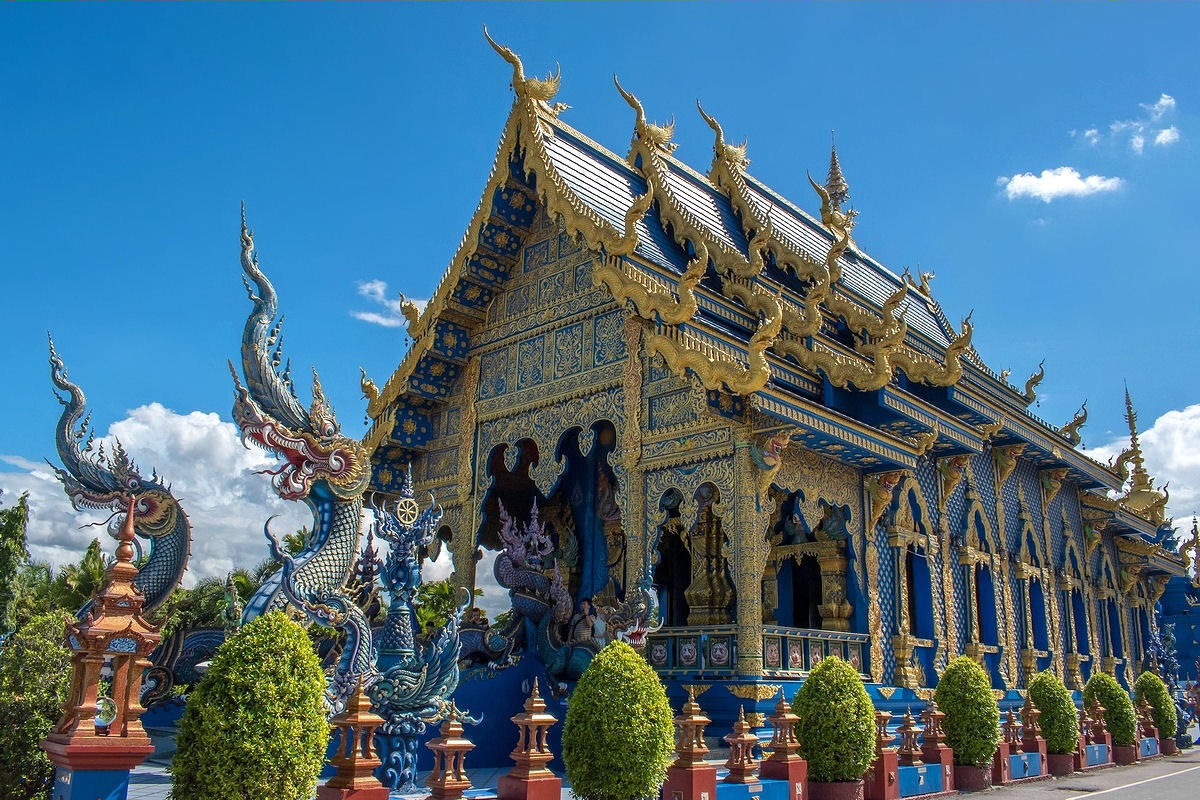
Wat Rong Suea Ten, “The Blue Temple” in Chiang Rai, Thailand
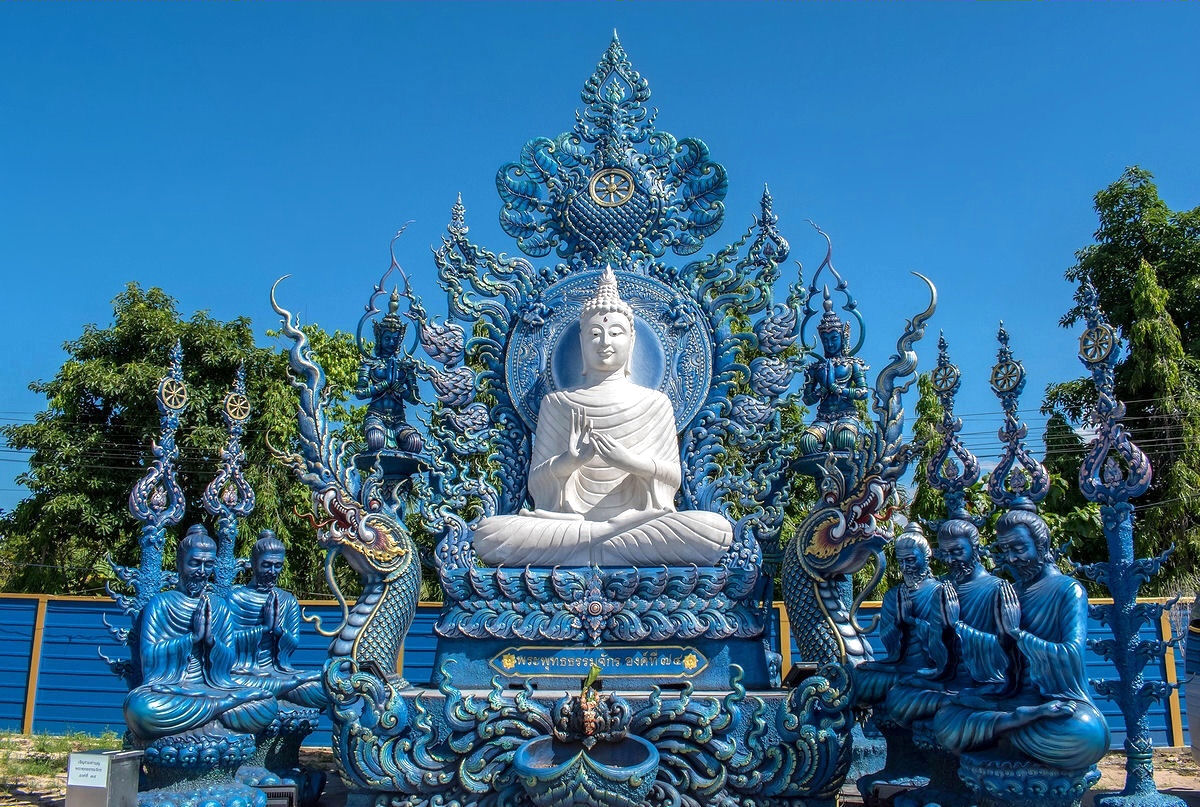
White Buddha statue, The Blue Temple in Chiang Rai, Thailand
The Exterior
As we arrived to Wat Rong Suea Ten, we were immediately taken by the bright blue color and golden ornaments decorating the exterior. On both sides of the stairs leading to the entrance, there were several incredible dragon-like serpents guarding the building.
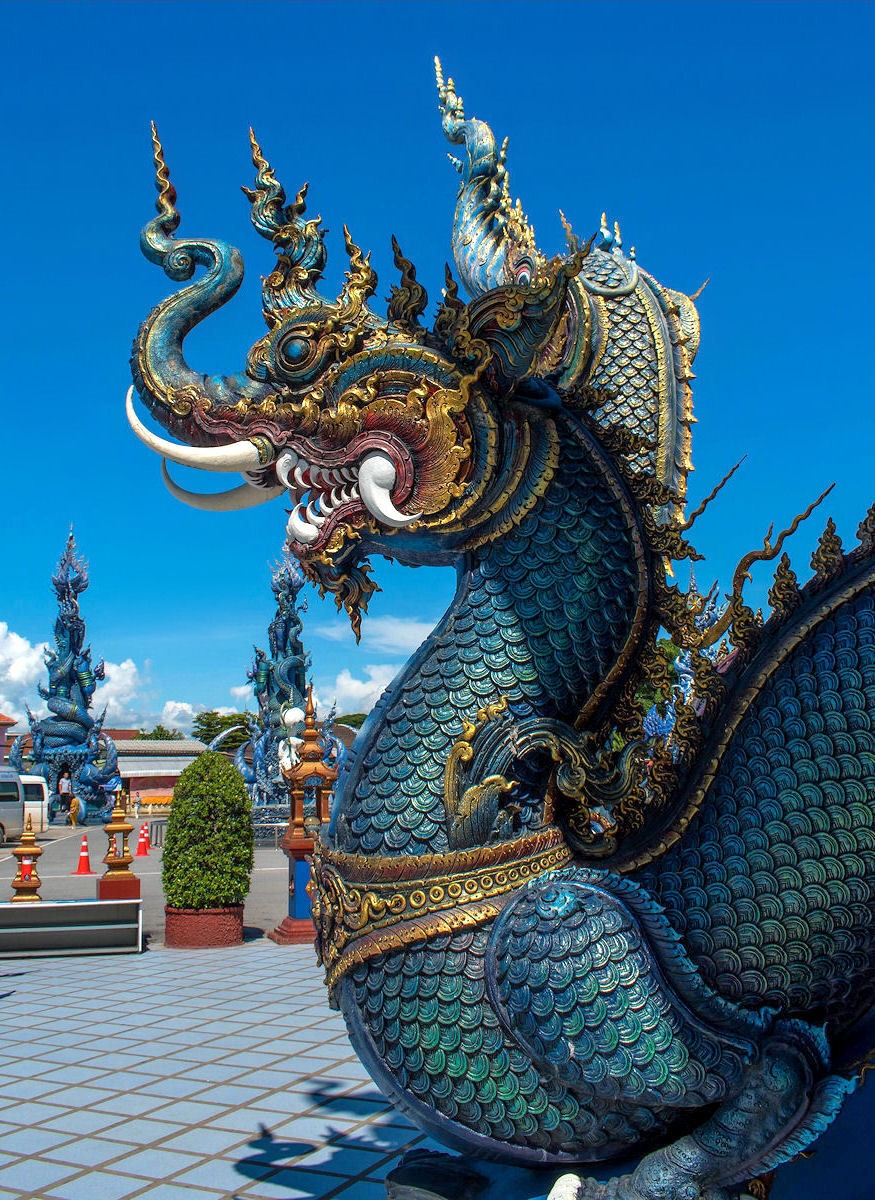
Dragon sculpture near the front of The Blue Temple in Chiang Rai
Before heading inside the Blue Temple, we had to make a quick bathroom stop, so Ms. Kwan showed us the way there. I mention this only because it was impressive how impeccably clean this bathroom was. In fact, we had to remove our shoes and put on slippers in order to go inside and use it! There was no toilet paper, but this didn’t bother us, as by this time, we had become quite proficient at using the bidet sprayers, which are so popular in this part of the world.
After our quick bathroom detour, we followed Ms. Kwan to the back of the Blue Temple, where we discovered a lovely statue of a standing white Buddha, as well as the impressive blue pagoda of the temple. (In case you didn’t know, temple pagodas are typically pointy structures used for storing and displaying valuable Buddhist artifacts. It’s generally not possible to go inside a pagoda, so visitors enjoy them from the outside.)
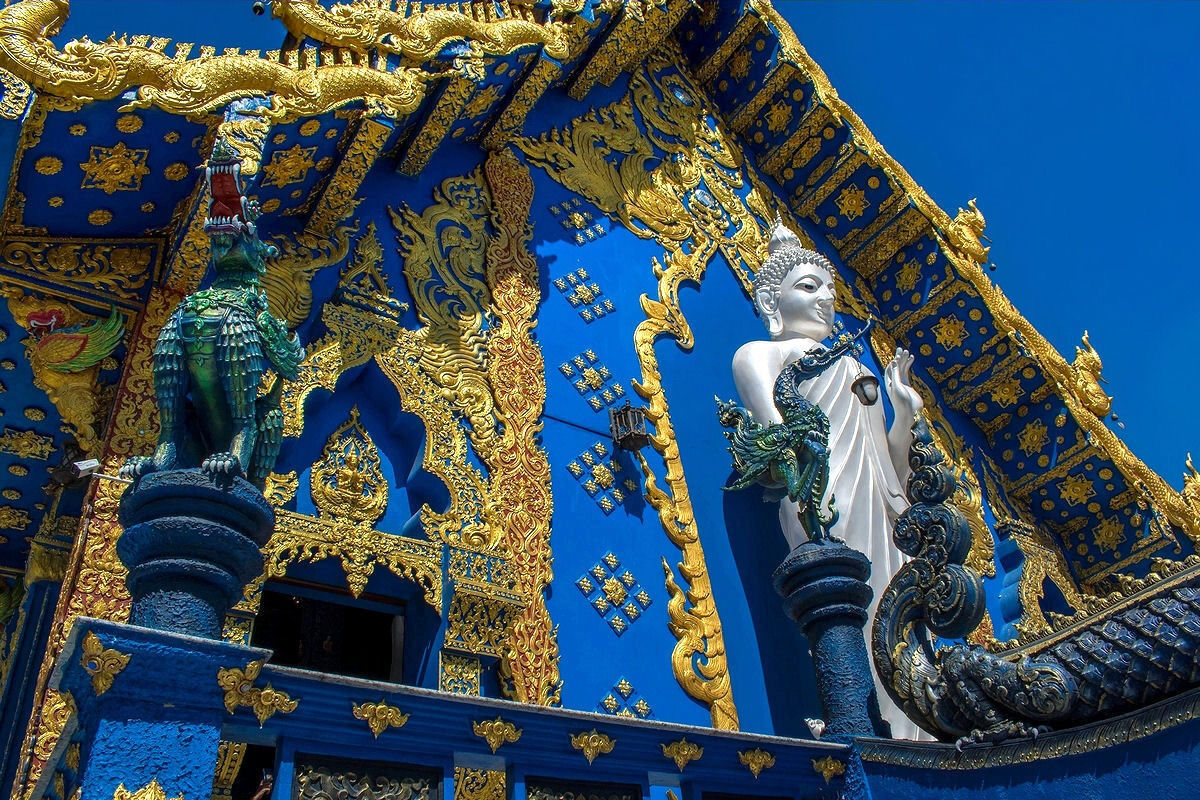
Coming around to the back of The Blue Temple
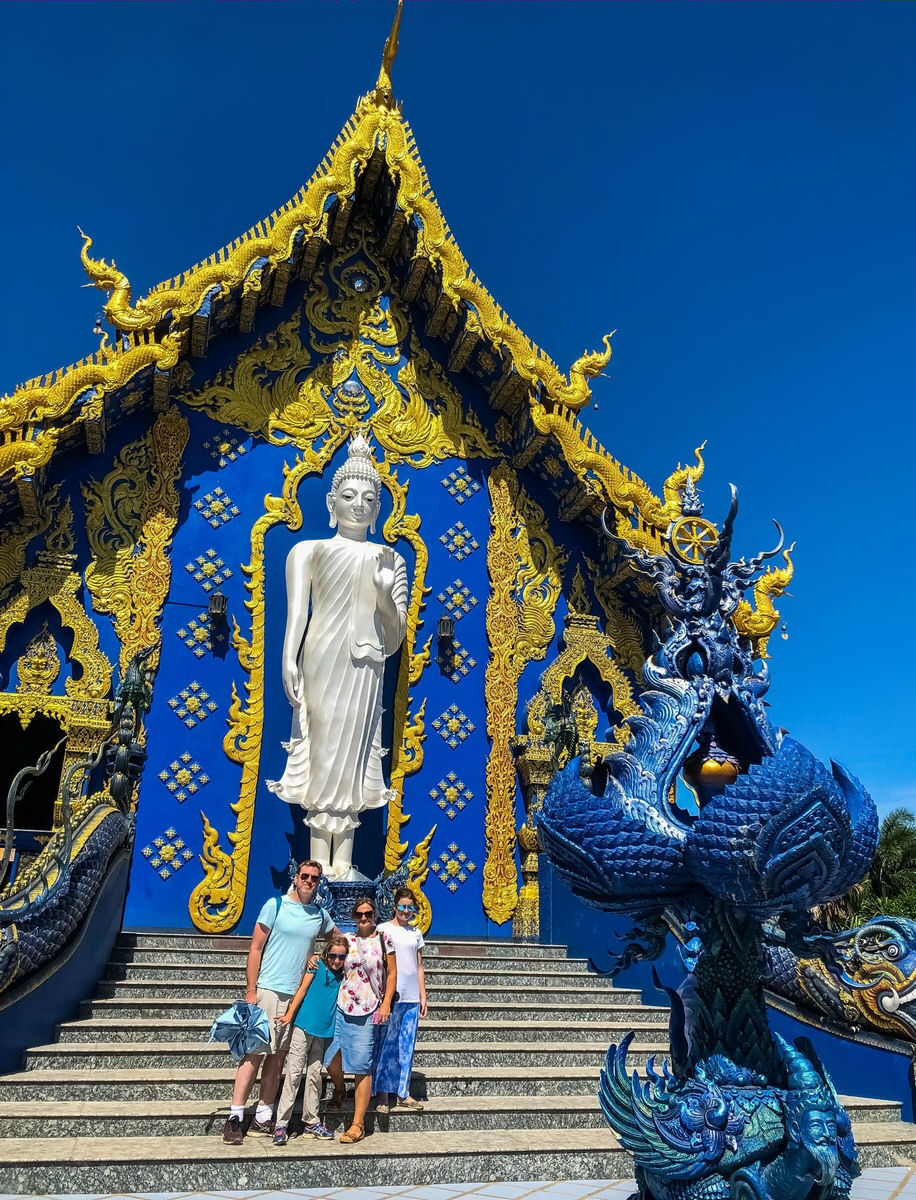
Family photo at the back of The Blue Temple in Chiang Rai, Thailand
The Interior
When we felt we had taken enough time to admire the Blue Temple from the outside, we headed towards the main entrance. As we removed our shoes and placed them with all the other visitors’ shoes at the front, hubby jokingly noted that he wouldn’t have any trouble finding his sneakers in this shoe mess. After all, he wears US men’s size 15, which is a phenomenon you’d hardly ever encounter in Asia! Let’s just say, his shoes stood out!
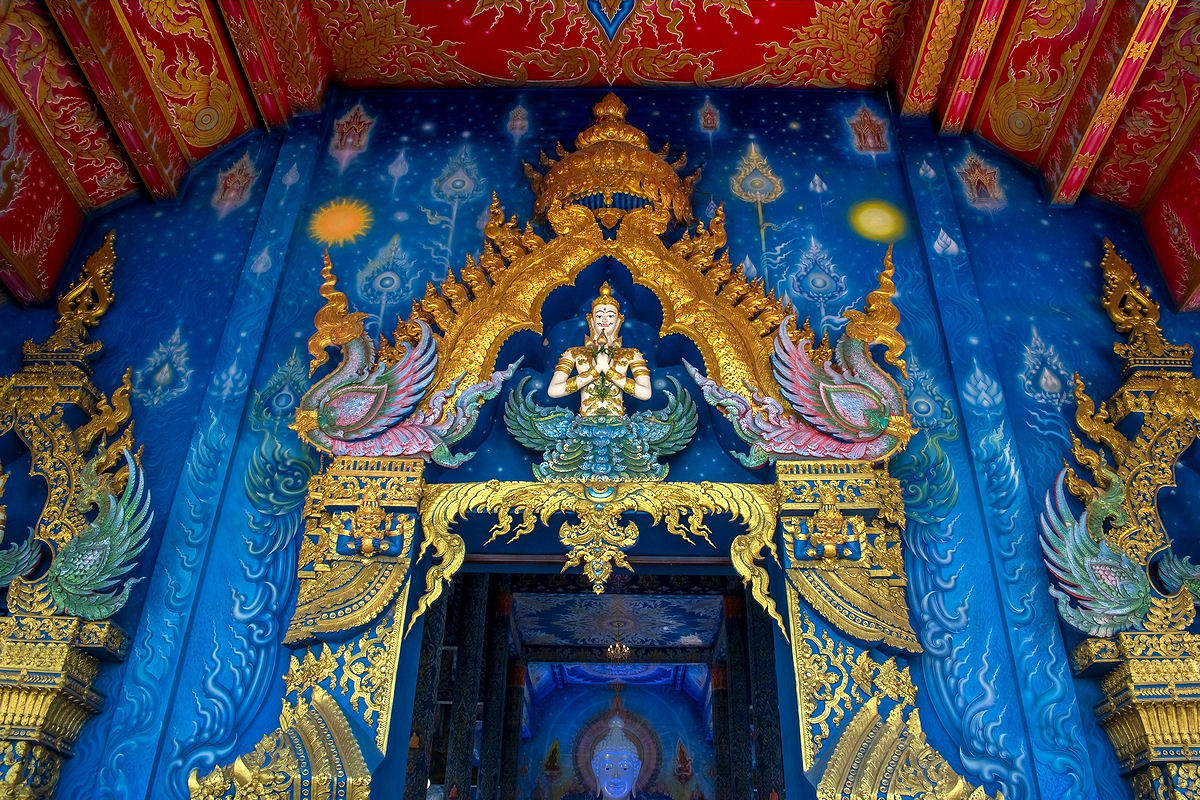
Beautiful art around the entrance of The Blue Temple
White Buddha Statue
We entered the Blue Temple and our eyes were immediately drawn to a giant white Buddha statue. The walls and the ceiling were covered in detailed paintings against a beautiful blue background. It was truly a majestic sight! As I turned around to look back at the entrance, I noticed that just like at the White Temple, there was a large image of a demonic creature above the door. On top of it, sitting calmly in a mediation pose was a painting of Buddha. The style of the art here very much resembled the art inside the White Temple. Clearly, the artist Putha Kabkaew was inspired by his renowned teacher and the artist behind the White Temple, Chalermchai Kositpipat. Since taking photos was allowed here, we managed to capture some of this intricate art with our trusty electronics.
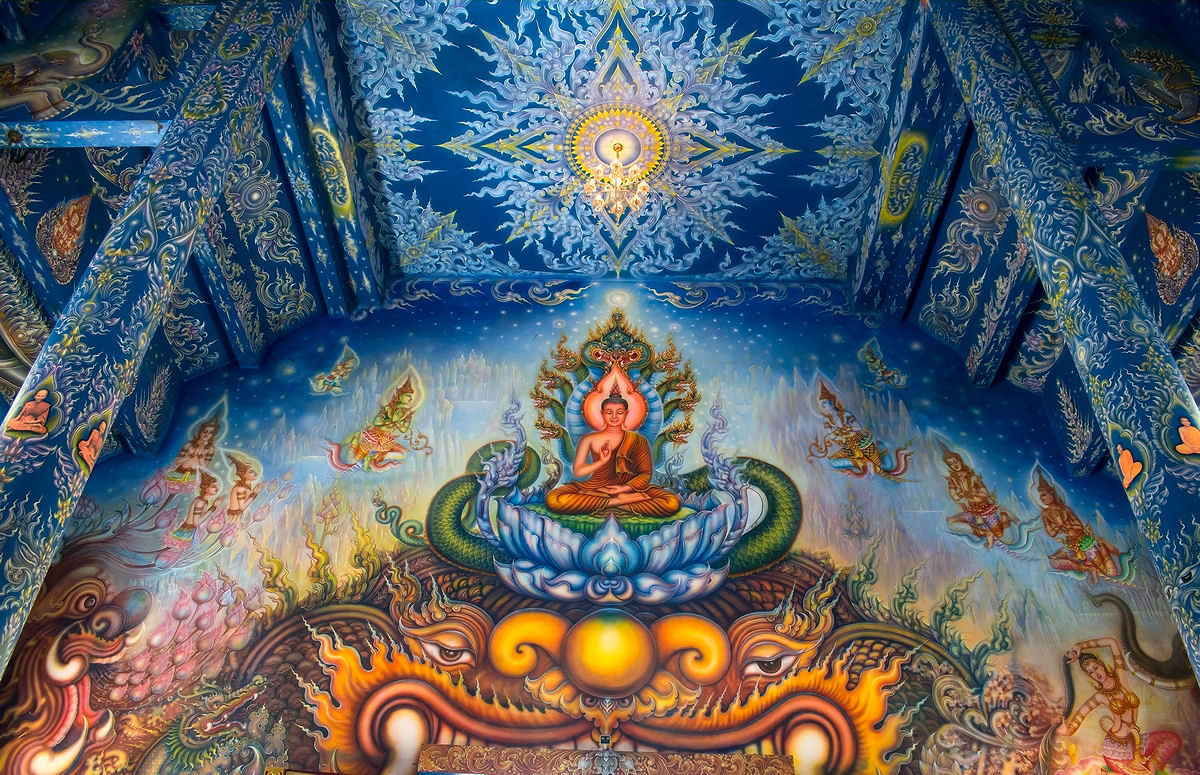
Art inside The Blue Temple above the entrance
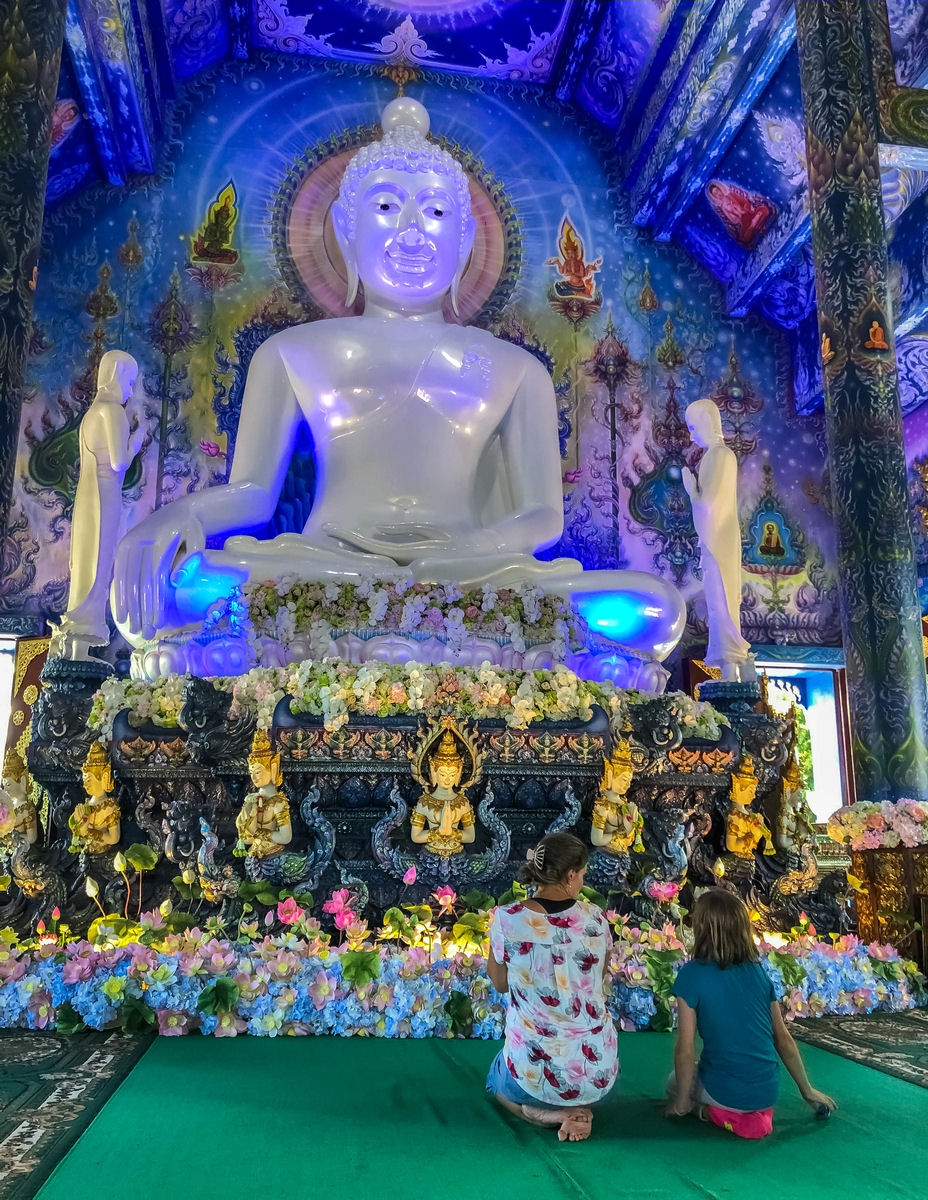
Large Buddha statue inside The Blue Temple in Chiang Rai, Thailand
Baan Dam Museum, “The Black House”
After enjoying the peaceful atmosphere inside the Blue Temple for a while longer, we were ready to continue our explorations. Ms.Kwan gave a quick introduction to our next attraction, the Baan Dam Museum, known as “The Black House.” You may hear that some visitors also call it “The Black Temple,” but this is incorrect, since the place was never a temple. Rather, it was the home of the late Thawan Duchanee, another renowned local Thai artist. We learned that there are over 40 different structures on the property, most of which are painted black.
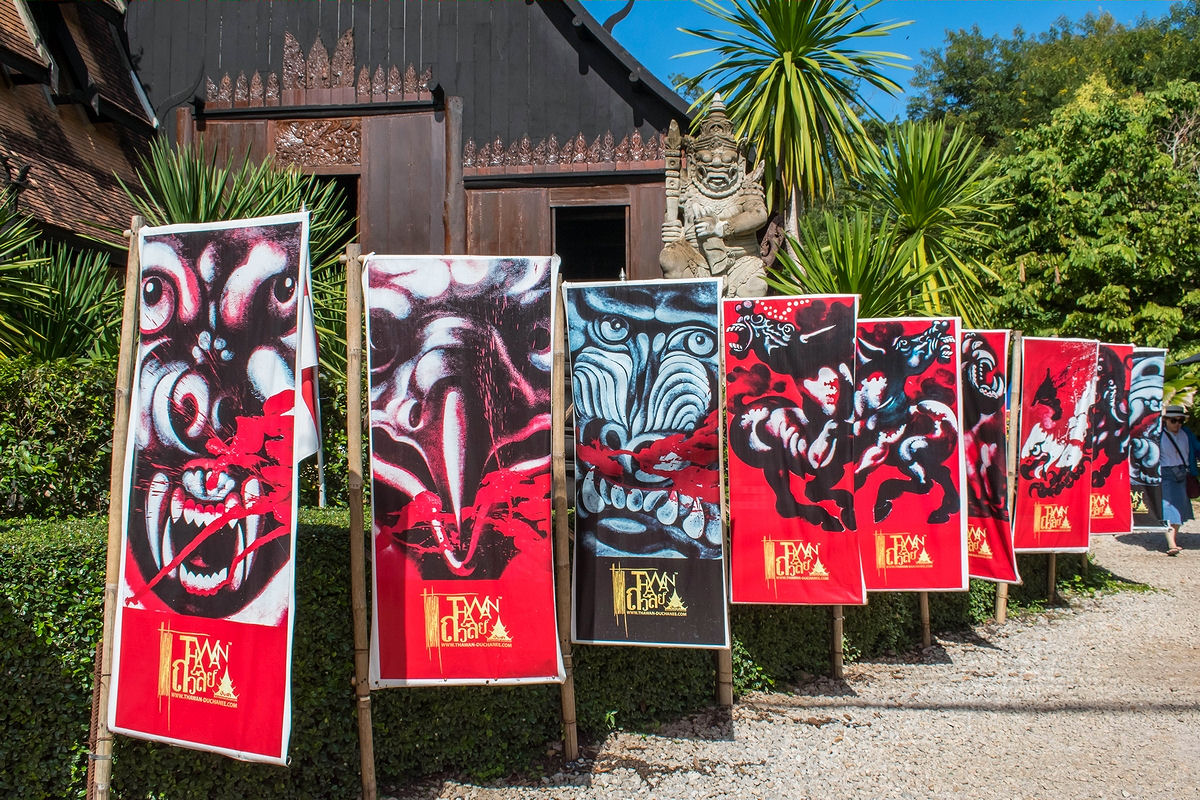
Thawan Duchanee art near the entrance of Baan Dam Museum, “The Black House” in Chiang Rai
The Artist’s Style
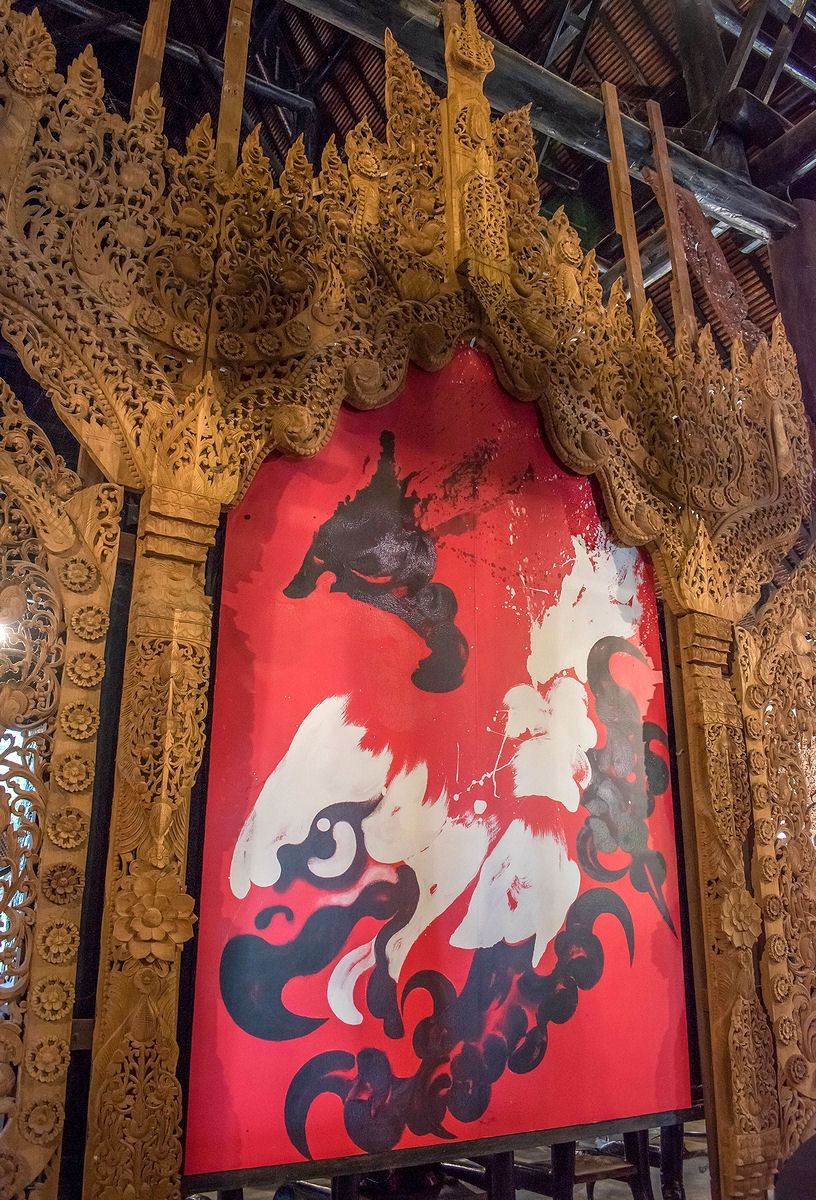
Wood carving and painting by Thawan Duchanee
Our tour of the Black House started with a quick stop at the museum shop. Since it was located near the entrance, we thought it might be interesting to check it out first. Looking at the various prints and paintings inside, we got first impressions of Thawan Duchanee’s artistic style. It was very different from what we had seen at the White Temple and the Blue Temple. There weren’t as many lacy details, and the artworks were primarily black and white, combined mostly with red. We also learned that Thawan Duchanee was a very talented wood carver, and during his lifetime he created some truly intricate murals.
Baan Dam Interior Decor
Once we entered the Baan Dam Museum grounds, we were truly stunned by what we discovered. It turned out, the artist was not only renowned for his art, but also for his bizarre collection of animal bones, horns, and skins. Inside the main living/dining hall, located right near the entrance, the atmosphere felt rather Gothic. There were incredible wood murals along with dark furniture decorated with water buffalo horns and alligator skins. We found these elements throughout all the structures we visited. Essentially, the whole place was filled with wood carvings, drums, baskets, animal bones, horns, skins, and skulls (including an elephant skull).
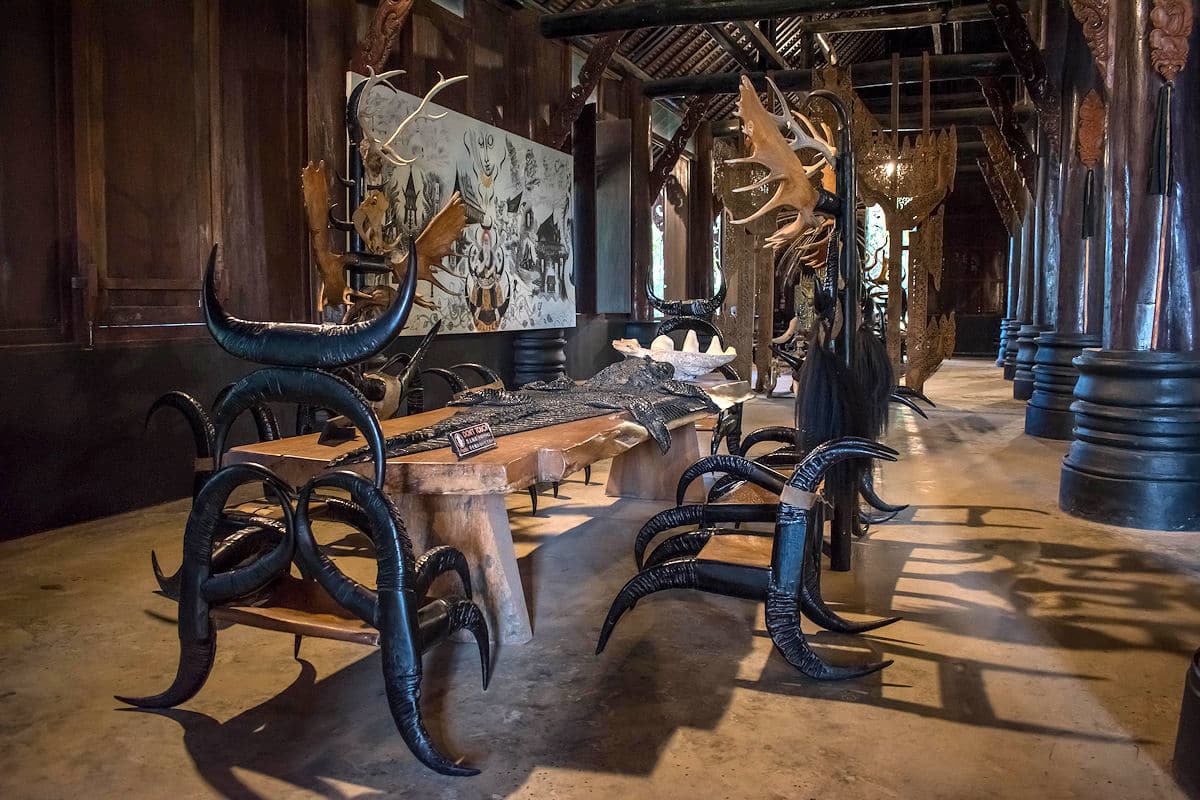
The main dining hall at The Black House in Chiang Rai
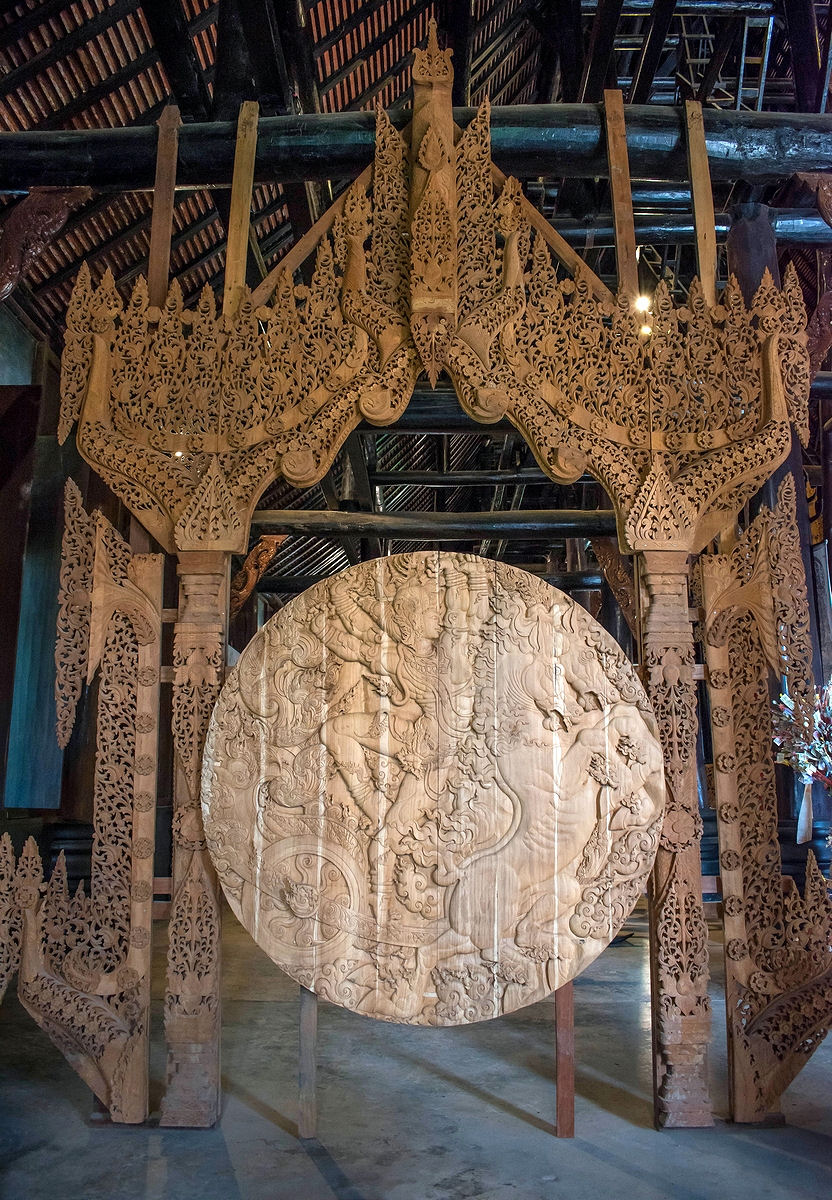
Another wood carving by Thawan Duchanee

A sculpture of a golden chicken with a portrait of the artist
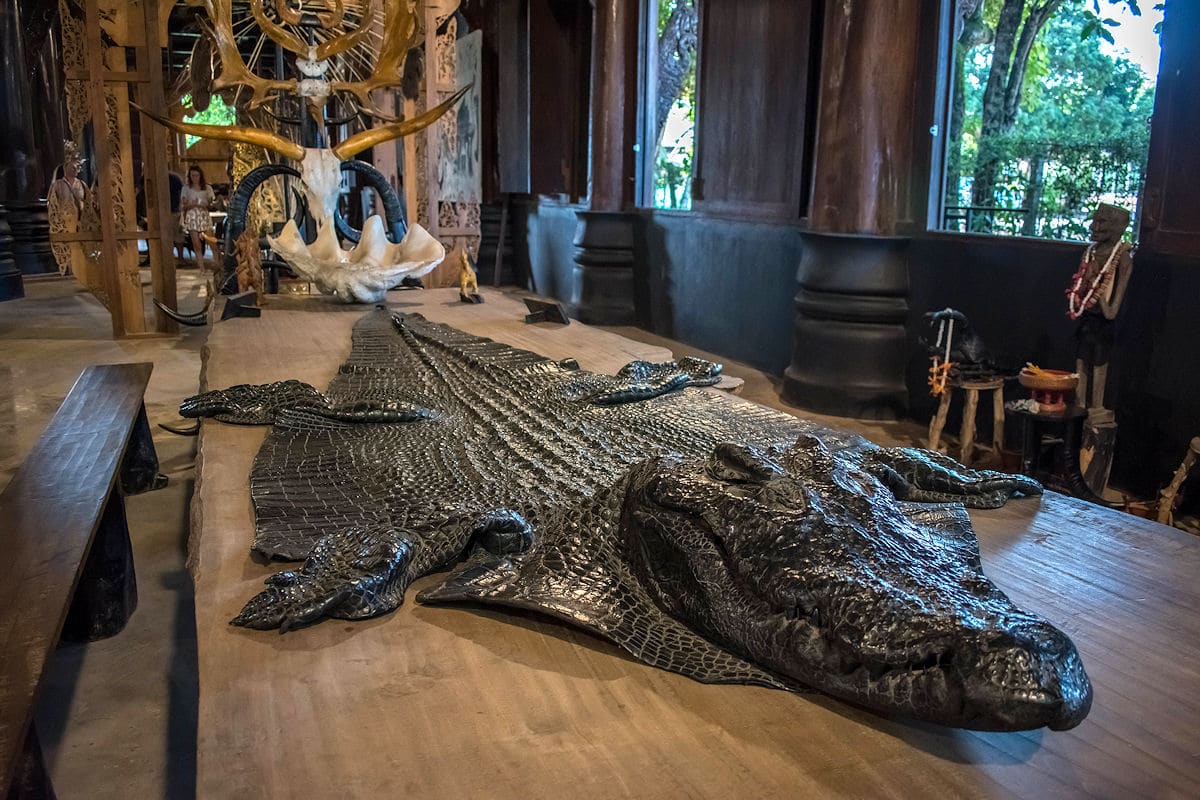
An alligator skin decorating one of the tables
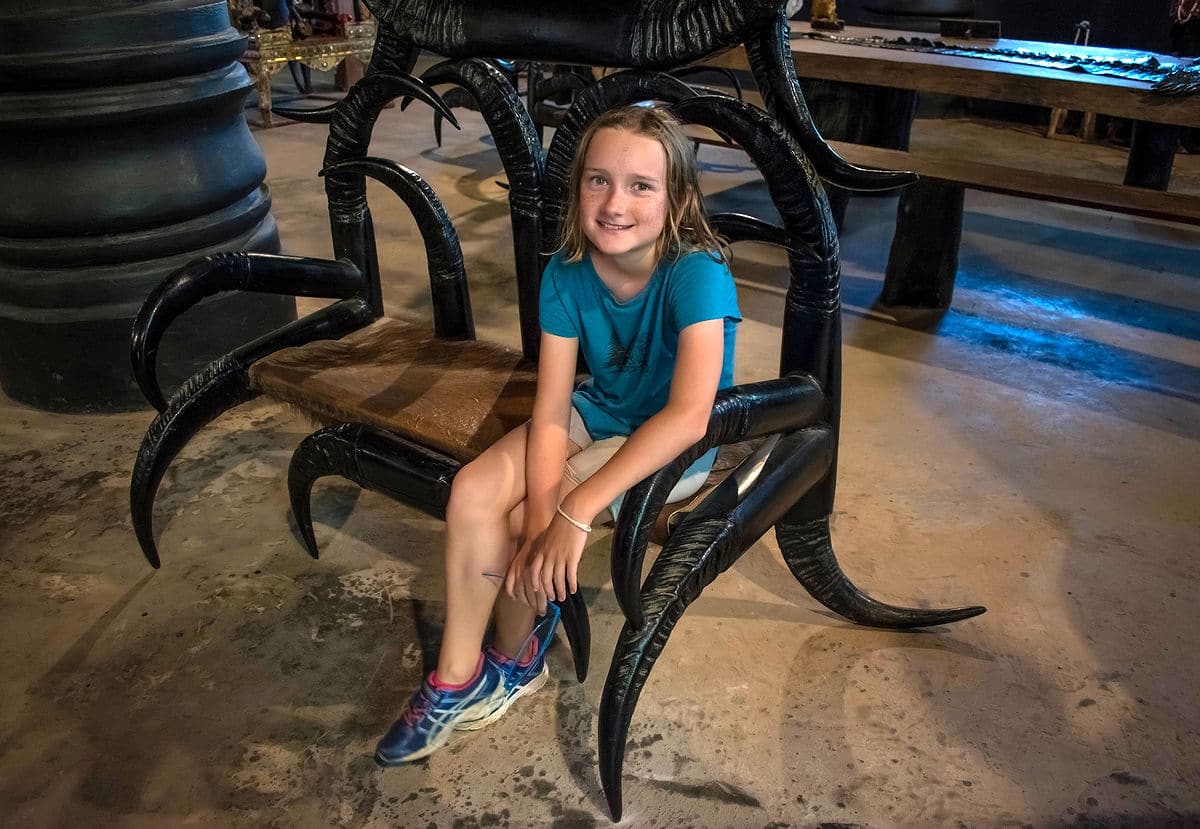
Dani resting on a bench made of water buffalo horns
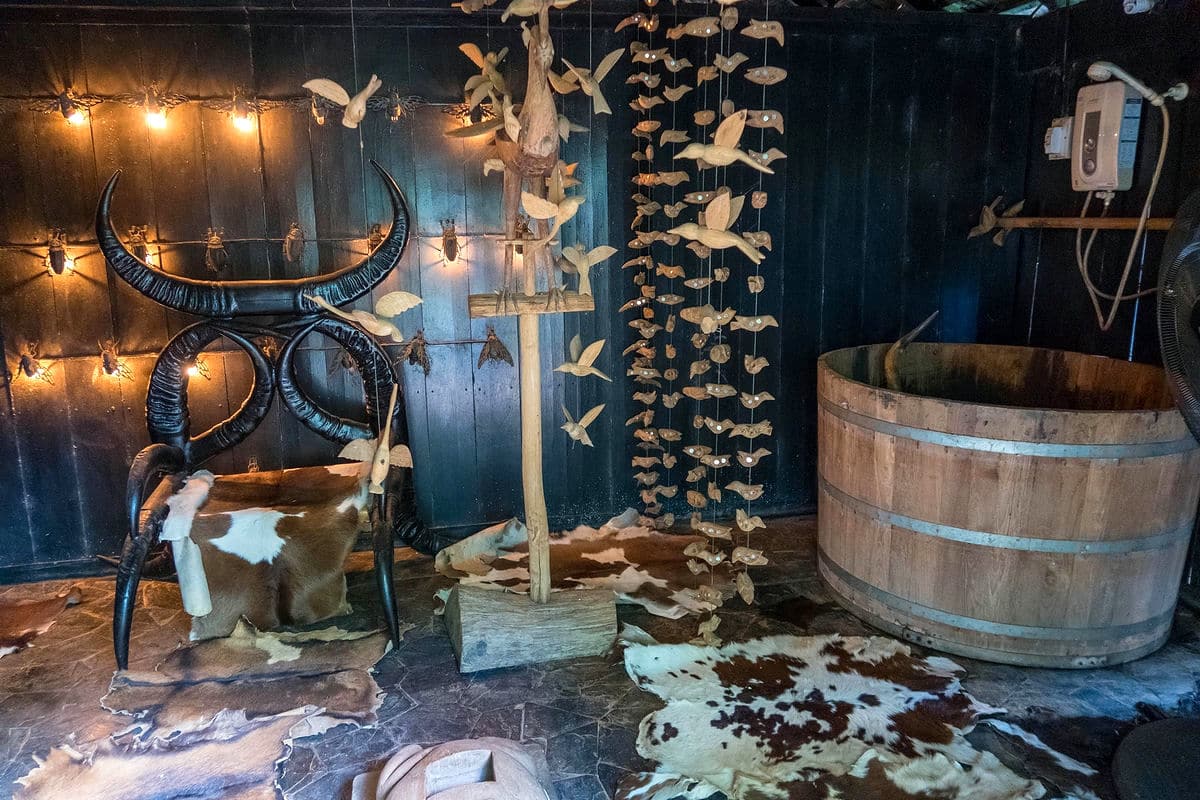
Bathroom at The Black House in Chiang Rai
Around the Museum Grounds
The various structures within the property were rather unique, too. While most generally resembled the shape and style of Buddhist temples, there were some oddities, like a whale-shaped room and a couple of white domes. In the midst of all this, we met a couple of peacefully grazing water buffalo and a pair of free-roaming dogs. We rested for a few minutes at a nearby rock garden decorated with unusual large stones, then slowly headed towards the exit.
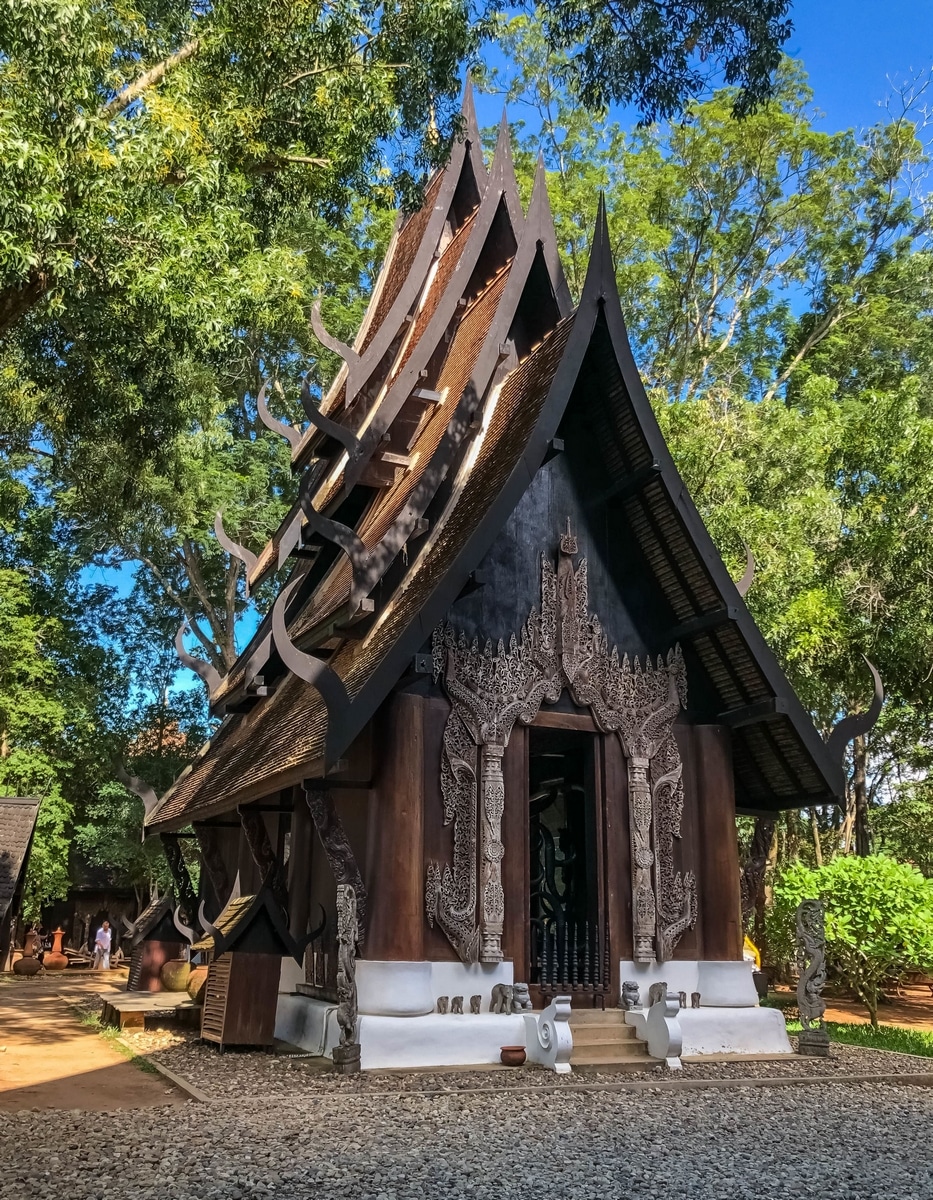
Small black building at Baan Dam Museum
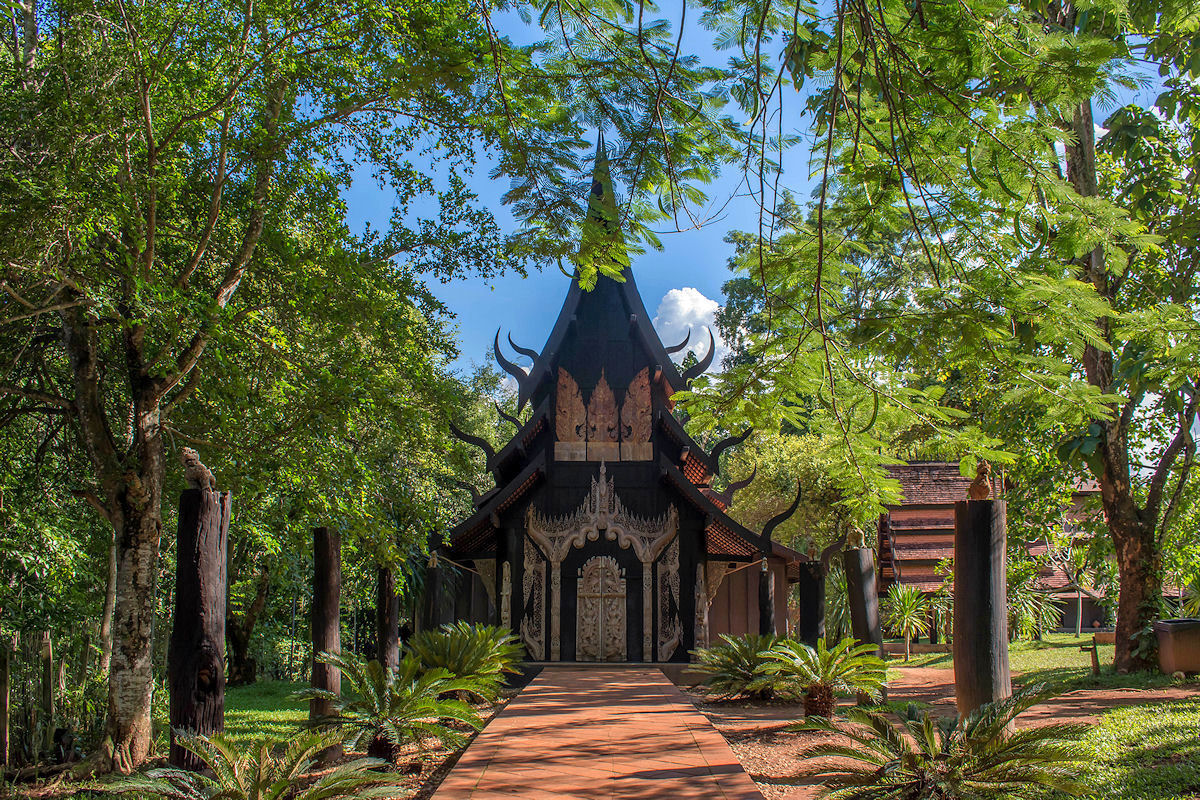
Another fascinating black building inside Baan Dam Museum in Chiang Rai with beautiful wood carvings
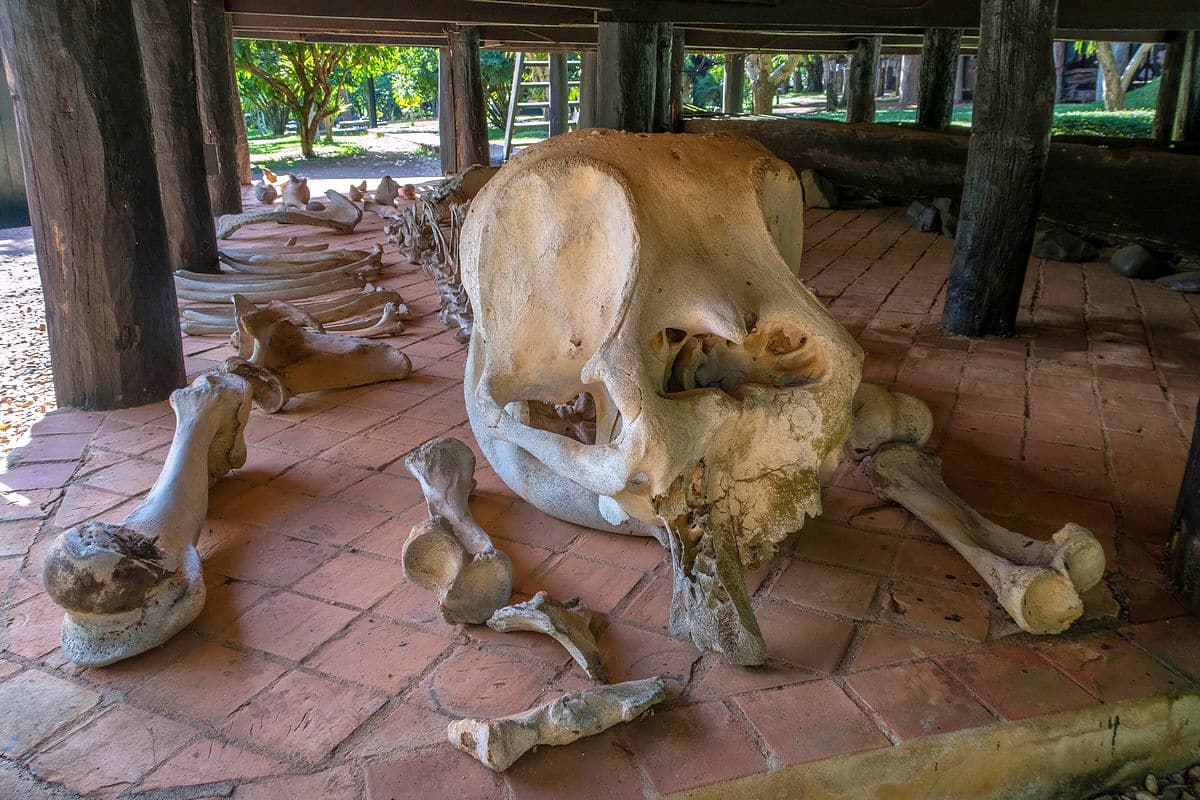
Elephant skull at The Black House
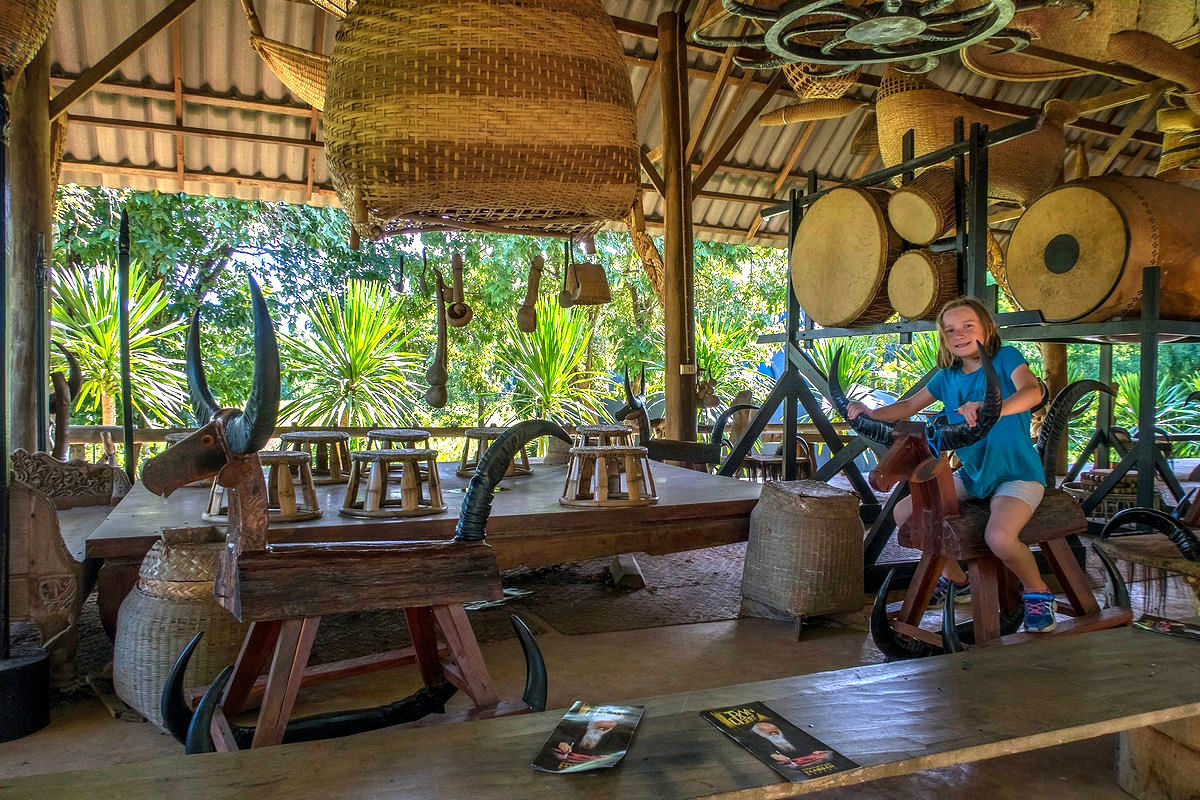
Dani riding a toy water buffalo at The Black House in Chiang Rai
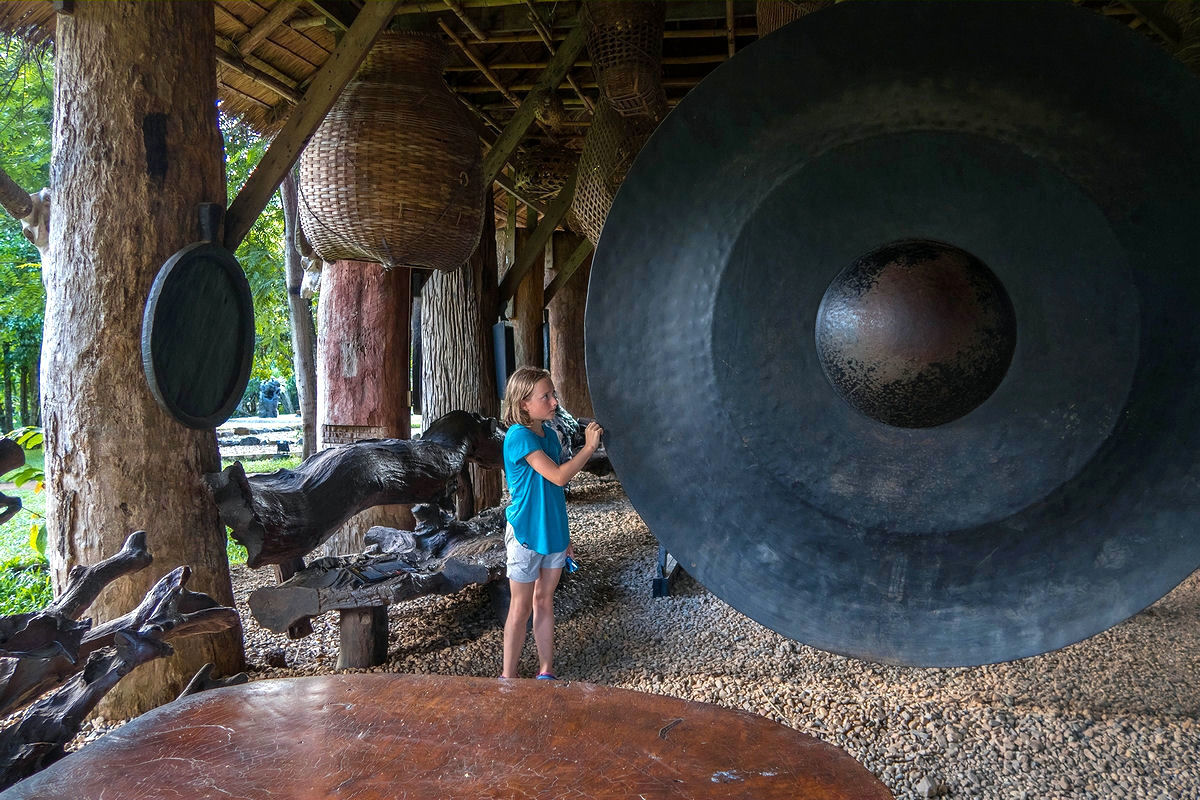
Dani inspecting a large gong at The Black House

Black water buffalo grazing near the white domes in The Black House
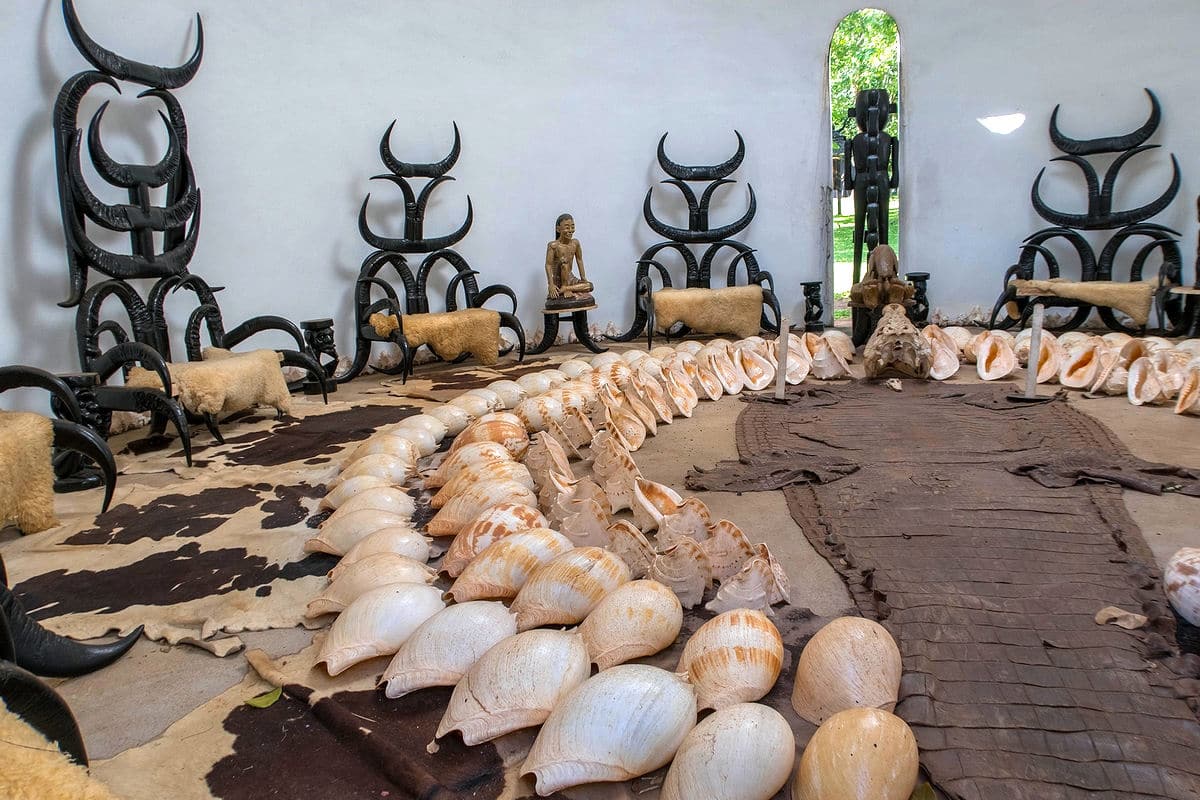
Here is the interior of one of the two white domes
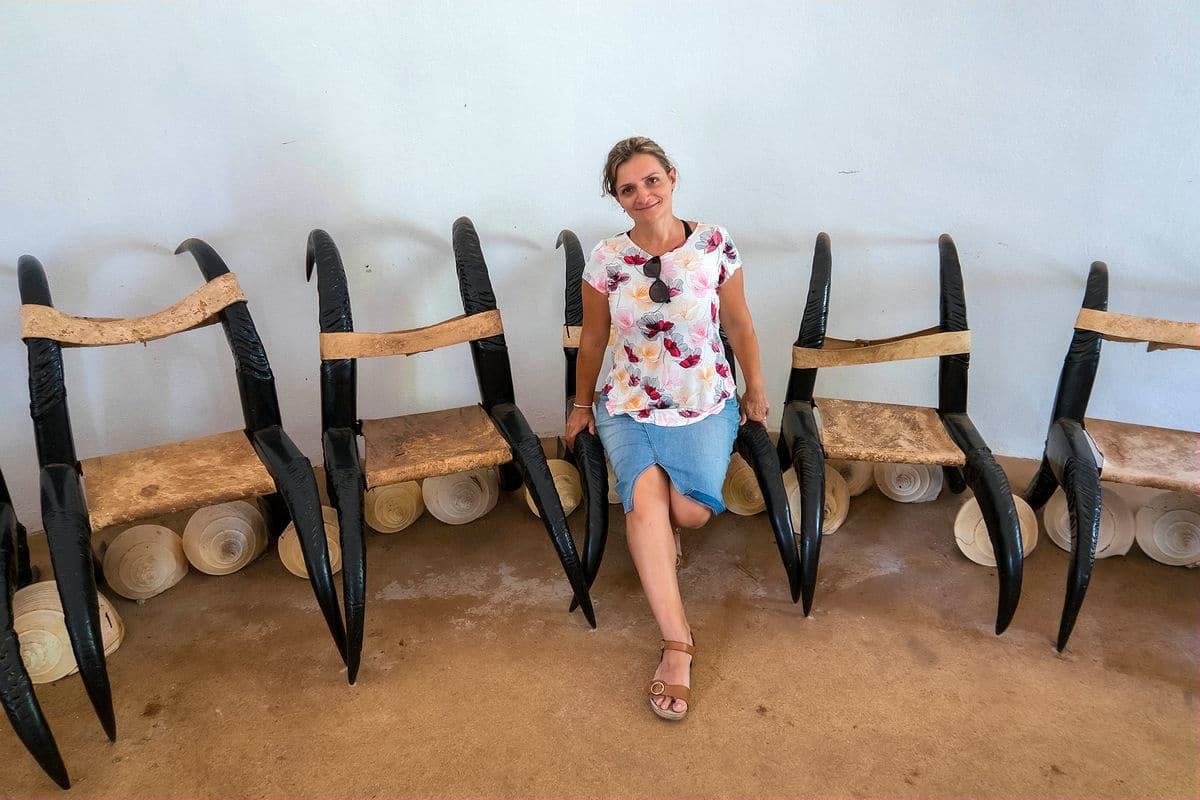
Inside the other white dome, here I am sitting on a chair made of horns
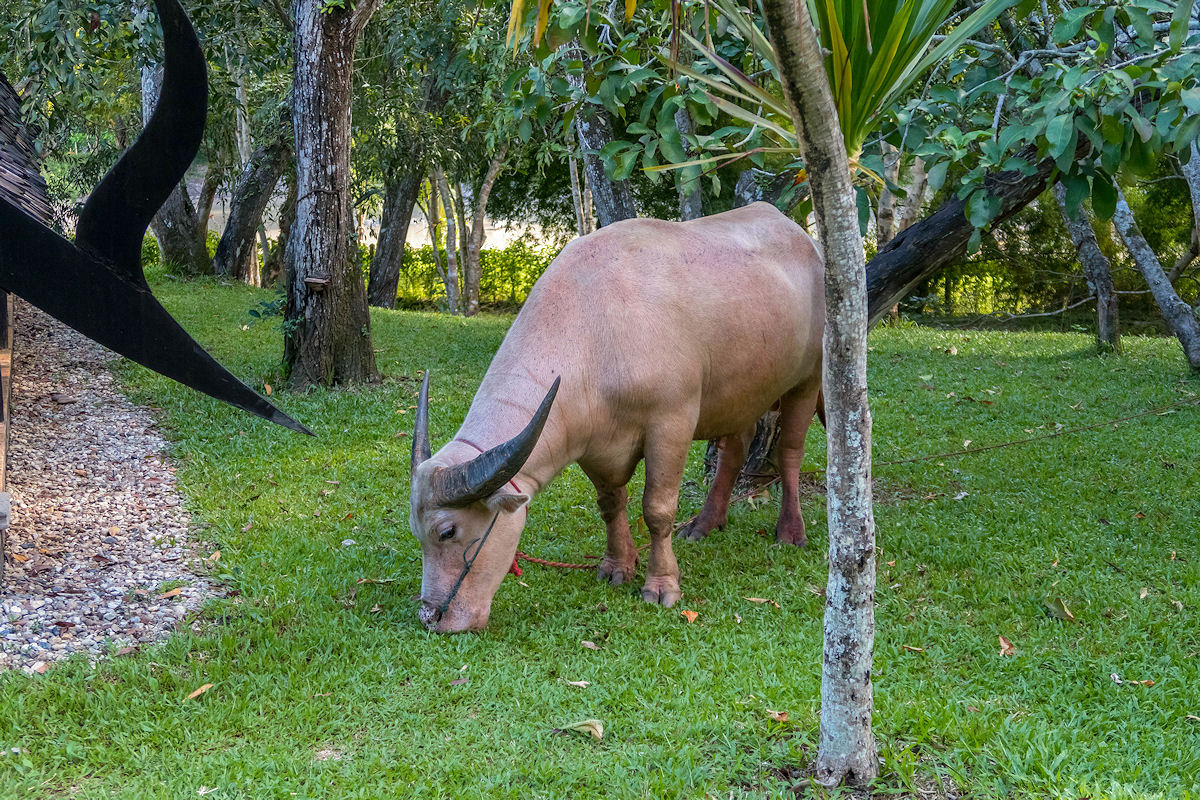
White water buffalo grazing nearby
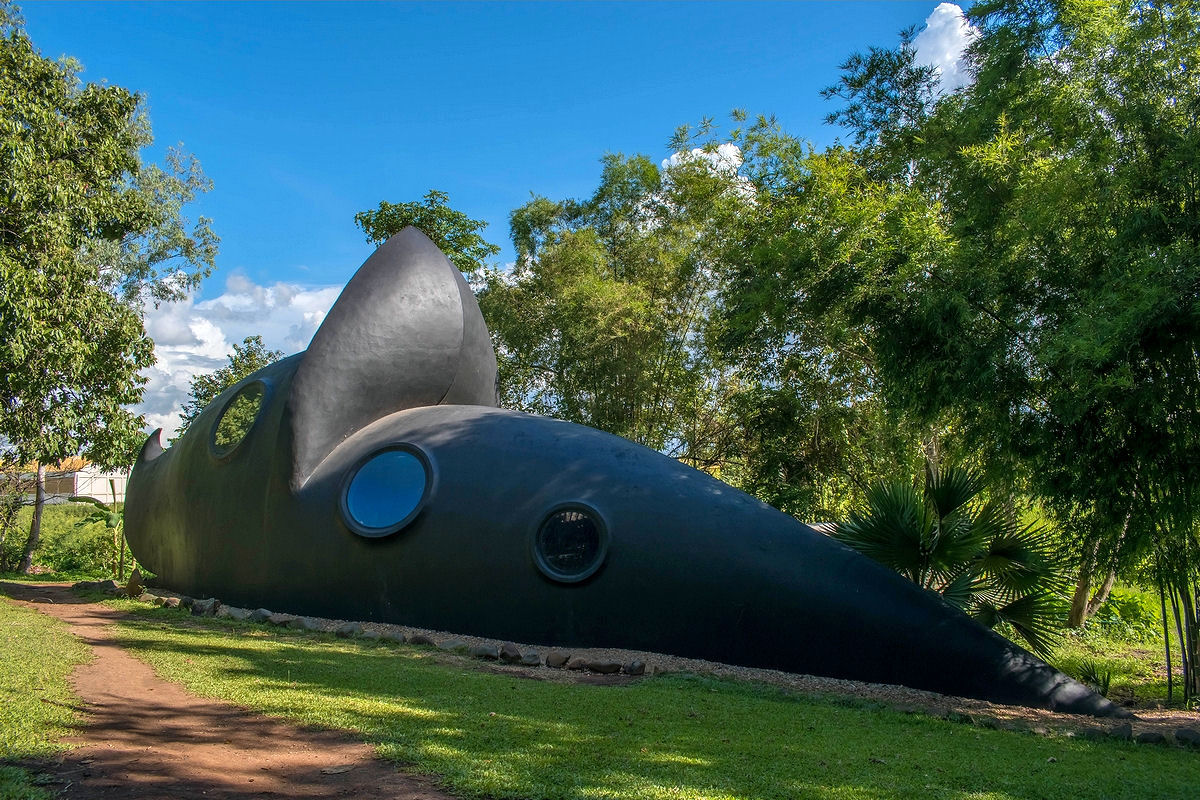
The whale-shaped structure, which holds a bedroom inside
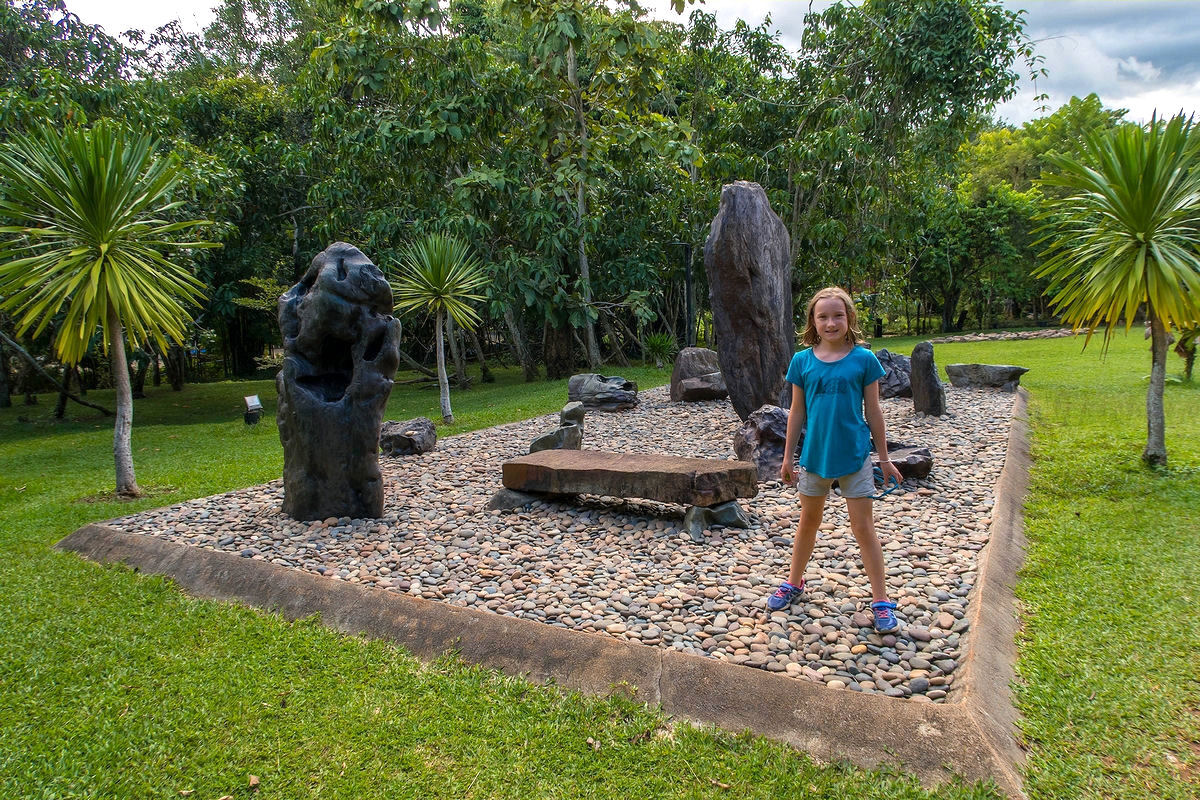
Dani in the rock garden at The Black House
Interesting Stop
In the end, to say that visiting the Baan Dam Museum in Chiang Rai was an interesting experience would be an understatement. While we wouldn’t make the same choices when it comes to home decor, it was fascinating to get to know one of Thailand’s most notable artists. After all, a little quirkiness is a must in the world of art, wouldn’t you say? 🙂
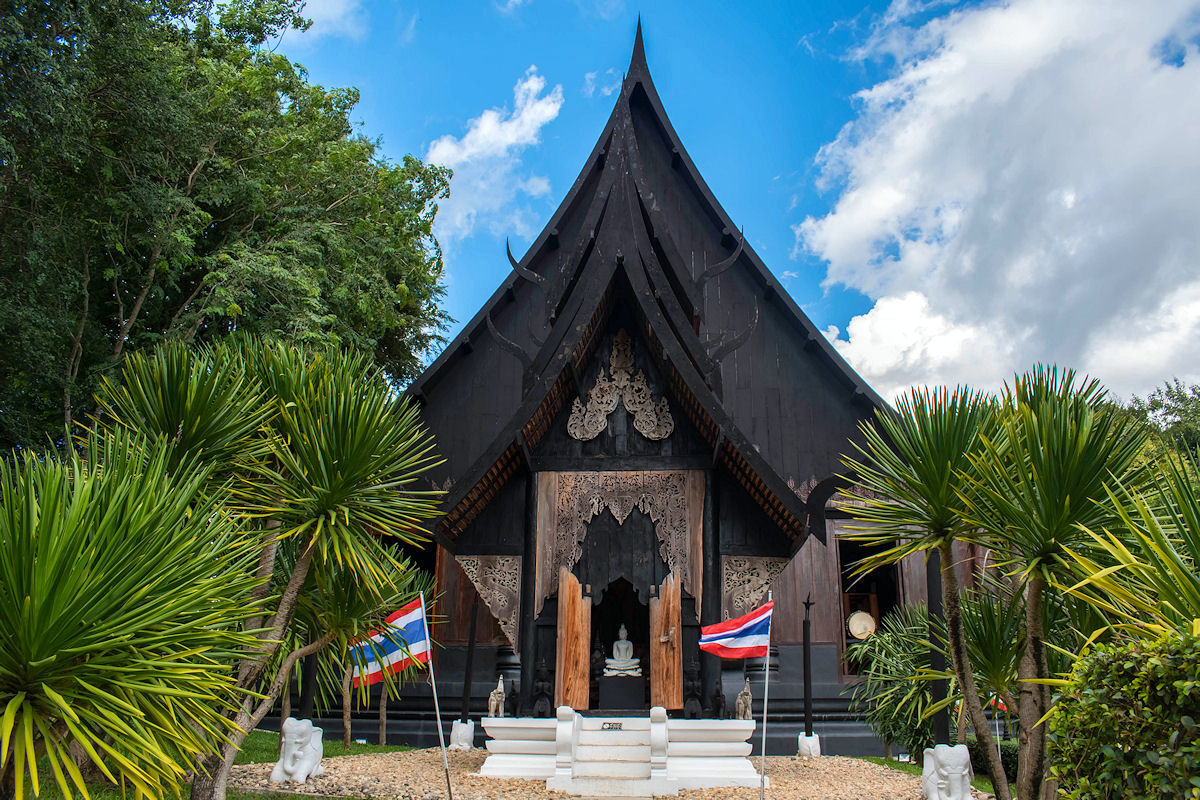
White Buddha sculpture at The Black House
Karen Long Neck Hilltribe Village
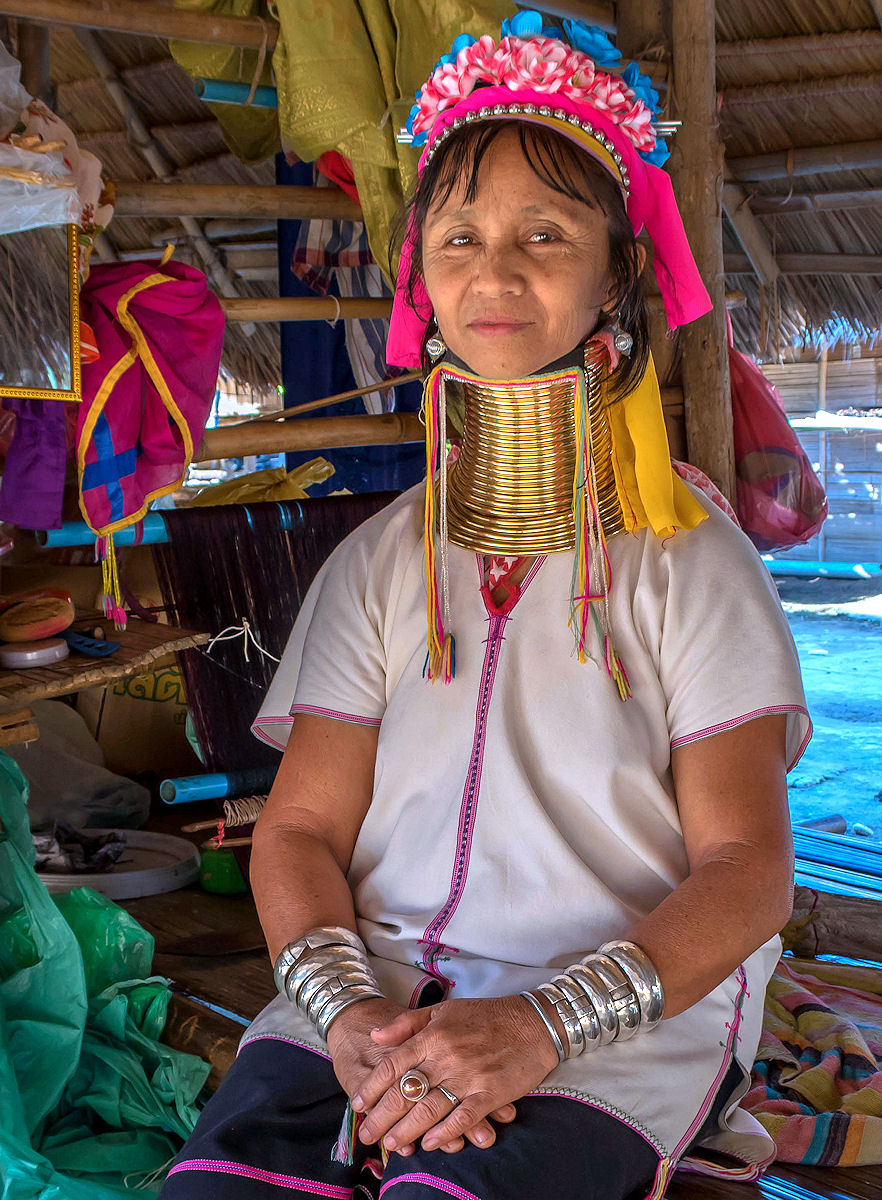
Karen Long Neck woman in Northern Thailand
The final stop on our Chiang Mai to Chiang Rai itinerary was the nearby village of the Karen Long Neck Hilltribe. The people from this tribe, who currently live in Northern Thailand, are refugees from neighboring Myanmar (Burma). They have left their homeland due to ongoing conflicts and mistreatment.
Traditionally, women in the tribe wear heavy brass rings around their necks in order to push the shoulders down and make their necks appear longer. As to how this tradition started, there doesn’t seem to be one clear answer. Some stories claim it was originally intended as protection from tiger bites, but eventually it became a measure of beauty. The more rings a woman wore, the more beautiful she was considered. Nowadays, the women of the Karen Long Neck Tribe don’t have to wear the brass neck rings, but many still do, either to honor their ancestors, or simply to entertain tourists.
You may have seen pictures of the Karen Long Neck women in National Geographic and wondered how it’s even possible to apply these massive brass accessories! I know I did…In fact, this is how I first became interested in learning more about these fascinating people.
The Controversy
There is plenty of controversy as to whether visiting the Karen Long Neck villages is an ethical thing to do. Many tourists refer to them as “human zoos” and skip the experience altogether. Not to mention, a lot of these villages were set up primarily as tourist attractions and consist mostly of souvenir stands.
Here is the thing, though: The Karen Long Neck people have very limited rights in Thailand; most are not citizens of the country and can’t legally work. Therefore, most of their income comes from tourists, who pay to visit the villages and buy their handmade crafts. So, the question is: Do we boycott these places and not visit at all? Or, do we take a tour, even if we feel a bit uncomfortable, and give them our business? I chose to go in and meet the people, while hubby and the kids decided to sit this one out.
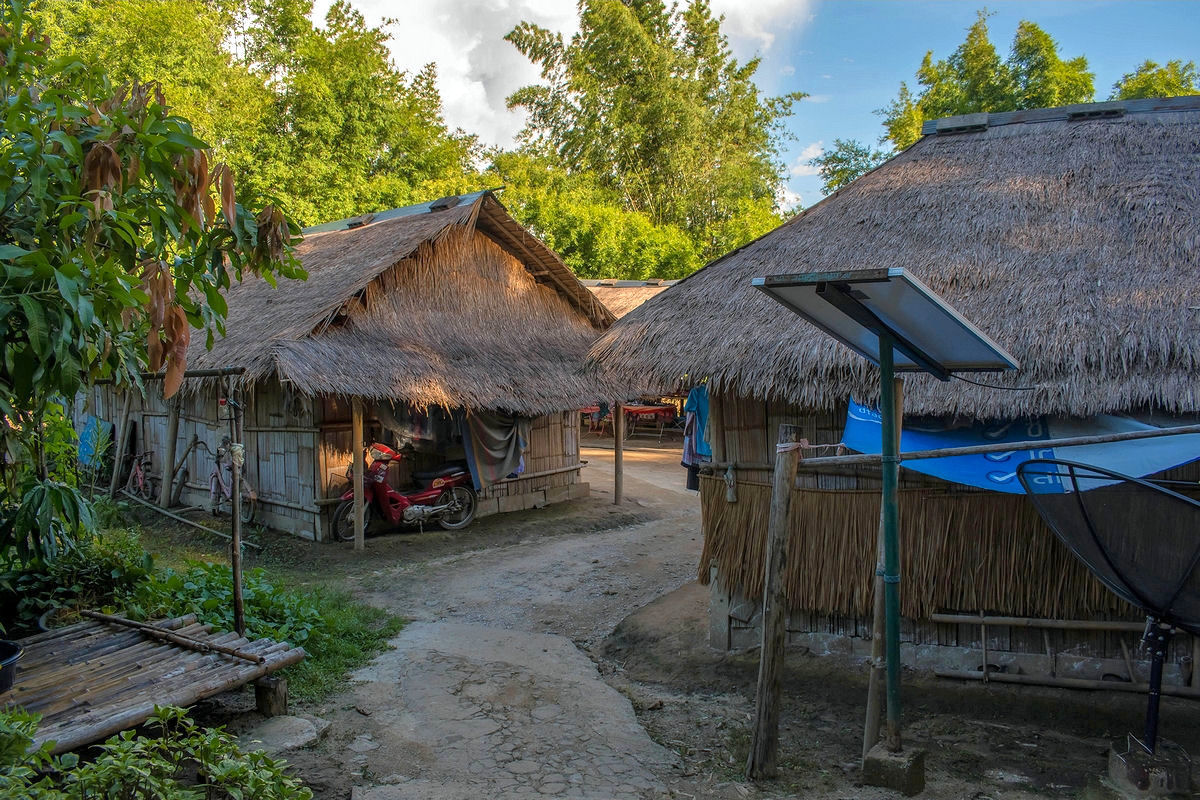
Entering the Karen Long Neck village near Chiang Rai
My Experience
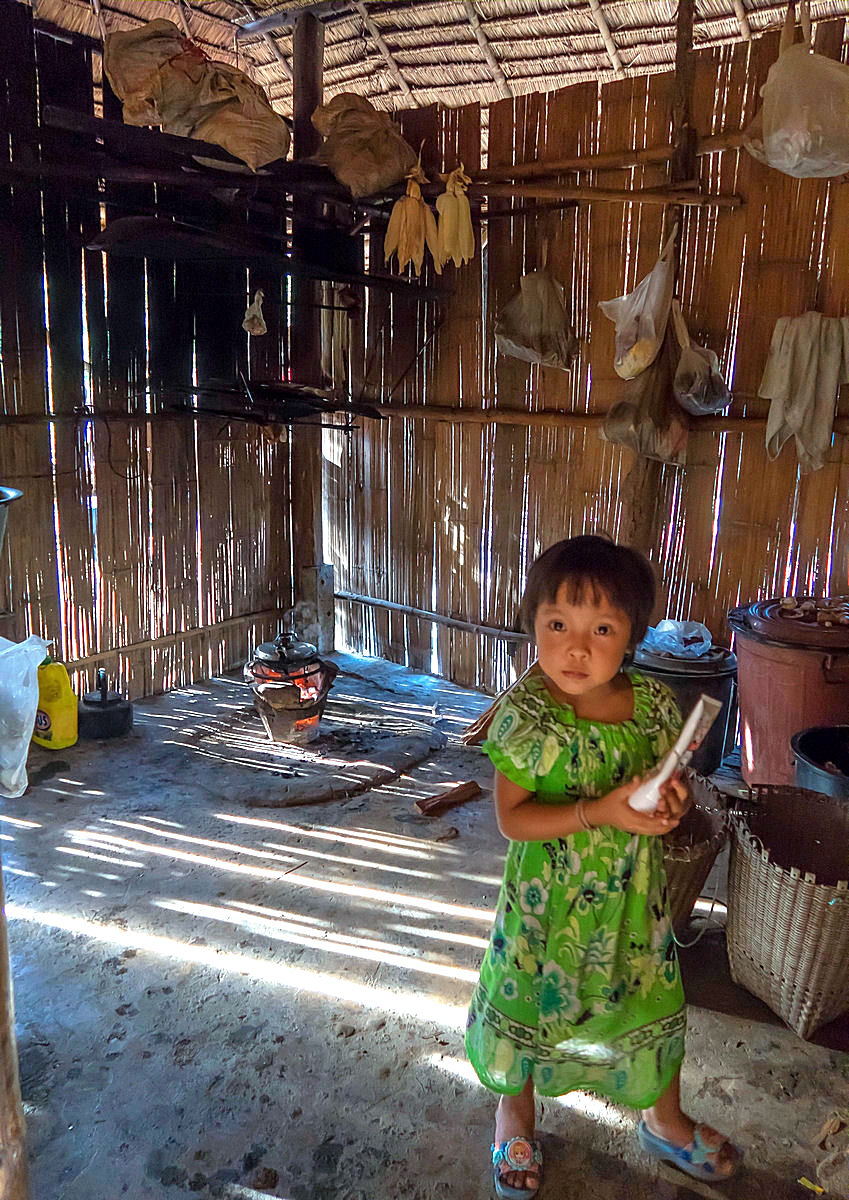
Little girl showing us her house at the Karen Long Neck village
After purchasing a few small souvenirs near the entrance, Ms. Kwan and I followed the path into the Karen Long Neck Village. On one side, we saw a row of traditional houses made of bamboo and straws, and on the other, more souvenir stands. A couple of women in traditional attire greeted us, and an adorable little girl opened the door to her family’s house to show us what they were cooking for dinner. It looked like some kind of delicious curry simmering over an open fire.
Next, we met a young woman holding a crying infant and her mom, who was trying to help her calm the baby down. We stopped nearby, and Ms. Kwan started a friendly conversation with them. It seemed the baby took interest in us, because he stopped crying for a minute and looked over with wide-open eyes.
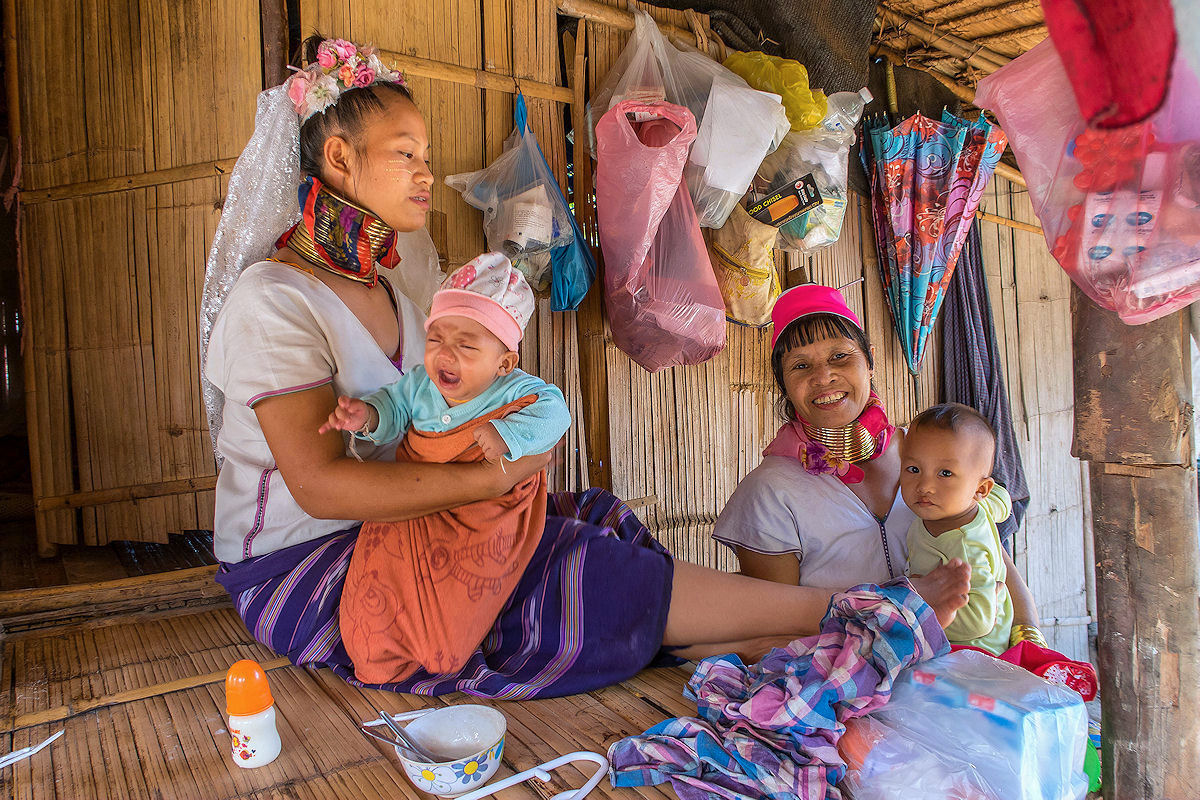
Karen Long Neck women taking care of young children
Cell Phones
As we continued our walk, I noticed perhaps the most curious phenomenon of all, a young man lying on a hammock in the shade, staring at what looked like a smart phone. I guess modern times have caught up even with the people of the Karen Long Neck Hilltribe! Ms. Kwan explained that while the women in the tribe make and sell crafts, the men do agriculture work within the village. Apparently, they had finished their workday, and now was their time to kick back and relax.
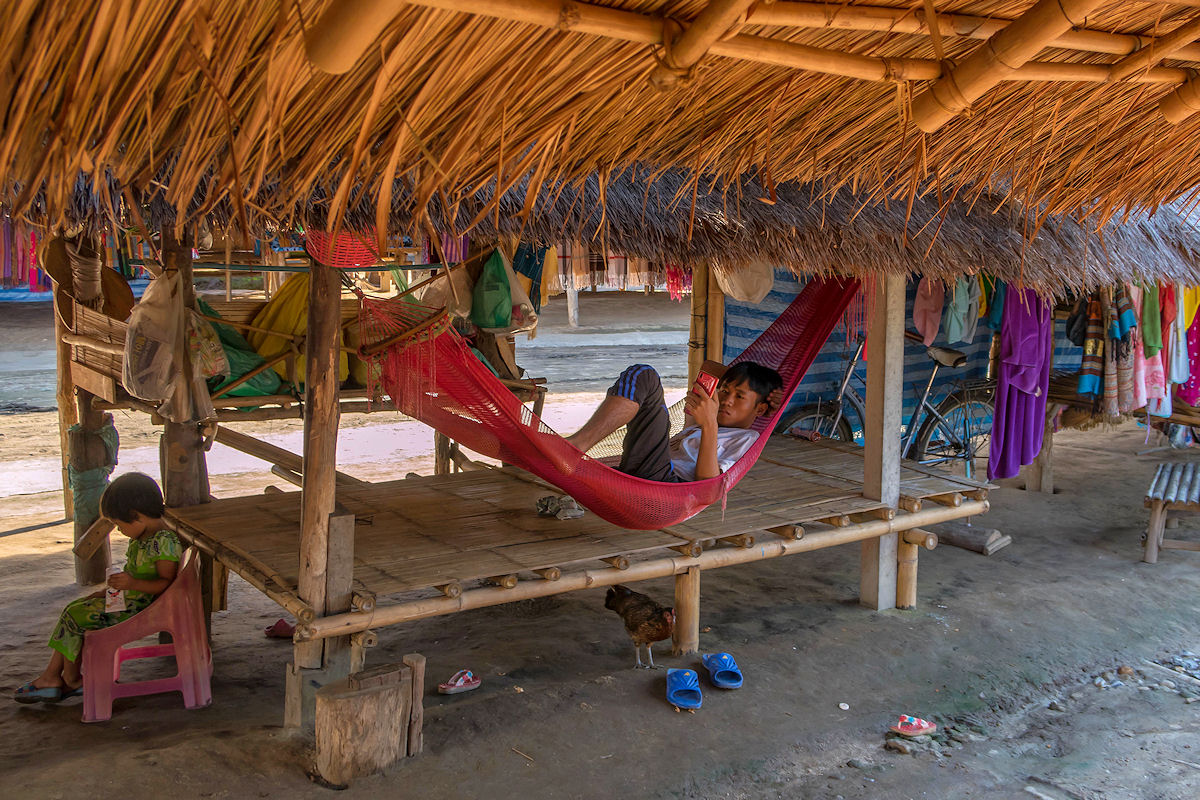
Man with a smart phone at the Karen Long Neck village near Chiang Rai
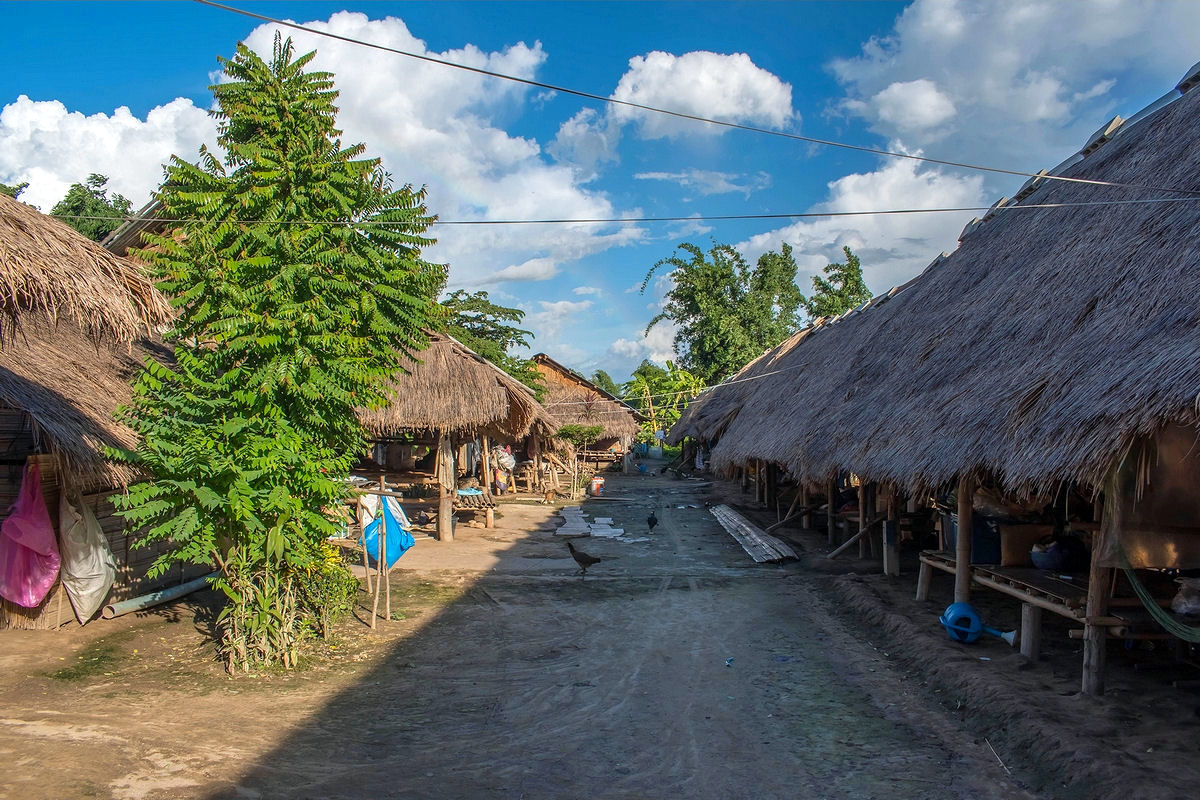
Walking through the village
Trying on the Rings
Slowly, Ms. Kwan and I circled back around passing more souvenir stands. At one of them, I picked out a little wood-carved sculpture and took a few pictures with the woman selling the crafts. For the photo shoot, she put a colorful band on my head and a set of brass rings around my neck. The brass rings were the fake tourist edition; they were cut in half so getting them on was not a big deal. To top it all off, the woman handed me a fake guitar-like instrument and kindly posed next to me. Yes, it’s just a silly touristy thing to do, but a fun memory of this day, nevertheless. We thanked the woman for her kindness and made our way back to the van where hubby, the kids, and our driver were waiting.
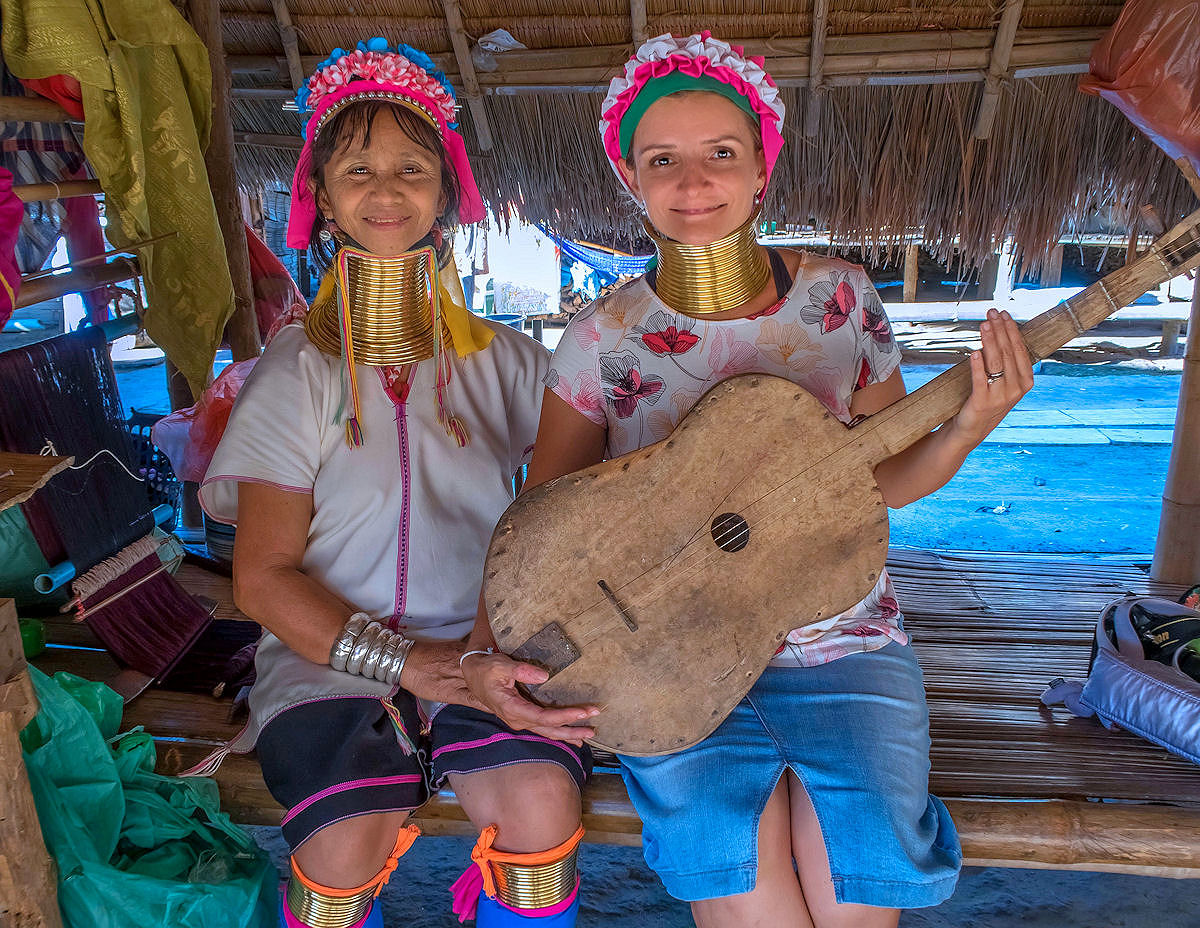
Posing for a photo
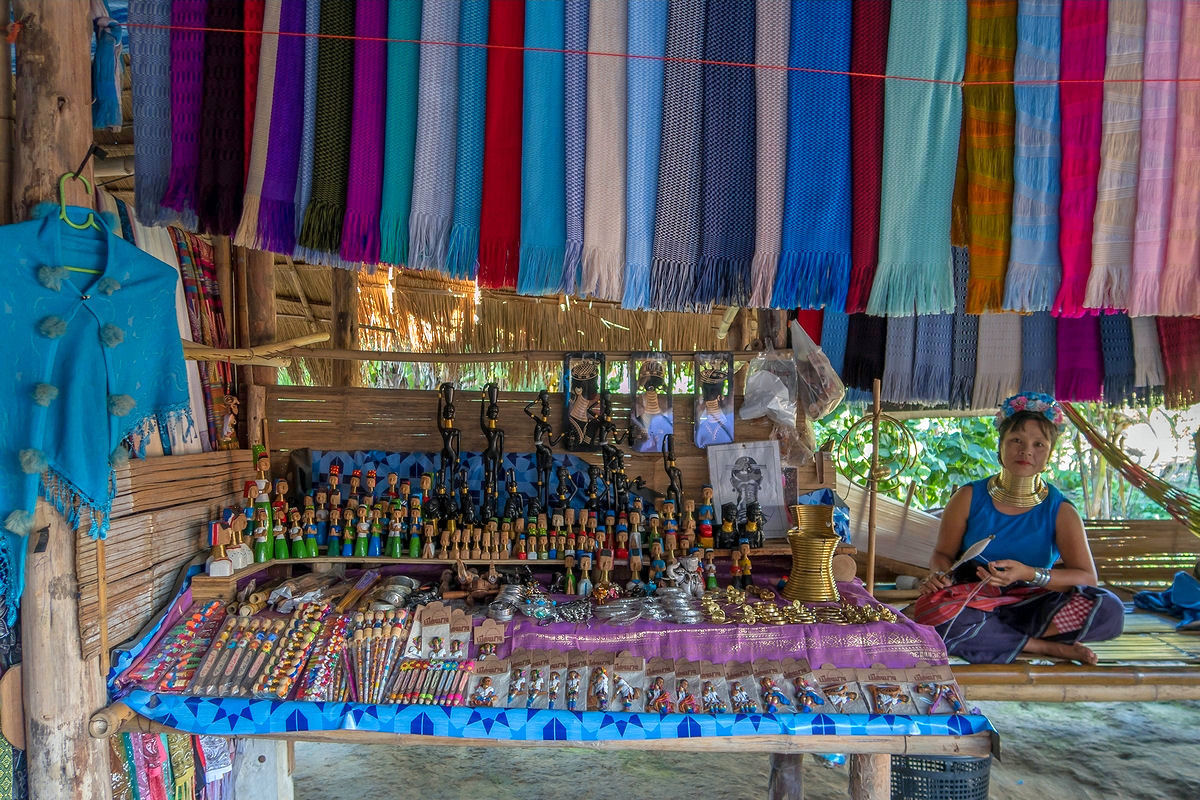
Karen Long Neck woman selling crafts
Should You Visit
All in all, visiting the Karen Long Neck Hilltribe Village near Chiang Rai was an interesting experience. Because I was there on a private tour with Ms. Kwan and not with a large group of picture-snapping tourists, I felt our presence was less of an intrusion. We got a glimpse of the tribe’s way of life, although it was clear that the place was mostly a tourist display. According to Ms. Kwan, the most authentic Karen Long Neck villages in Thailand are located further North near the border with Myanmar (Burma), but they are quite difficult to access.
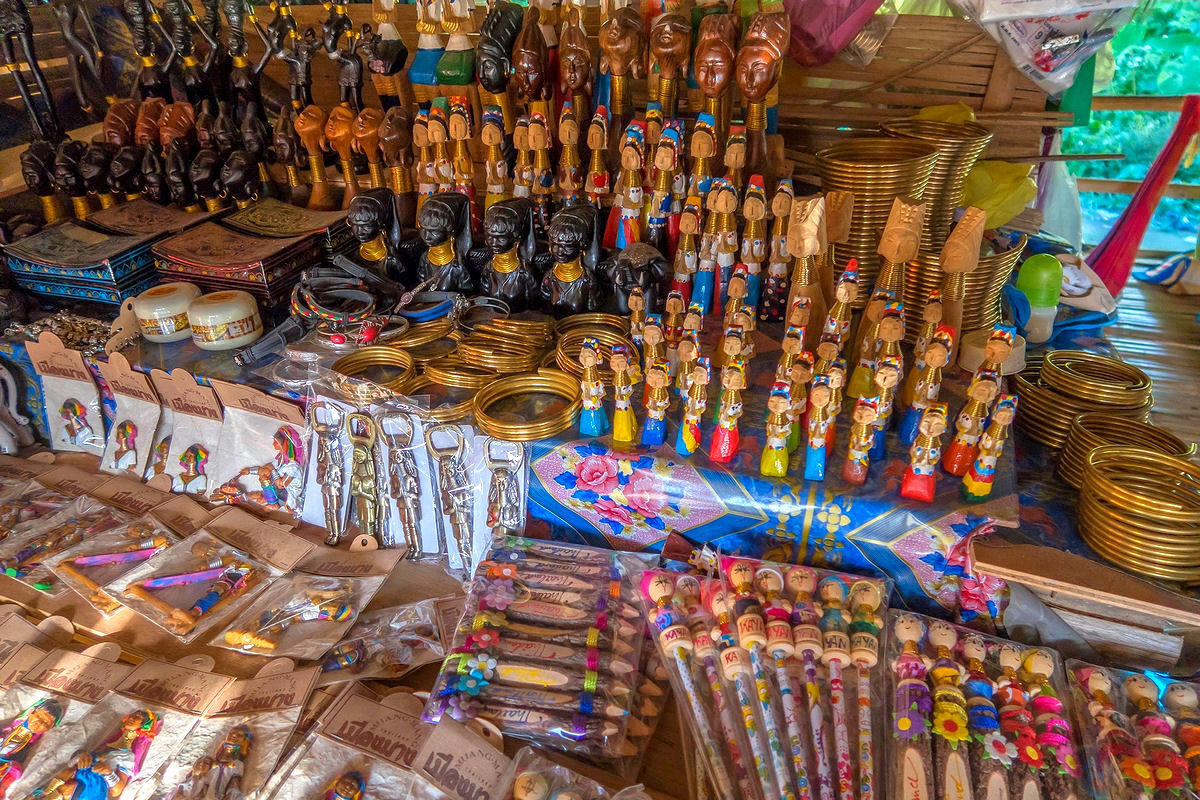
Souvenirs that you can buy at the Karen Long Neck village
Despite all the controversy, I am happy I visited and purchased a few lovely souvenirs from the people in this village. I wanted to support them without feeling too much like an intruder, and luckily, this is exactly the experience I got. My advice is, book a private tour if you are interested in going to a Karen Long Neck village. You will learn more from a one-on-one conversation with your guide, and you will feel less like a part of the “paparazzi” crowd. Last but not least, definitely bring some cash, and plan on purchasing a few souvenirs. After all, tourism is the main source of income for most Karen Long Neck people living in Thailand.
Our Chiang Rai Hotel for the Night
As our day trip from Chiang Mai to Chiang Rai slowly came to an end, there was one last place we needed to get to – our hotel for the night. The place we had booked was called The Garage Cafe & Guesthouse. While it was not located in the city center, it had great visitor reviews and was very reasonably priced. Our driver and Ms. Kwan kindly dropped us off along with all our luggage right at the entrance before heading back to Chiang Mai.
The Garage Cafe & Guesthouse turned out to be a lovely accommodation for us. It was very clean, and the owners were friendly and helpful. They gave us recommendations on restaurants and kept checking if we needed anything. If you would like a nice, inexpensive place for a night or two in Chiang Rai, give The Garage Cafe & Guesthouse a try. You won’t regret it!
Wat Huay Pla Kang, known as “Big Buddha Chiang Rai”
On the following day, we had to catch a flight from Chiang Rai to Phuket. Since it wasn’t scheduled until the afternoon, we decided to visit one more attraction nearby. It was a temple complex called Wat Huay Pla Kang, and it looked pretty neat in pictures. We purchased a small breakfast right at our hotel, then requested a Grab car to take us there. Grab is basically the Asian version of Uber, and it’s a very convenient and reliable service. We asked our Grab driver to not only take us to Wat Huay Pla Kang, but also wait for us there. I had read that it can be quite difficult to get transportation and cell phone reception at the complex, so we decided not to risk getting stranded.
TIP: If visiting Wat Huay Pla Kang temple complex in Chiang Rai, it’s a good idea to arrange your transportation from there back to town in advance. Not many taxis or buses go to Wat Huay Pla Kang at this time, and phone reception is not always reliable.
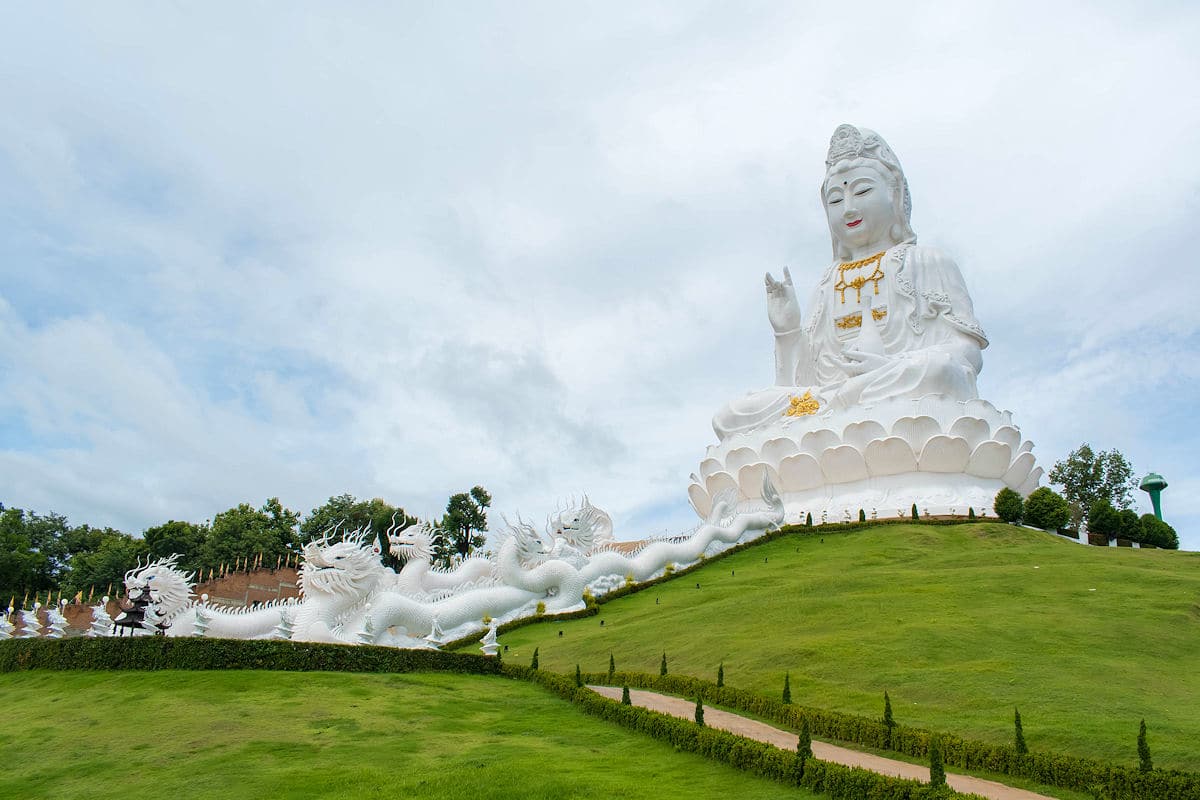
Giant statue of Guan Yin at Wat Huay Pla Kang in Chiang Rai
Guan Yin
When we arrived, our eyes were drawn to a giant white temple/statue of what many call the “Big Buddha.” However, I had done enough research to know that this wasn’t actually Buddha. It was an image of the Chinese Goddess of Compassion and Mercy, Guan Yin. Since the statue was located a bit further away, we decided to go there last.
Chinese Pagoda
We began our self-guided tour of Wat Huay Pla Kang with a visit to the closest building. This was a colorful 9-story pagoda, decorated in Chinese style. As we came to the stairs at the front, we walked past two ornate golden-green nagas (dragon-like serpents) guarding the entrance. After removing our shoes, all of us went inside and walked over to a large wooden statue in the center of the pagoda. Once again, this was Guan Yin, the Chinese Goddess of Compassion and Mercy. This pagoda was apparently dedicated to her, as there were a number of Guan Yin statues throughout the place.
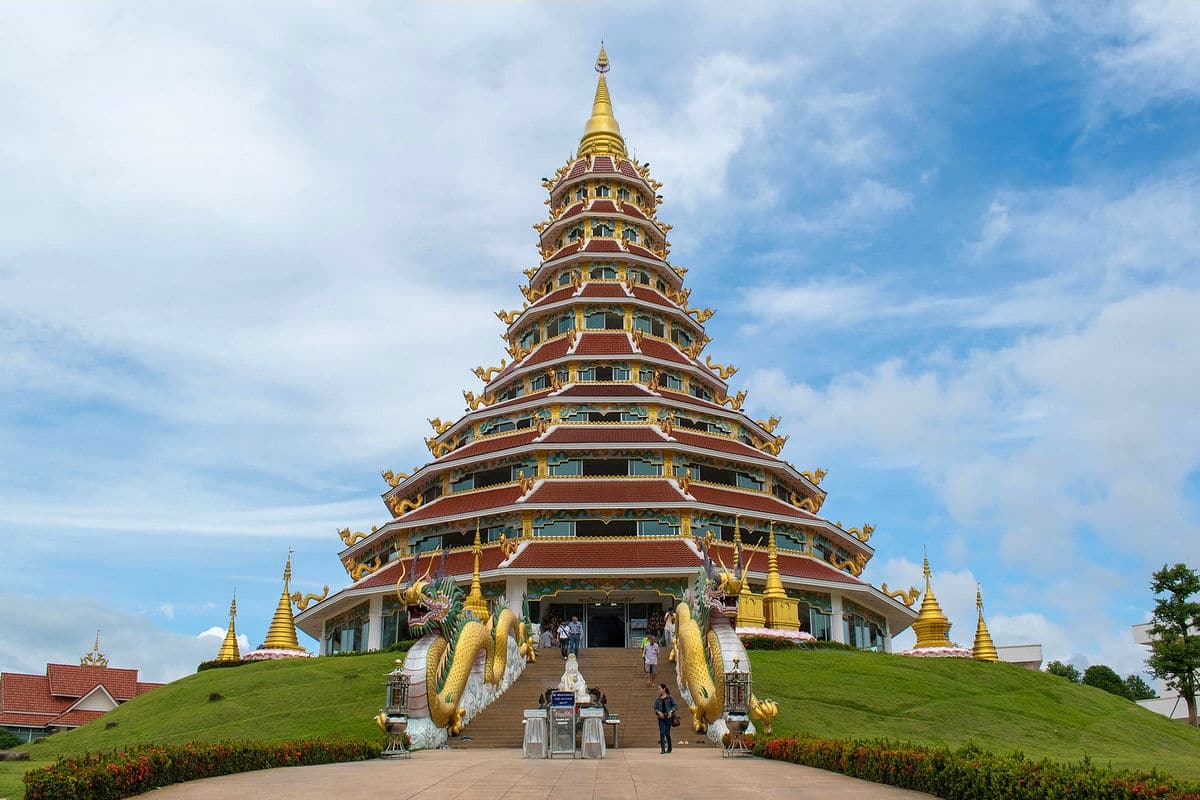
Chinese pagoda at Wat Huay Pla Kang
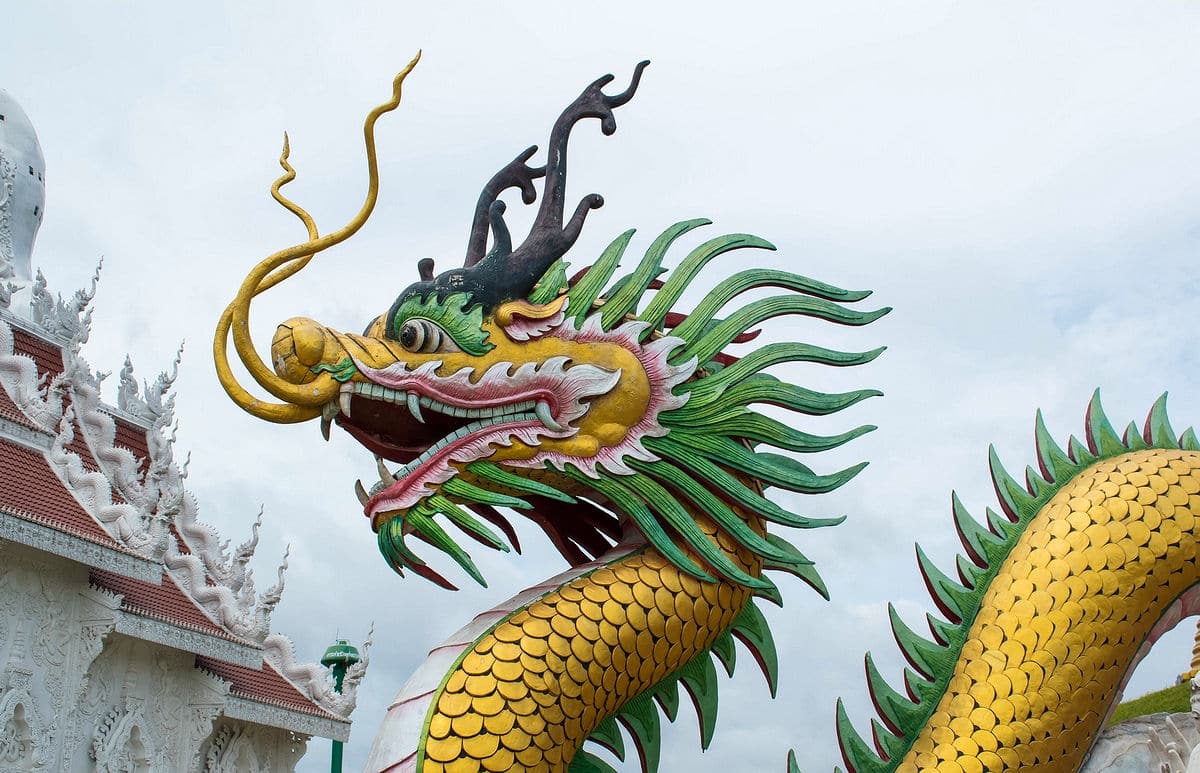
Golden-green naga statue at Wat Huay Pla Kang in Chiang Rai

Large wood statue of Guan Yin inside the pagoda at Wat Huay Pla Kang
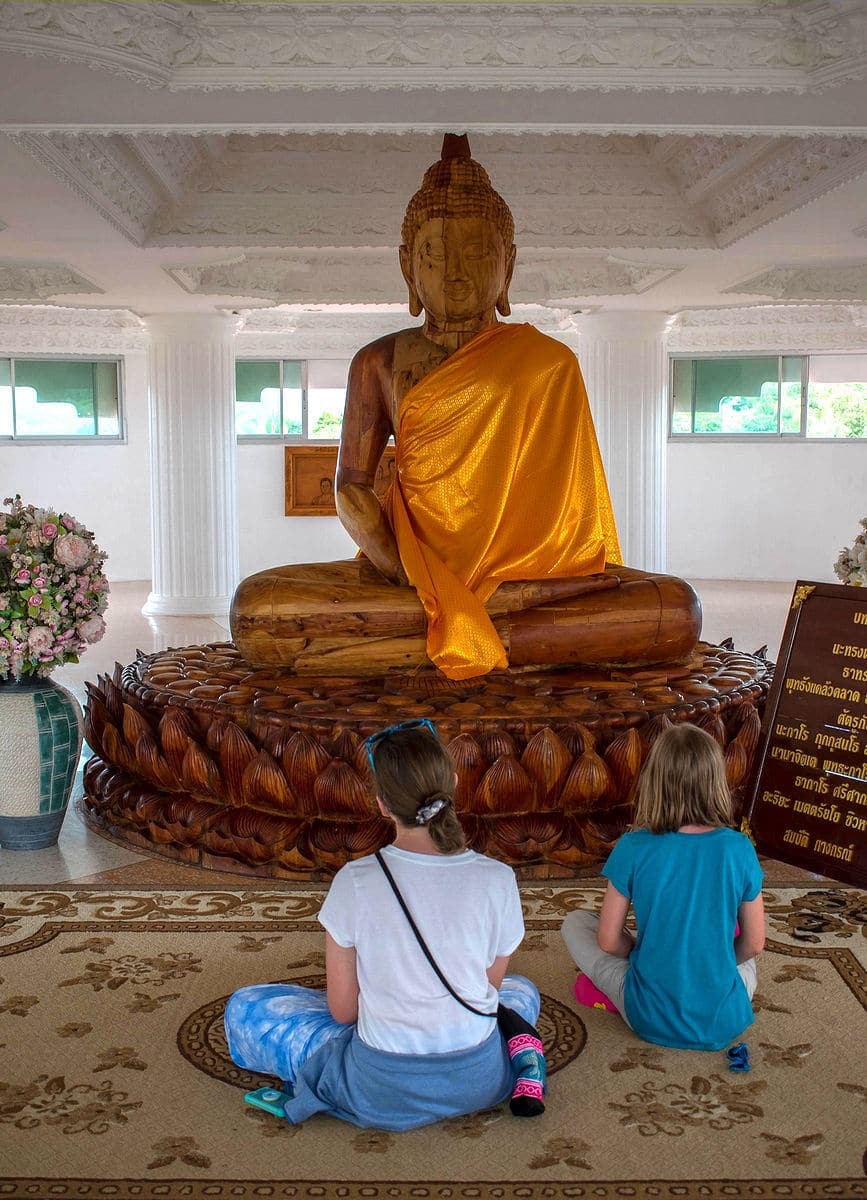
The kids sitting in front of a wood Buddha statue
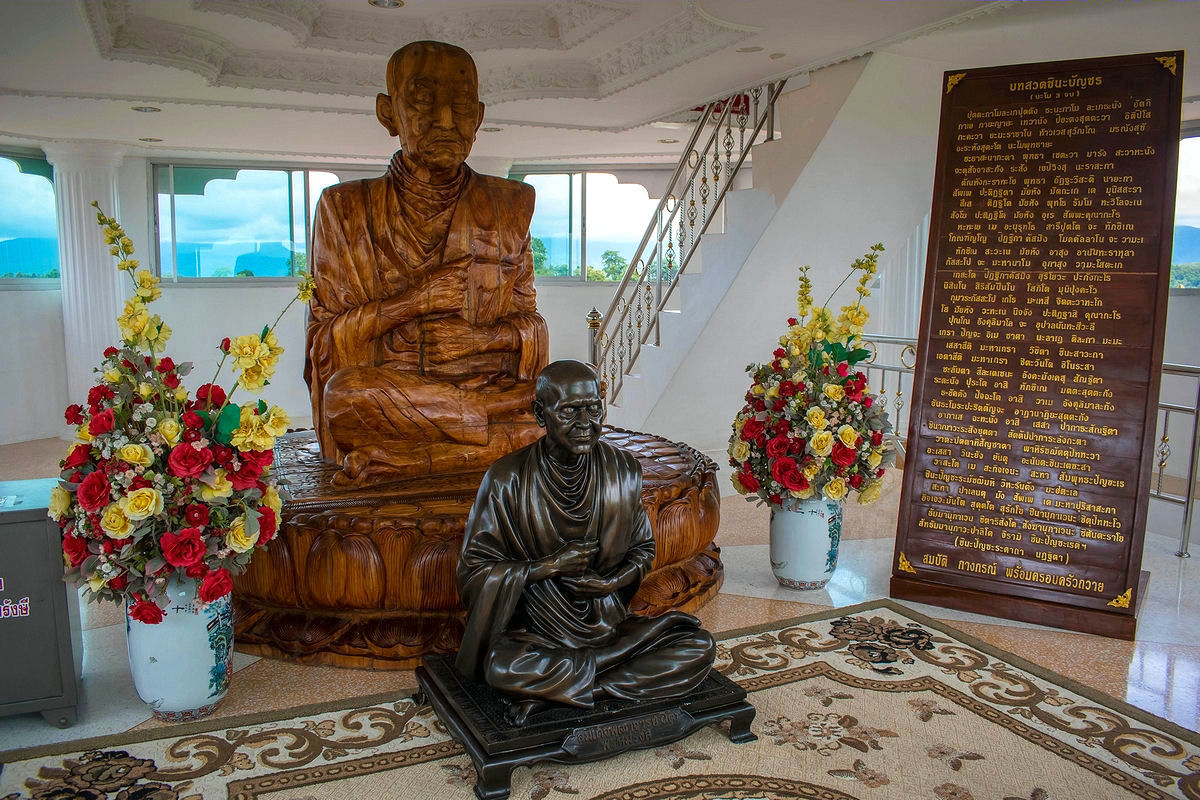
Monk statues…
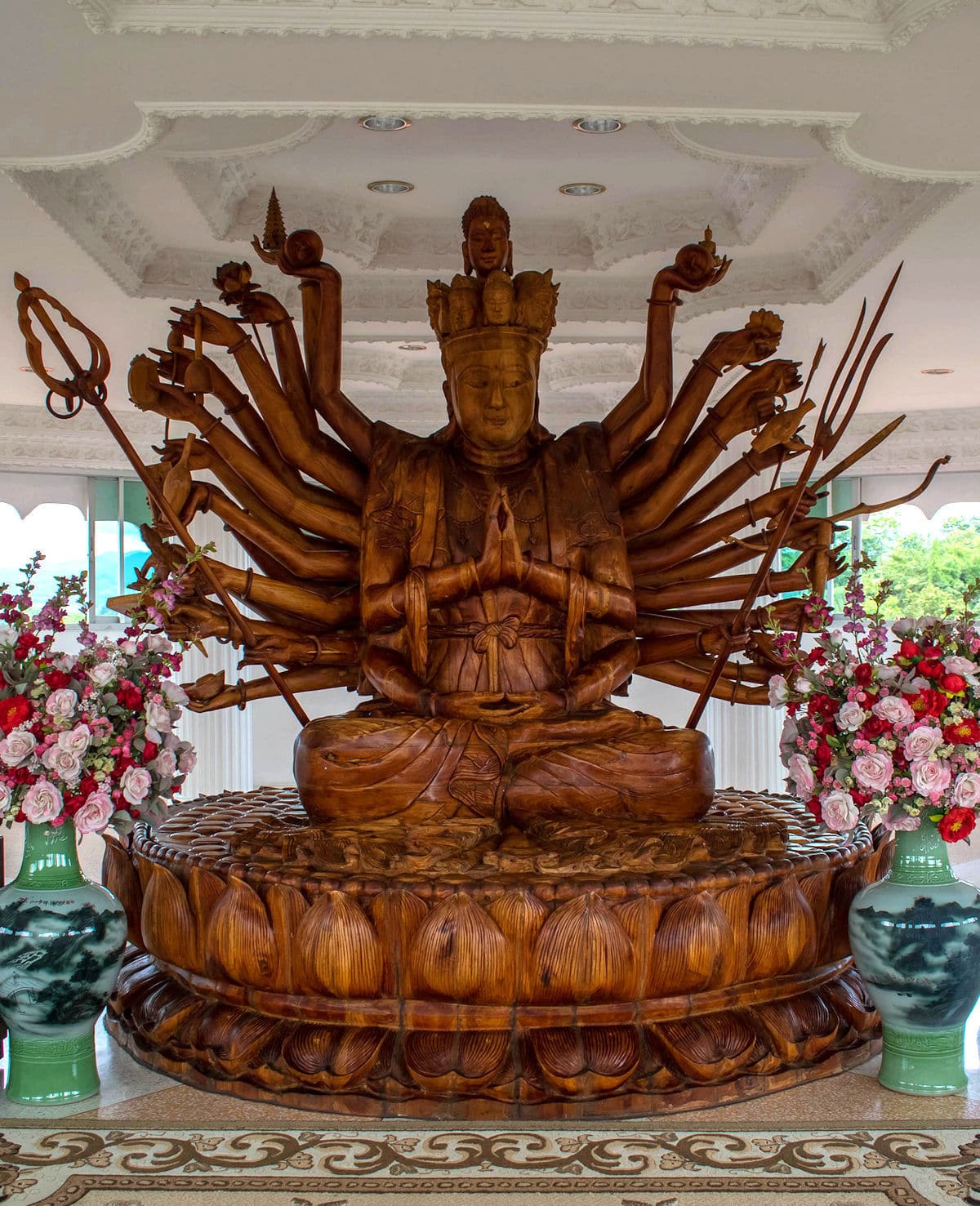
…Another elaborate wood statue inside the pagoda
Getting to the Top
We slowly made our way to the top of the pagoda, where the views of the surrounding area were beautiful. It took us some time to get there, though, since every floor was decorated with unique wooden statues of not only Guan Yin, but also other deities.
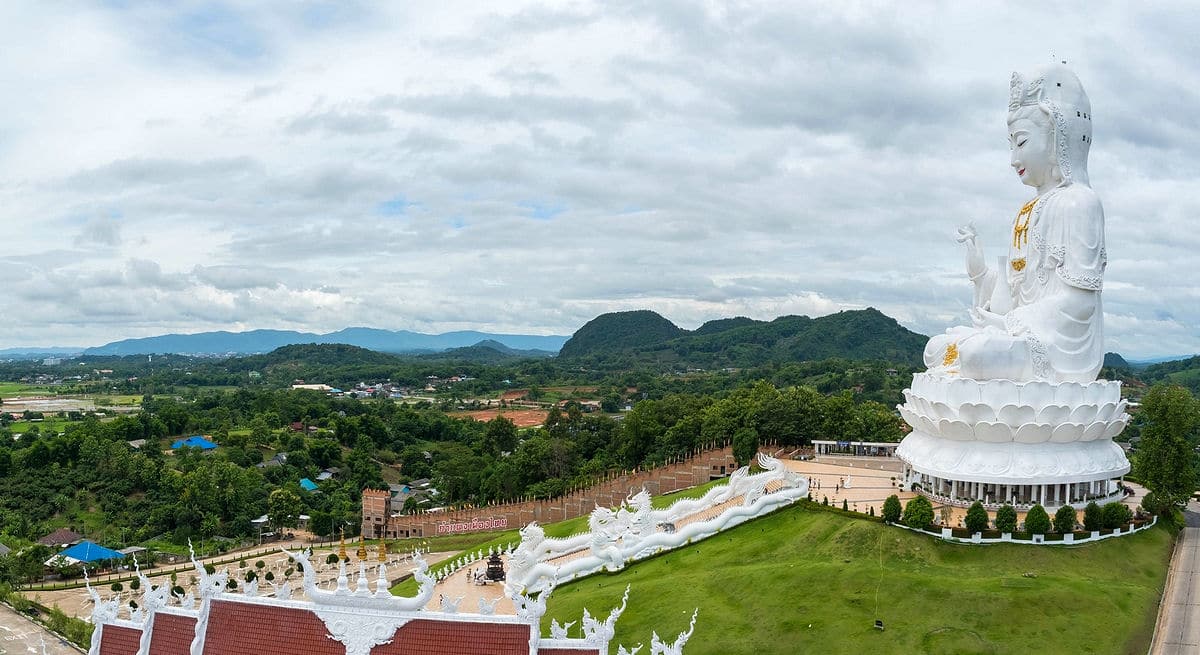
Panorama from the top of the pagoda at Wat Huay Pla Kang
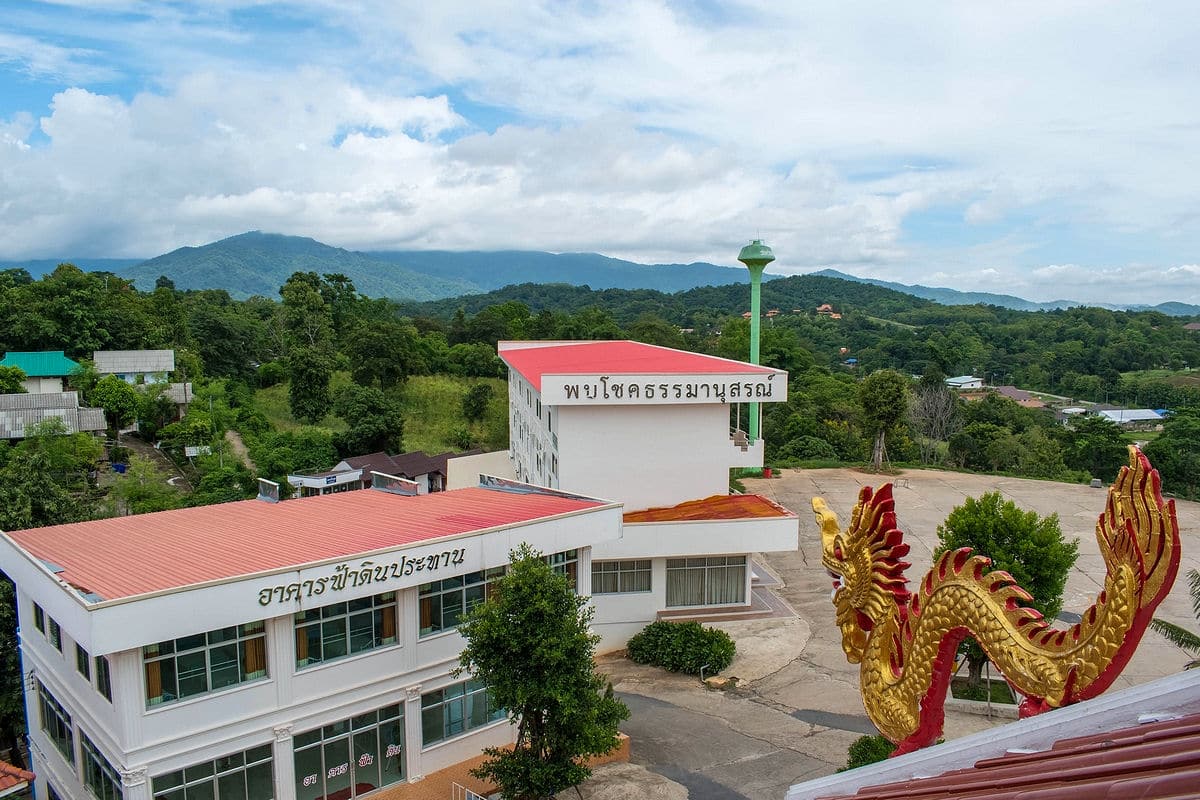
Another view from the top of the pagoda
Thai Temple
Our next stop at Wat Huay Pla Kang was a magnificent, traditional, Thai temple, which was painted in white. Once again, there were amazing sculptures of dragon-like serpents (nagas) guarding the entrance. Inside the temple, we found impressive, white, Buddha statues surrounded by bunches of fresh flowers. We were the only visitors at the time, so we took a few extra moments to enjoy the peace and quiet.
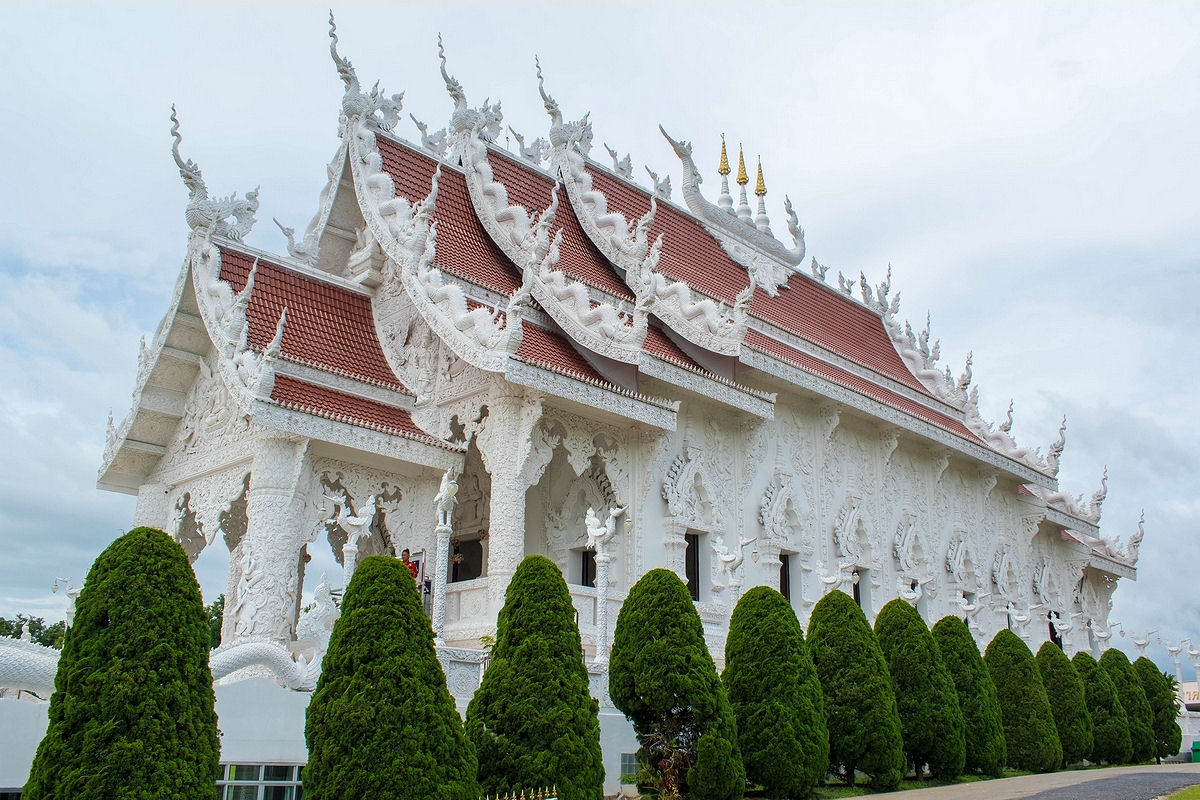
The Thai temple at Wat Huay Pla Kang
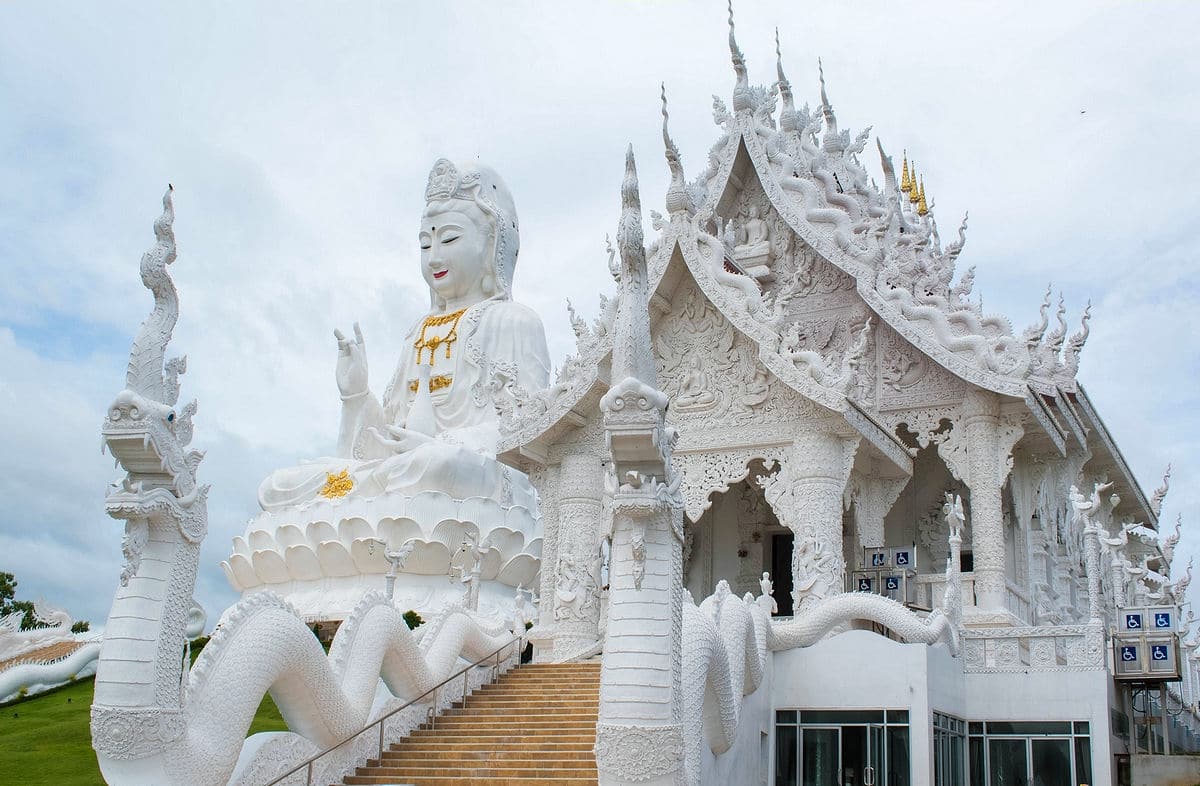
Walking to the Thai temple near Guan Yin’s giant statue
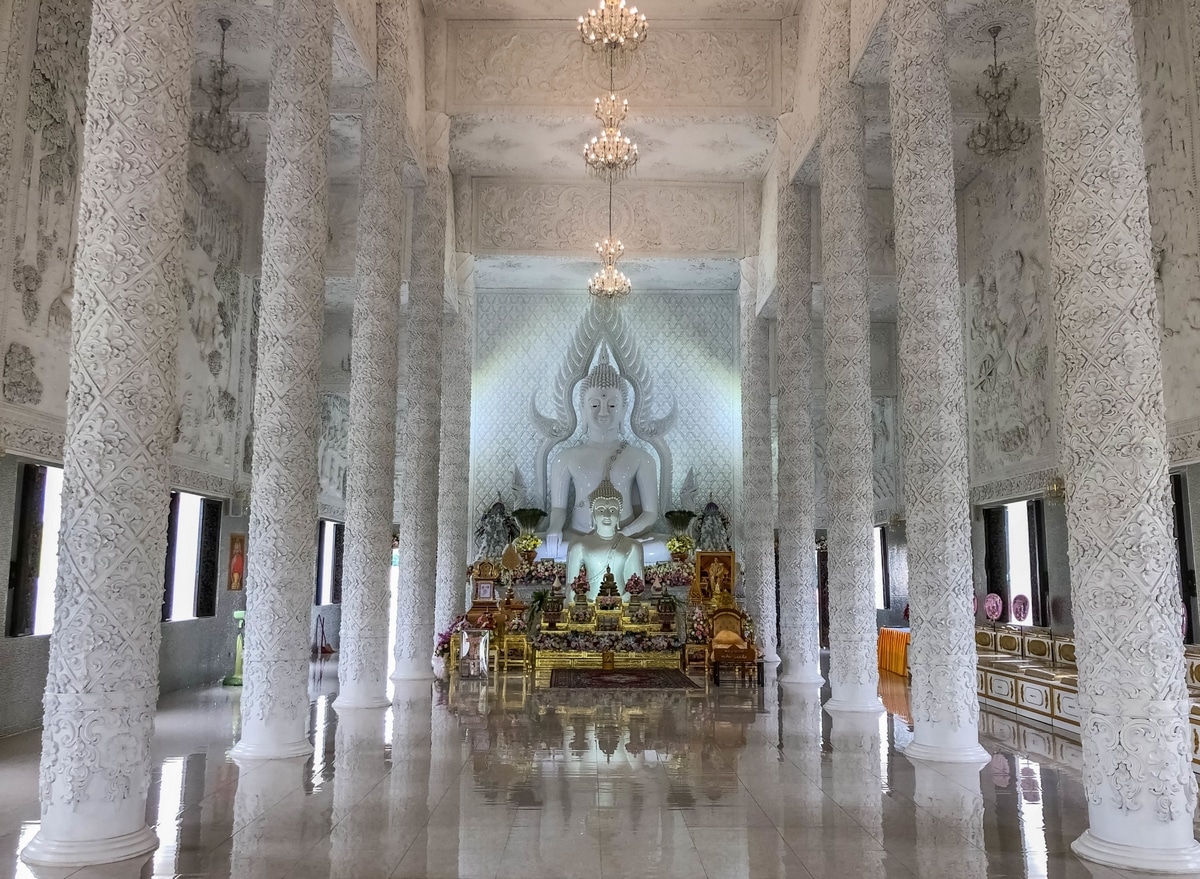
Entering the Thai temple
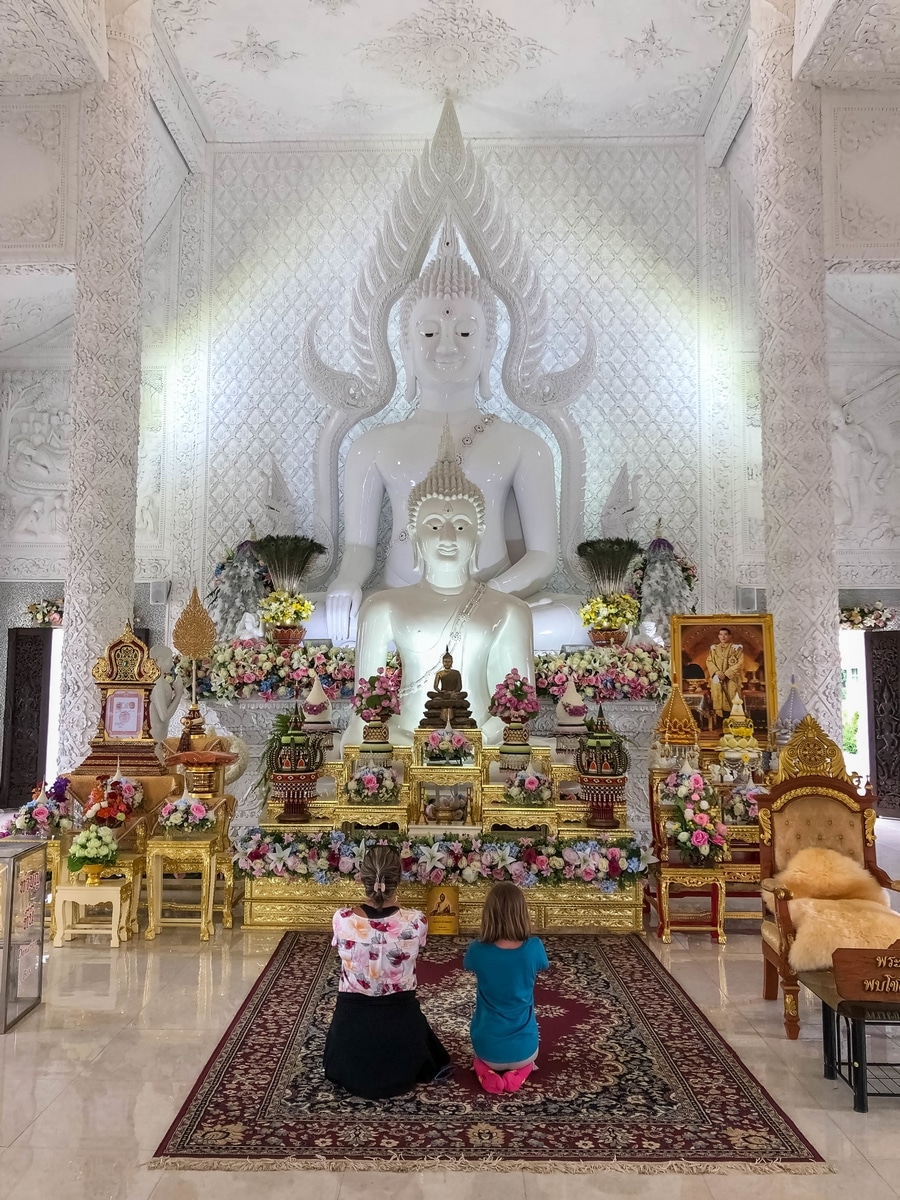
Dani and I paying our respects to Buddha
Statue of Guan Yin, The Goddess of Mercy…Not Buddha
From the Thai temple, we walked over to the final attraction at Wat Huay Pla Kang. This was the giant white statue of Goddess Guan Yin, and its size was staggering. As we got closer, we saw the most astounding white dragon-serpents on both sides of the massive stairs leading up to the entrance. These were truly phenomenal sculptures and perhaps my favorite. Needless to say, I took my sweet time snapping photos and wowing, while hubby and the kids made their way up the stairs and into the temple.
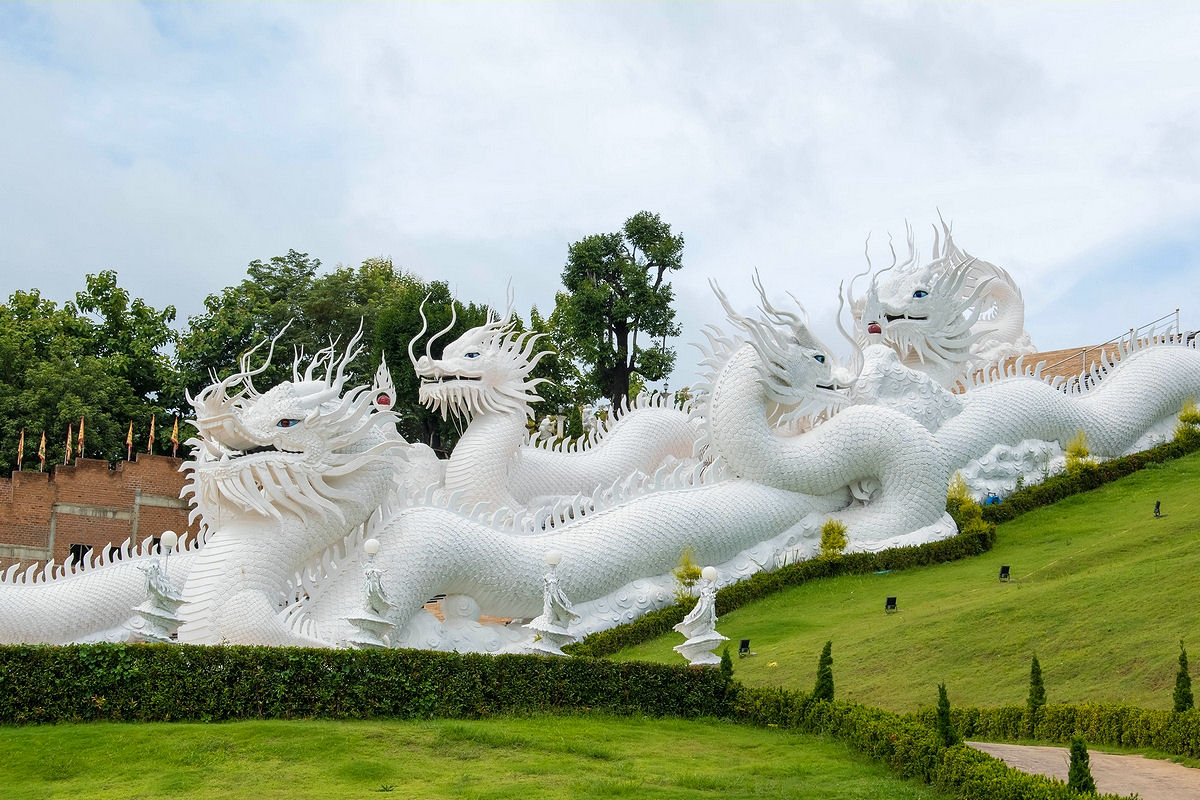
Incredible white dragon sculptures at Wat Huay Pla Kang in Chiang Rai
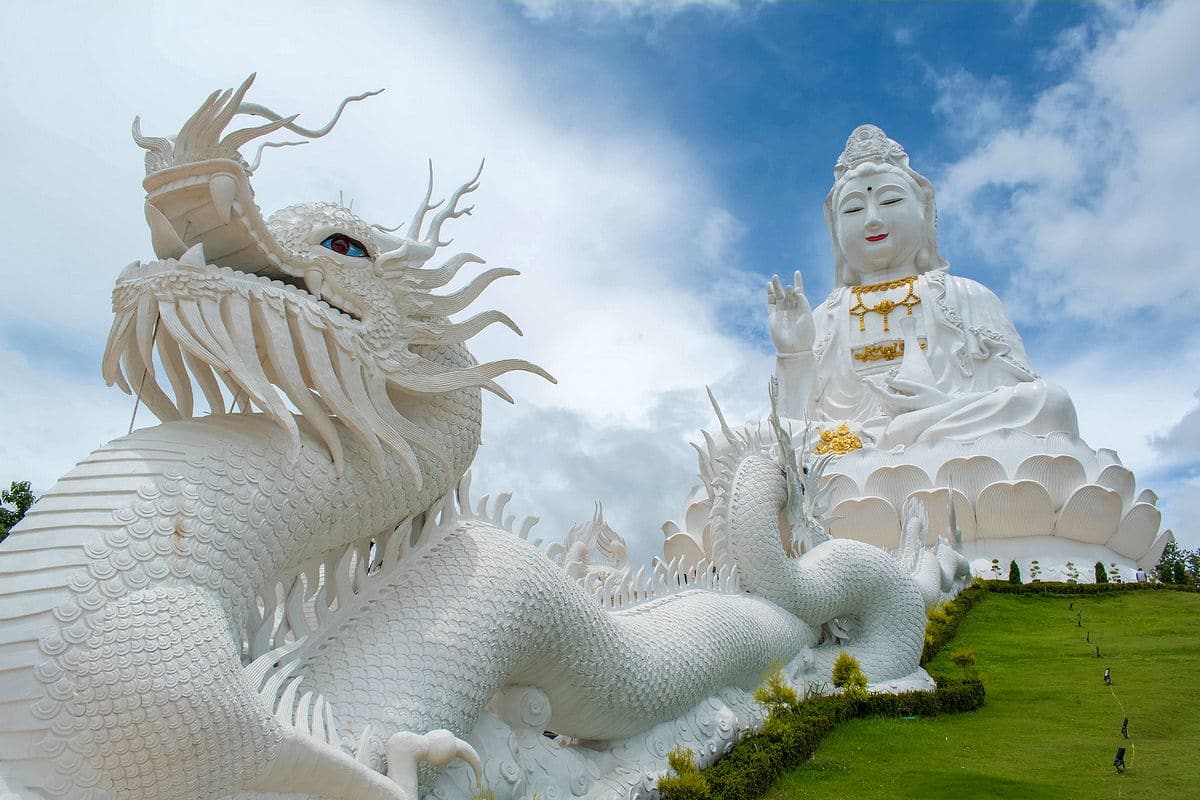
Getting closer to Goddess Guan Yin’s giant statue/temple

Climbing up the stairs…
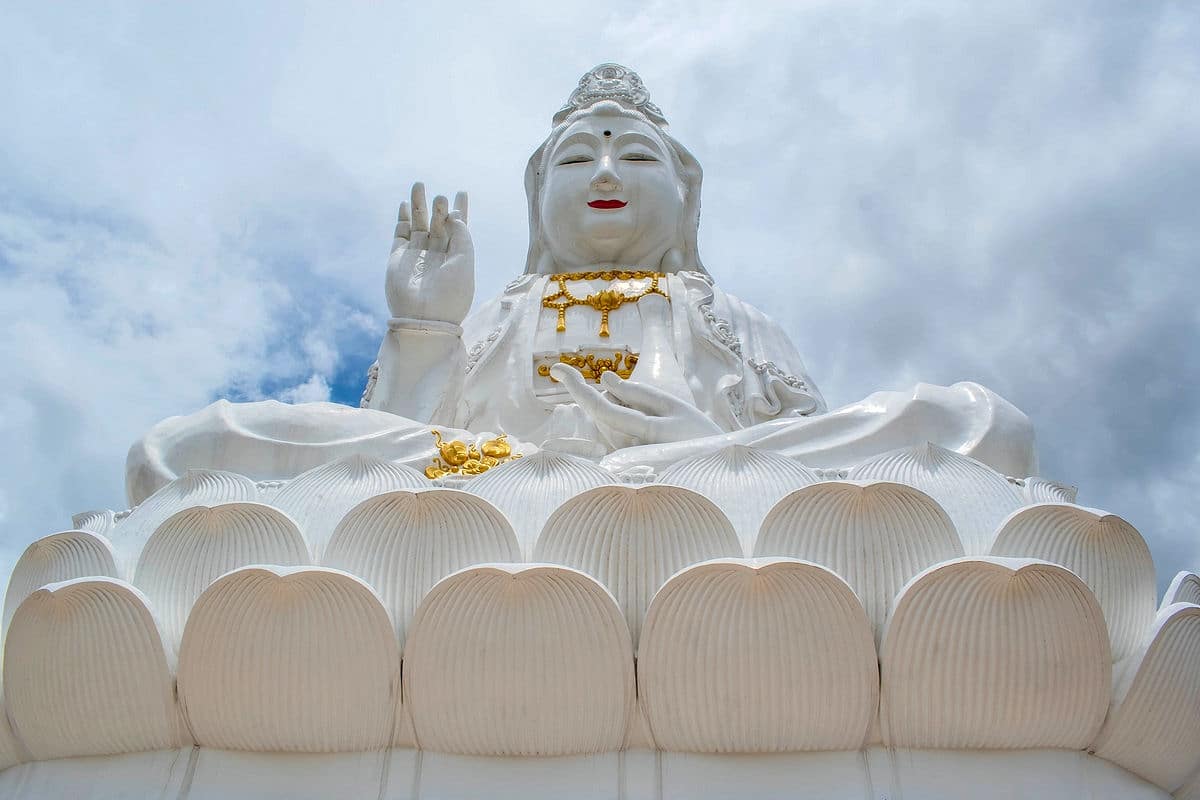
One more look up at the giant Goddess
Once I caught up with the rest of the family, we walked across the main hall to a ticketing booth. There, we paid a small entrance fee, then took one of the nearby elevators up to the head of the statue.
Inside the Head of Goddess Guan Yin
When we got off, we found ourselves in a fascinating white space. It was decorated from top to bottom with intricate sculptures of Buddha, dragon serpents, and many other creatures and deities. There were ornate trees, flowers, a panda bear sitting on a bamboo branch…all embellished by small, round, sparkling jewels.
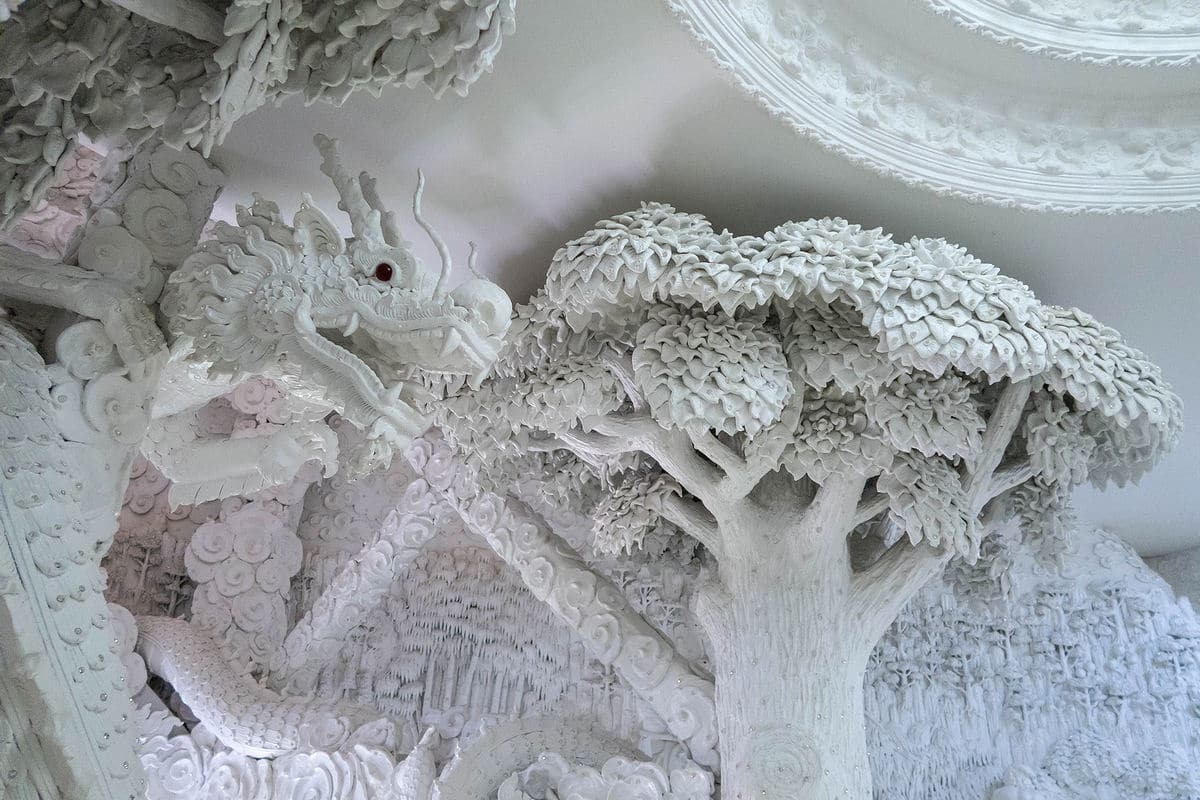
Dragon and tree sculptures inside the giant Guan Yin statue at Wat Huay Pla Kang in Chiang Rai
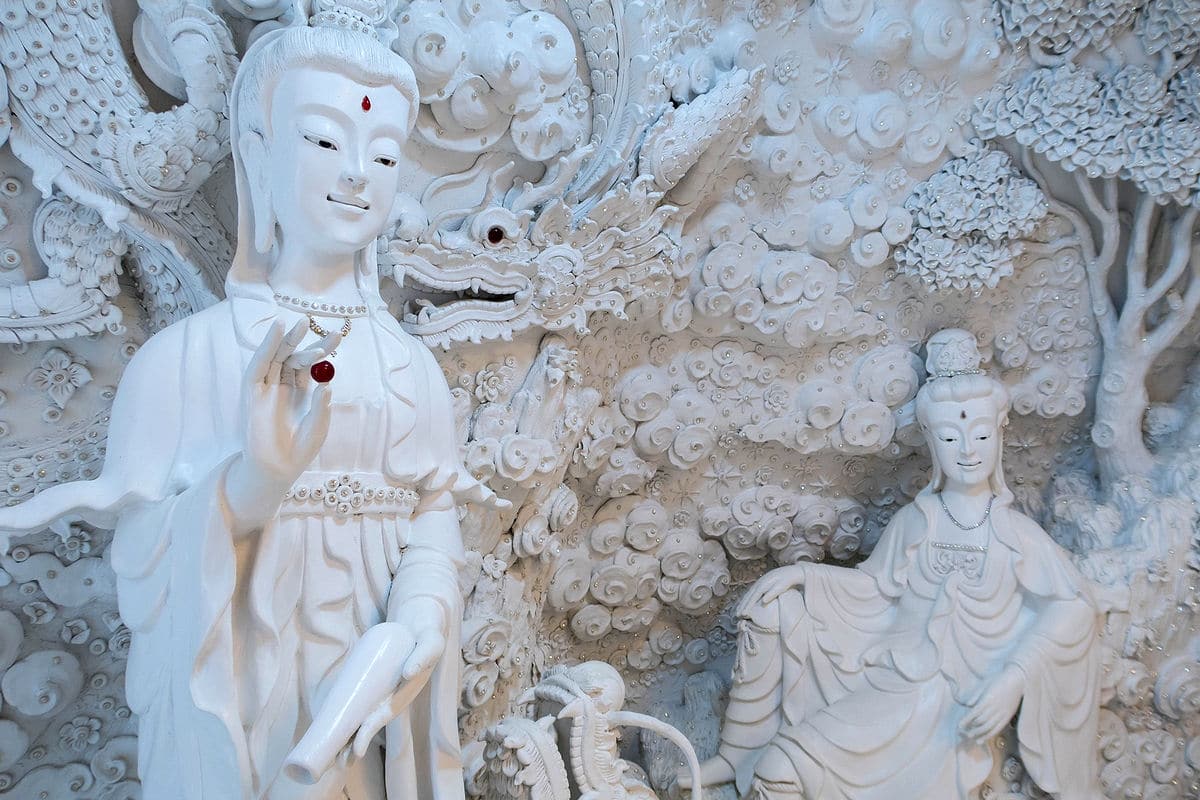
More intricate sculptures inside the giant Guanyin statue at Wat Huay Pla Kang
The space was illuminated by the light coming from the two eye openings and a smaller opening above. It represents the “third eye” or the state of enlightenment. We looked out through the openings and were amazed how high we were standing.
As we continued exploring, we discovered that behind the elevators, there was a stairwell. We figured this was the fire exit, but interestingly, there were stairs that led not only down, but also up higher. Curious, we started to climb, and in a few moments came to a second level inside the head. There, we found more ornate sculptures painted in white, and decorated with sparkling jewels.
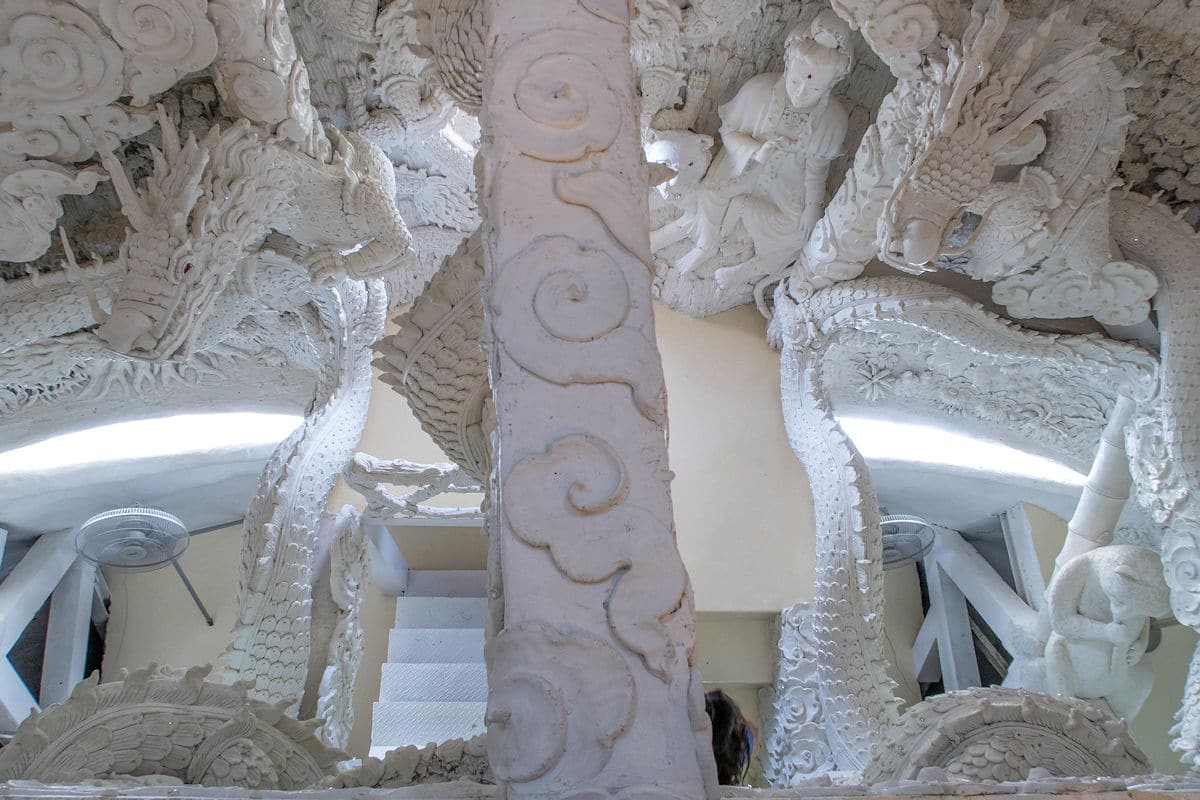
Looking down at Guan Yin’s eyes from the upper level
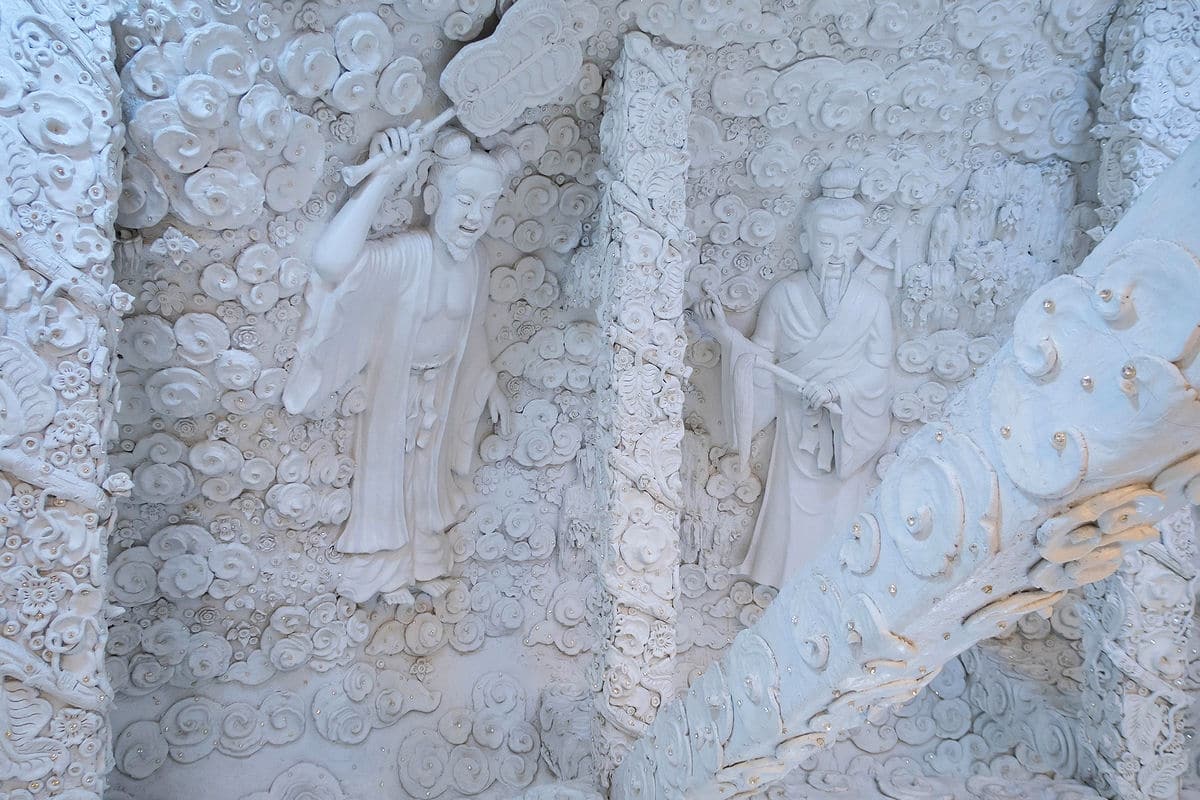
Wall decor on the second level
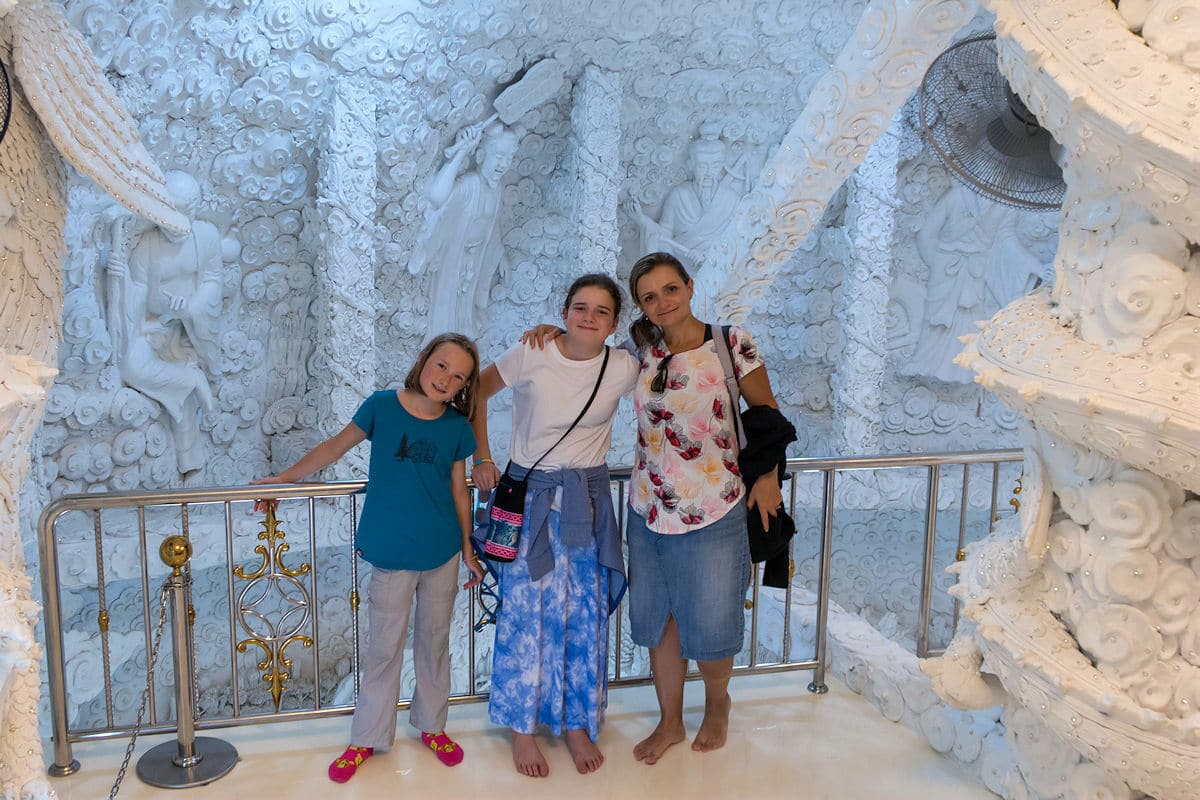
Dani, Angie, and I posing on the second level inside Goddess Guan Yin’s head
Rice for the Orphanage
After looking around for a while longer, we took the elevator back down. In the main temple hall, we found several people selling large bags of rice. Apparently, there was an orphanage nearby, so visitors could purchase a bag and donate it. I had to clarify this, since reviewers on TripAdvisor complain that locals try to sell you stuff inside the temple.
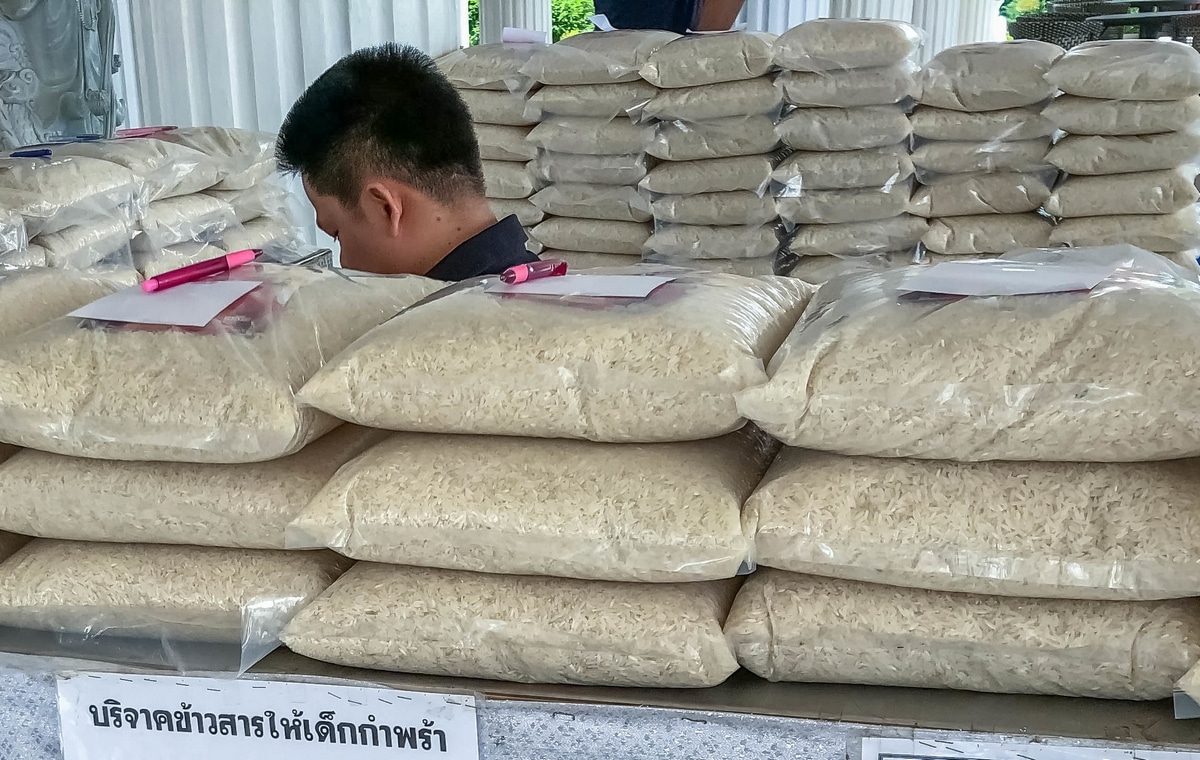
Man selling rice at Wat Huay Pla Kang in Chiang Rai
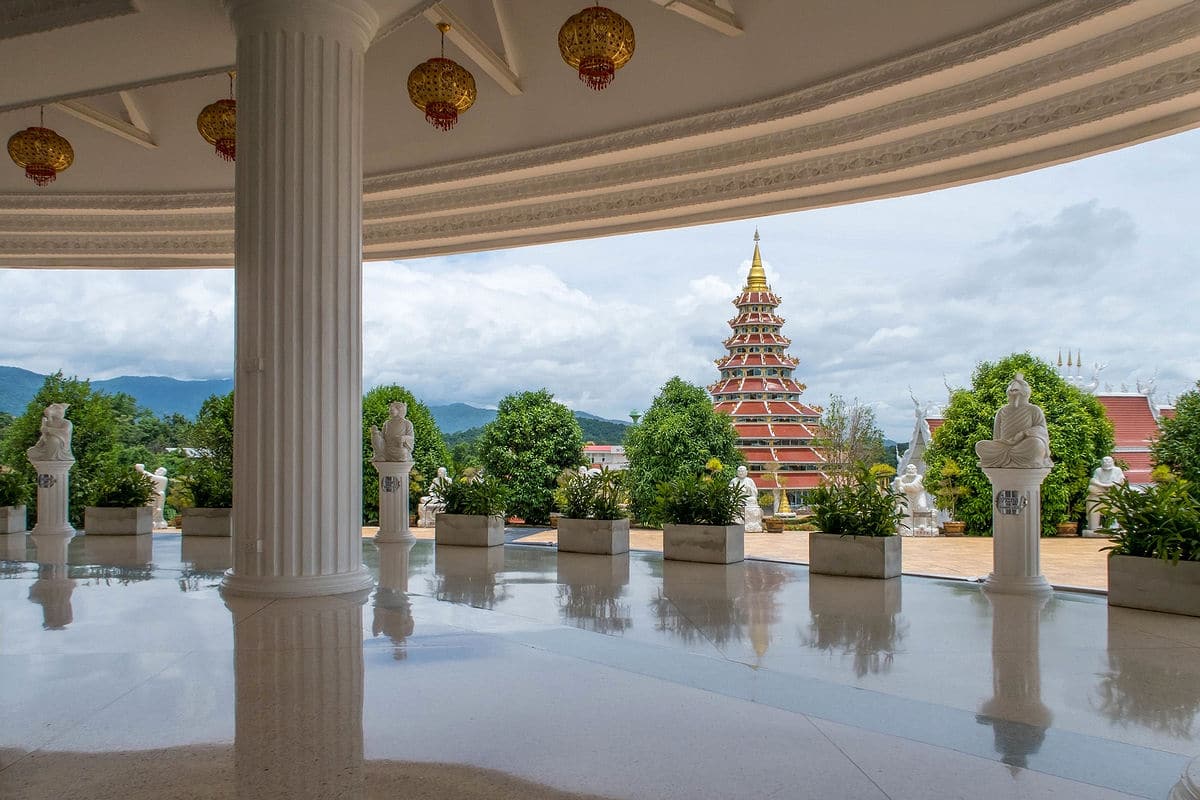
View of the Chinese pagoda from the main level of the giant Guan Yin statue
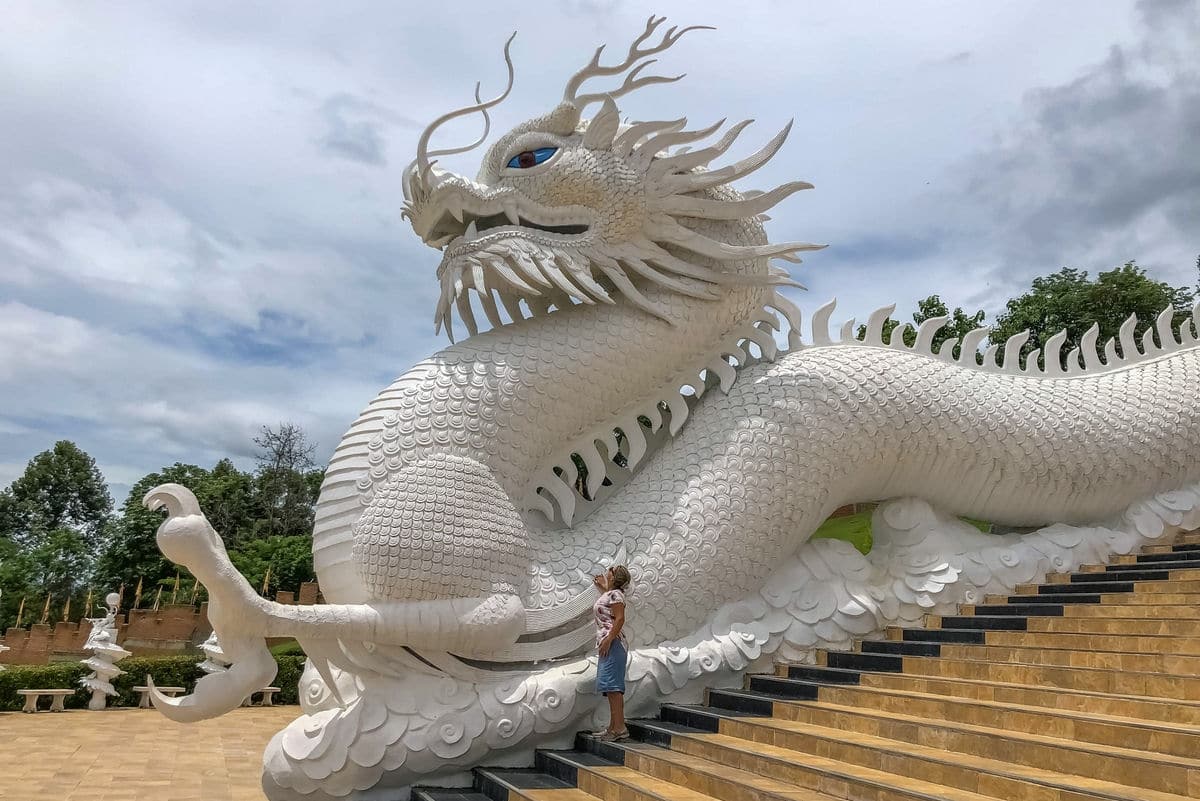
One last moment admiring the incredible white dragons in front of Guan Yin’s giant statue
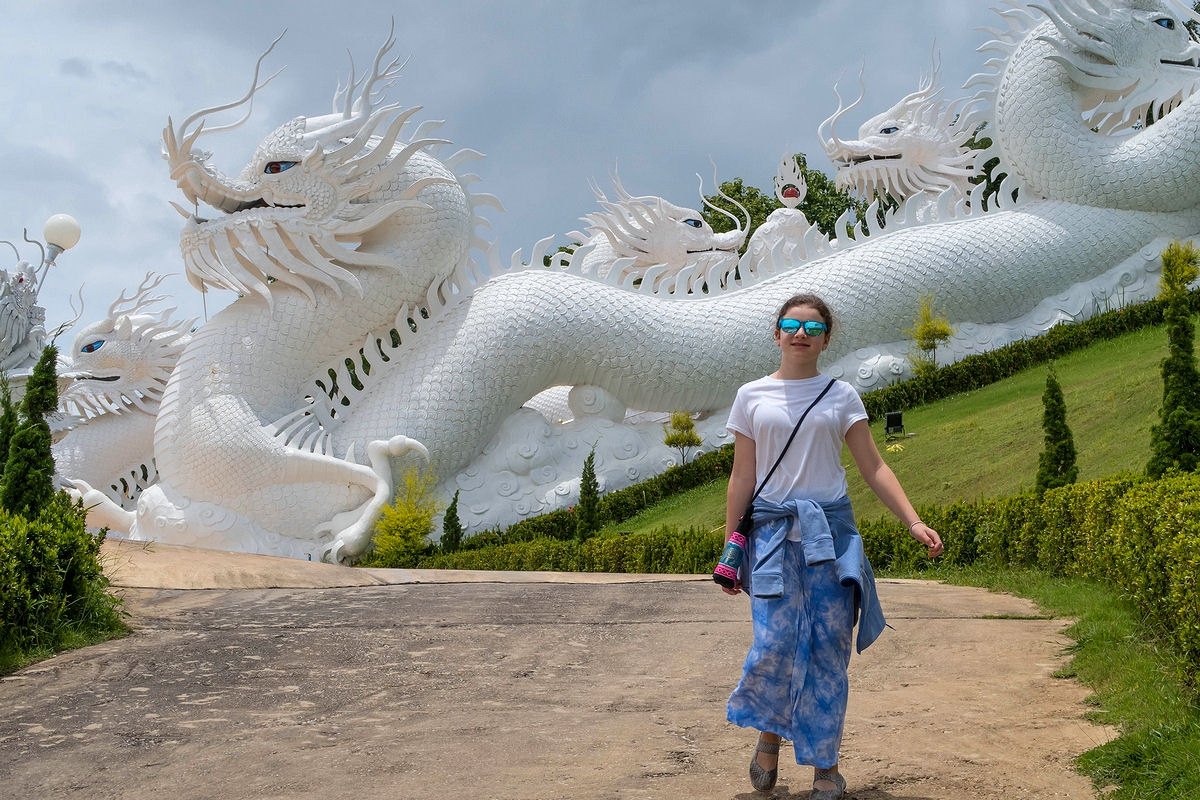
Angie strolling leisurely behind the rest of us
Lunch in Town
At this point, we realized that we had spent quite a long time at Wat Huay Pla Kang. Meanwhile, our Grab driver was still waiting for us in the parking area. Not to mention, everyone was getting rather hungry. We hurried back down the stairs and found our Grab car, but not before I took a few more photos.
For lunch, we went to a place in town called Chivit Thamma Da Coffee House, Bistro & Bar. One of the owners at our hotel had recommended it, so we definitely wanted to give it a try. When we arrived there, we got a table in the garden, overlooking the Kok River. The atmosphere was lovely and the food delicious, although not as cheap as most local places in Chiang Rai. We ordered refreshing, cold, fruit smoothies and some Thai specialties. The menu also included Western dishes, but we wanted to keep exploring the amazing flavors of the local cuisine.
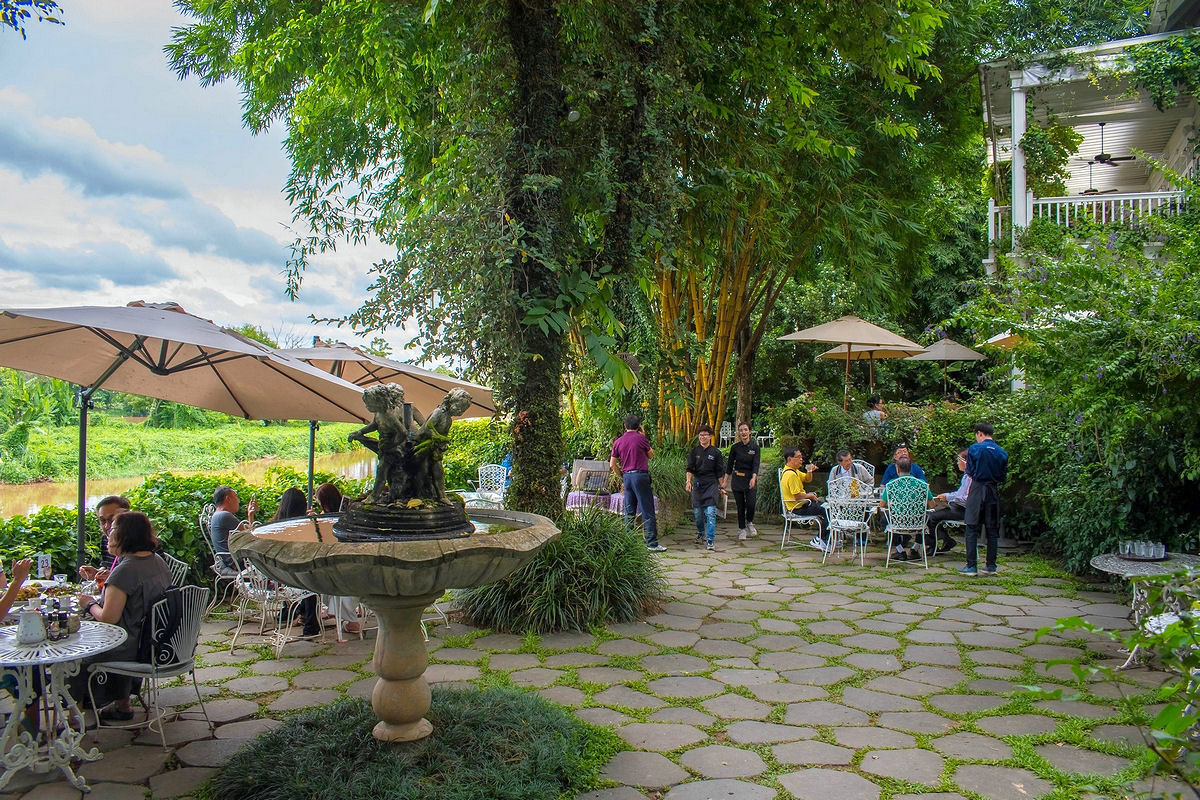
Heading towards our table in the garden at Chivit Thamma da Coffee House, Bistro, and Bar in Chiang Rai

The view of the Kok River from our table

Angie and hubby at Chivit Thamma Da
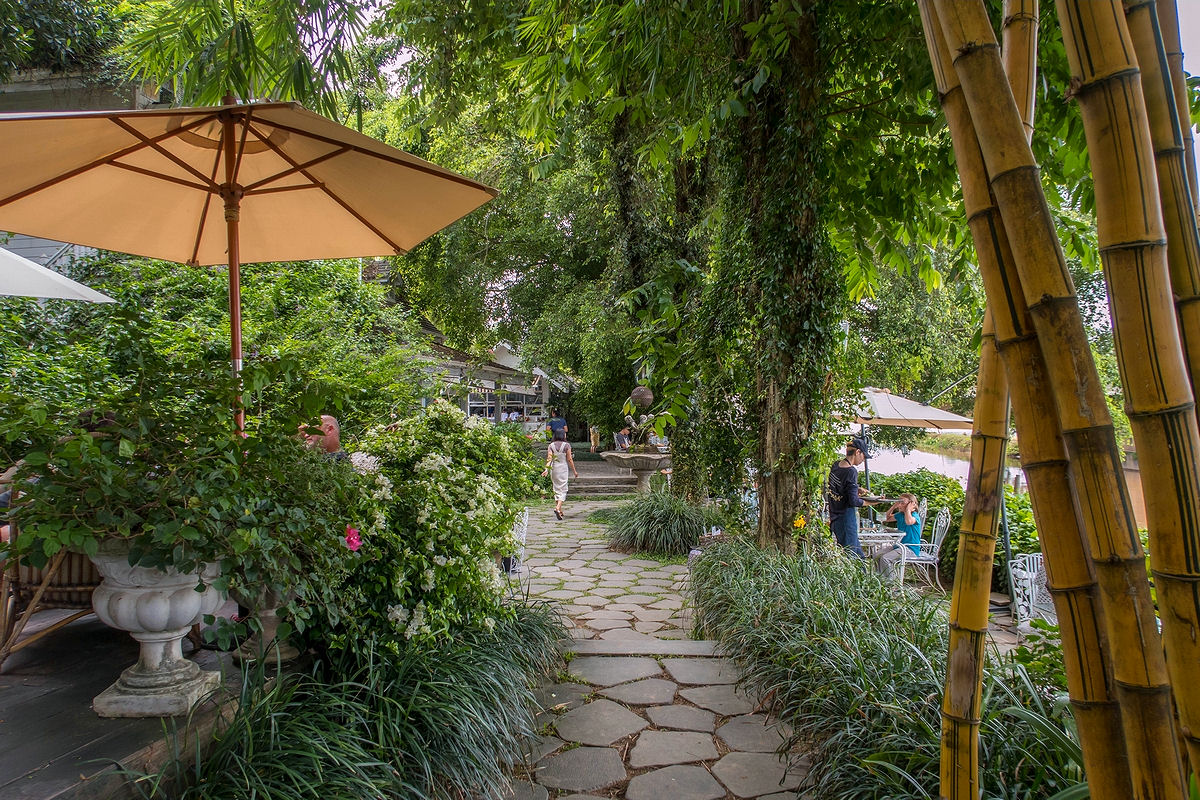
Walking around the restaurant’s garden while waiting for our food
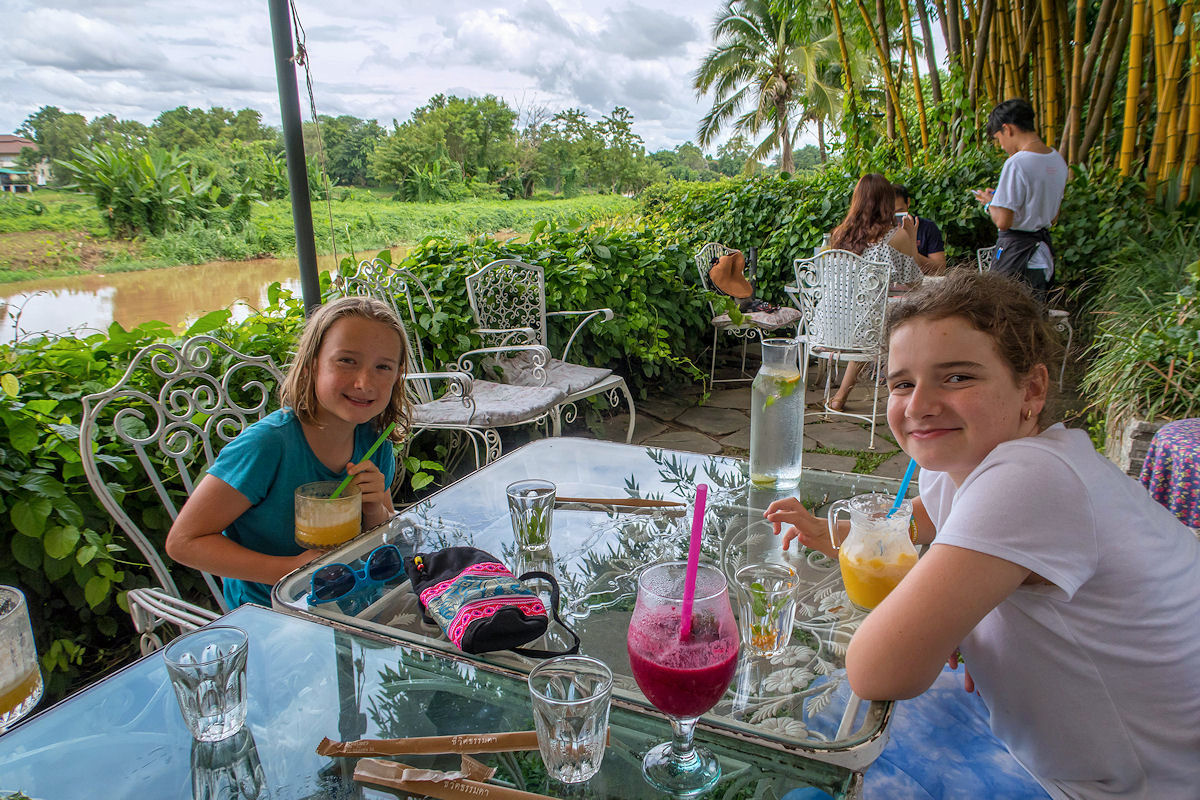
The kids enjoying their delicious smoothies
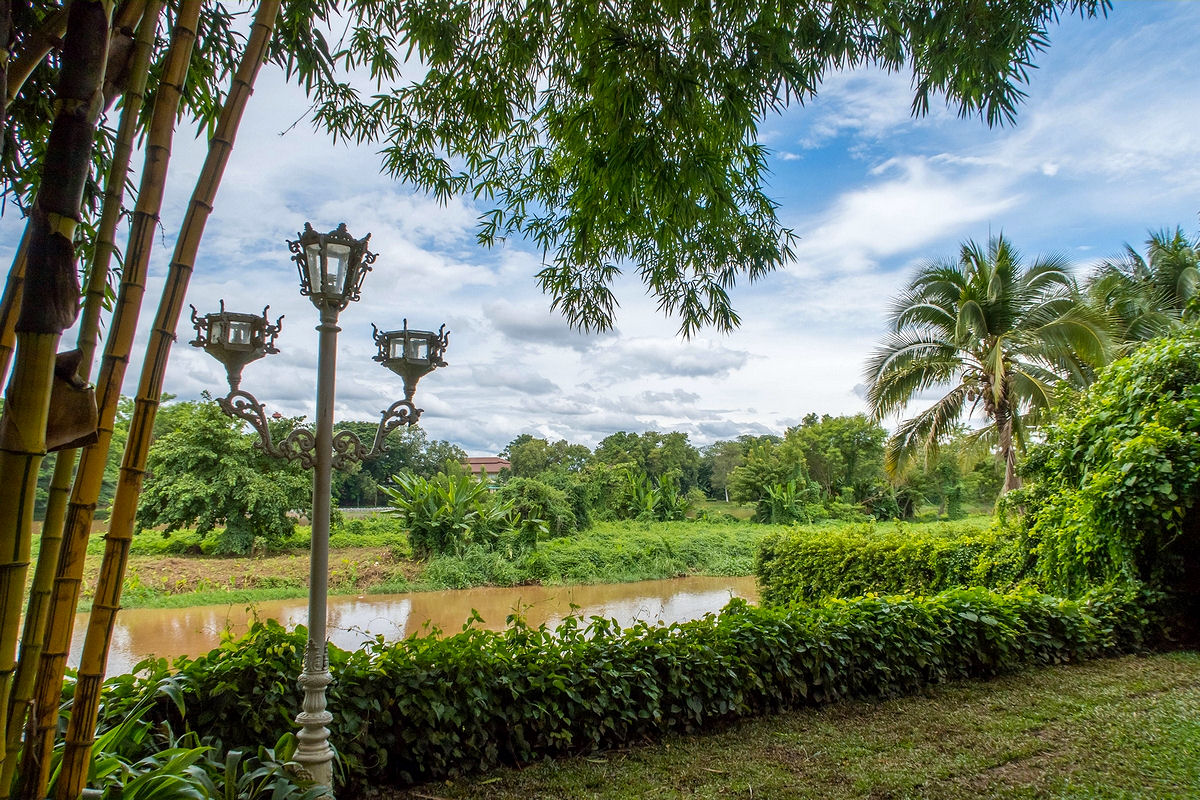
One more view of the Kok River from Chivit Thamma Da

…And one final view of the beautiful garden
Other Options
Another great restaurant to try while in town, especially if you are vegan or vegetarian, is Kunda Cafe. We didn’t have a chance to go there, but heard great things about it. It’s located close to the Chiang Rai Clock Tower and Walking Street; therefore, you can combine it with these couple of attractions. The Clock Tower was designed by Chalermchai Kositpipat, the artist of the White Temple.
Chiang Mai to Chiang Rai, One Unforgettable Adventure
After lunch at Chivit Thamma, we took another Grab car back to our hotel. We picked up our luggage, checked out, thanked the friendly staff, and headed to Chiang Rai International Airport….Before long, we were sitting inside the terminal, and our adventure in beautiful Northern Thailand was over.
As we were waiting for our flight to Phuket, I kept reminiscing about the amazing things we had experienced in this part of the country. When we first started planning our Thailand vacation, traveling from Chiang Mai to Chiang Rai wasn’t on the itinerary. In the end, we were so happy we decided to include this trip in our plans. It turned out to be one truly unforgettable adventure through enchanted temples, history, and culture!
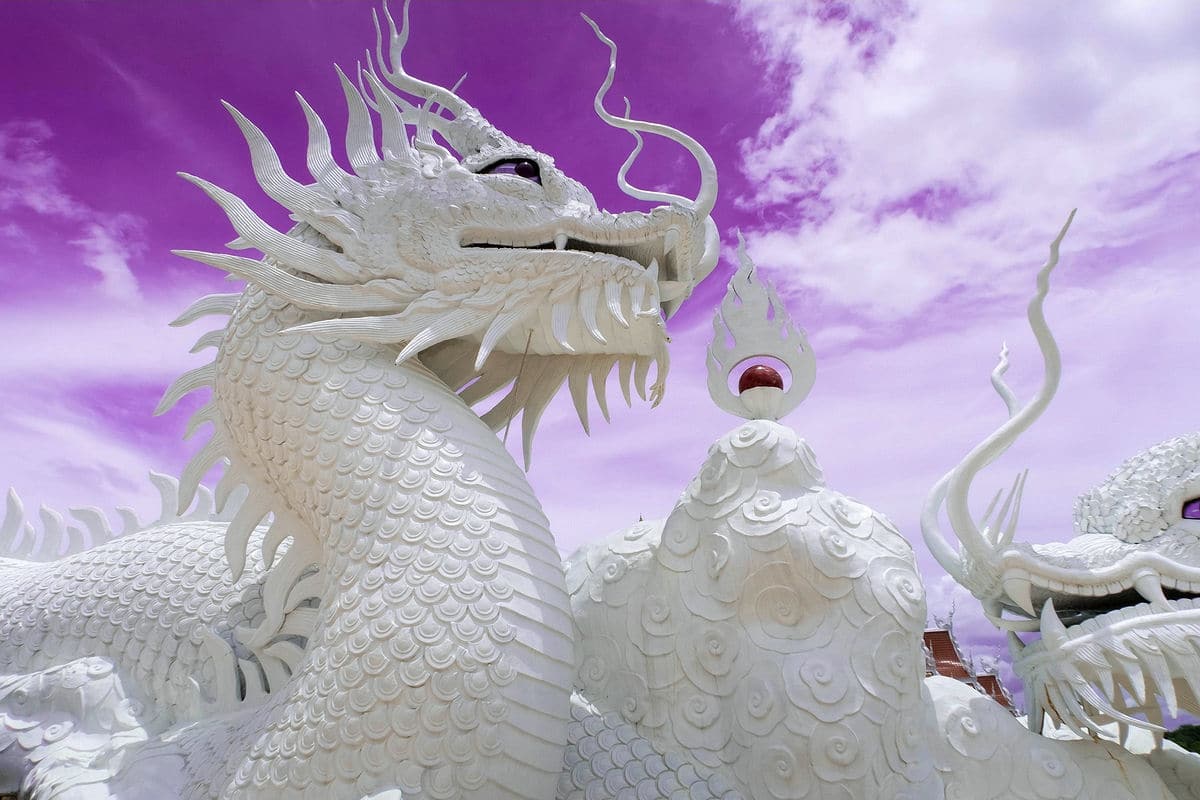
Just a little play with color in honor of our journey from Chiang Mai to Chiang Rai
IMPORTANT
When traveling abroad, make sure your passport is valid for at least 6 months AFTER your planned stay. There are many countries that follow this rule very strictly. If you show up to the airport with a passport that expires in less than 6 months, you will NOT be allowed to board your plane! Click HERE to learn more and to see the list of countries that require 6 months of remaining passport validity.
Special Thanks
We would like to thank Travel Hub Chiang Mai for planning and organizing our trip from Chiang Mai to Chiang Rai. We had an absolutely amazing time and want to be sure to mention that while this was a sponsored activity, all opinions expressed in this article are our own. Please, refer to our Disclosure Policy for more information.
Disclaimer
This post may contain affiliate links, which means that we will receive a small commission if you purchase something through these links. There is absolutely NO additional cost to you! We are affiliates of Booking.com and sincerely believe this is one of the best websites for booking accommodations. Thank you so much for choosing to use our affiliate links! These small commissions help us continue to update and run this website. 🙂
Resources to Help Plan Your Trip from Chiang Mai to Chiang Rai
- Tourism Thailand – The official website of Tourism Authority of Thailand; find information about popular destinations, experiences, and Thai culture
- Thailand Travel – Lonely Planet’s detailed guide to Thailand, which includes various destinations, activities, experiences, and more
- Website for services and restaurants featured in this article – Travel Hub Chiang Mai || Chivit Thamma Da Coffee House, Bistro & Bar || Kunda Cafe
Note: Unless otherwise indicated, the photos in this post were taken by Vessy and Cameron with a Nikon D5600 camera and iPhone X. Please send us an e-mail at vessy@feelgoodandtravel.com if you would like to use any of them. All images are subject to copyright laws.
The activities described in this article took place on August 1-2, 2019.
PIN THIS POST!
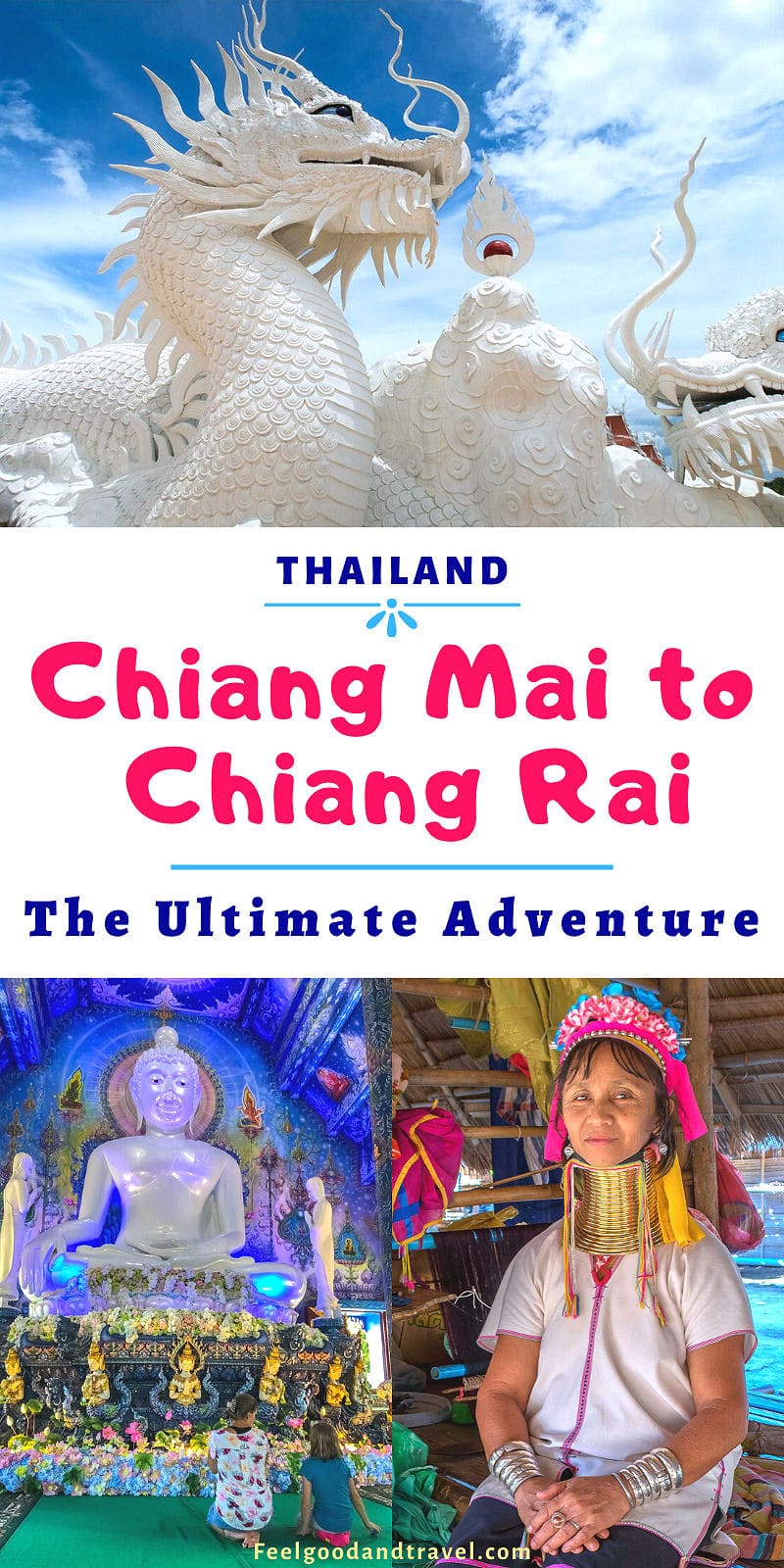
Chiang Mai to Chiang Rai Pin

32 comments
WOW!! Your photos are amazing — what a trip. The temples in Chiang Rai are so ornate and colorful, and the village with the people from Burma is fascinating. I wonder if the rings around their necks are heavy!? Very fascinating culture.
Thanks for checking it out, Heather! This trip from Chiang Mai to Chiang Rai was truly incredible. And, YES! The rings on the women’s necks are indeed very heavy! I honestly can’t imagine how they get used to wearing them all the time!
What an incredible trip from Chiang Mai to Chiang Rai! I love all the ornate photos!. Thanks for sharing all of this great information with us!
Absolutely! Thanks so much, Lee Anne! We really loved both Chiang Mai and Chiang Rai! Great places to visit while in Thailand!
Your pictures are stunning! What an amazing trip and learning experience! I really enjoyed reading this post. I’d never really considered going to Thailand. I mean, I wouldn’t turn down a trip or anything, but it really wasn’t on my radar. This makes me want to plan a trip and travel from Chiang Mai to Chiang Rai while there!
Thanks so much, Stacey! Thailand is an absolutely beautiful and fascinating country! It was at the top of our bucket list, and we had the time of our lives! Definitely consider visiting! 🙂
This road trip from Chiang Mai to Chiang Rai sounds absolutely perfect!!! Those statues look unreal! I love that you got to cook those eggs in the hot spring. We did something like that in the Azores.
Thanks for stopping by Christine. It was one unforgettable adventure! We were so glad we found the time to travel from Chiang Mai to Chiang Rai and see all these unique places! Totally worth it!
This is an incredible trip! I love the blue and white temples! I would love to travel from Chiang Mai to Chiang Rai someday!
Thank you, Lisa! It was wonderful! When you research well in advance, things are likely to go very smoothly! The Thai people are really helpful and nice!
What a fascinating experience! I so appreciate you bringing me along on your journey from Chiang Mai to Chiang Rai. I felt like I was right there with you. Especially love the stunning photos of the temples and sculptures.
Thanks so much! We really loved Chiang Mai and Chiang Rai. It’s so amazing to get to know another culture and see how people live!
The white dragons are so cool! We’re going to Vietnam and Thailand in February but bummed we won’t be near Chiang Mai and Chiang Rai. Looks amazing and thanks for the tips and contacts.
How awesome, Hera! Have a great time, then go back later to explore some of Northern Thailand…And definitely take a trip from Chiang Mai to Chiang Rai! 🙂
What an awesome post! China has been on our bucket list for quite some time, and yesterday one of our homeschool lessons was on China. Now today, I read about your trip from Chiang Mai to Chiang Rai! It looks like a sign to me! We must visit this part of the world!
Go for it, Michelle! We would also LOVE to visit China someday. Thailand was truly a wonderful place to explore, so be sure to include it in your future travel plans! 🙂
Wow, this post is so comprehensive and chock-full of great information. Thanks for sharing!
Thanks so much, Shirley! I truly enjoyed writing it and revisiting all these incredible places! Traveling from Chiang Mai to Chiang Rai was totally worth it!
Such beautiful and unique things for sure. I have never seen hot springs like that, nor did I know they could be hot enough to boil eggs. I love those mini pineapples.
Thanks so much Sheila! Yesss! These hot springs were THAT hot, and the tiny pineapples were like luxurious candy! Sooo delicious!
There are some really beautiful spots on your trip from Chiang Mai to Chiang Rai! Thailand is definitely on my family’s travel bucket list. I am saving this for later when we plan our trip there!
Thanks, Tara! You will LOVE Thailand. We are looking forward to going back for sure! 🙂
This trip from Chiang Mai to Chiang Rai looks wonderful! I have never been to Thailand, but it definitely sounds like a great experience!
Thanks for checking it out, Courtney! Thailand is awesome. There are so many incredible things to see and do not only in Chiang Mai and Chiang Rai, but all over the country!
Breathtaking! I will be adding this to my travel wish list for sure.
Thanks so much, Amanda! You will have a great time! It’s a worthwhile experience for sure!
Love all the amazing photos of the artwork and buildings. I appreciate you sharing your journey from Chiang Mai to Chiang Rai and how to get there, as well as all the stops.
It’s my great pleasure, Missy! It was such an unforgettable experience, no question! Thanks for stopping by!
Wow! Just Wow! This looks like a wonderful place to visit for the whole family! The pictures came out so beautiful. Thank you for this post!
Thank you so much, Brianna! Traveling from Chiang Mai to Chiang Rai is an amazing adventure. A lot of tourists skip Chiang Rai, but as you can see, this city has a lot to offer, especially if you are interested in temples, arts, and culture!
Your photos are amazing. I was swept along with reading this. Loved it. What an interesting country.
Thank you so much for the kind words! 🙂 This journey from Chiang Mai to Chiang Rai was quite a memorable experience, and Thailand, as a whole, is so beautiful and unique. Not to mention, the people are lovely and the food, absolutely delicious!